INSIDE: CENTURY CLUB | BOJI GROUP | TOP CORPORATE CULTURE AWARDS



































































Now in its second century, Belle Tire in Allen Park is expanding into Chicago, all the while applying the original formula of low prices and friendly service.







Now in its second century, Belle Tire in Allen is into all the while applying the original formula of low prices and service.











March/april 2023 BEllE TirE cENTUrY clUB | TOp cOrpOraTE cUlTUrE aWarDS VOlUME 18 | iSSUE 2
Da e
March/April 2023 dbusiness.com
i

This Digital Edition of DBusiness Magazine is brought to you by





































Jaffe, Raitt, Heuer & Weiss, P.C. / Taft




































HEALTHY SMILES = HAPPY EMPLOYEES


A healthier workforce means happier employees, improved morale, increased productivity and lower health care costs.


Thank you for making Delta Dental of Michigan the top choice for dental benefits.



























































































































H O U R D E T R O I T ' S Buy tickets now For sponsorship inquiries, contact advertising@hour-media.com or 248-268-8026 General Admission 7p-11p $95 VIP 6p-11p $155 1114 Washington Blvd, Detroit 6.2.23 the winner 's circle celebration of Detroit's best Westin Book Cadillac Best of Detroit

CONTENTS
39 Century Club 46 Space Constraints 52 Retail is Detail 58 Son Rise
FOCUS: How local retailers of chocolates, sodas, hats, and trophies, along with an institute of higher education, Walsh College in Troy, have made their mark for more than a century.
By Bill Dow
PERSPECTIVES: Hybrid work schedules, evolving demand for office space, and higher interest rates are giving life to alternative uses for commercial skyscrapers in Detroit and the suburbs.
By Dale Buss
Starting small in 1922, Belle Tire grew throughout metro Detroit before moving into Toledo and Indianapolis. Now in its second century, the company is expanding into Chicago, all while applying the original formula of low prices and friendly service.
 By Ronald Ahrens
By Ronald Ahrens
After watching his father acquire an office building in Lansing, Ron Boji took the reins of the business and helped build it into a multifaceted enterprise that today generates $500 million in annual revenue.
By Dan Calabrese
64 Cultural Revolution
Winners of the second DBusiness Corporate Culture Awards are staying ahead of the business trends affecting employees and their work experiences. Plus, the mentor champion, Ethan Gross.
By Tim Keenan
03-04.22
14 DBUSINESS || March - april 2023 52
JOSH SCOTT
86,500 square feet of remodeled space



State-of-the-art Crestron® sound system
Vibrant “lake effect” design theme
New air walls and LED lighting
Private meeting planner office

All-new digital signage
MEETINGS MODERNIZED
New look, long history. For over 30 years, Grand Traverse Resort and Spa has been Northern Michigan’s premier meeting destination. With our nearly $3 million renovation, including upgraded technology, services, and design, we’re bringing the future of meetings to life. Learn more at grandtraverseresort.com/meet.

Owned and Operated by the Grand Traverse Band of Ottawa and Chippewa Indians

Commentary
Foreword The Ticker

25 BREAKOUT SERVICE The hotel industry is beginning to rebound from the COVID-19 pandemic, but the market today is different than it was three years ago. 26 REVERSE COURSE If political leaders fail to improve the state’s ability to attract and retain residents, employers will have a hard time finding workers, and the economy will continue to sputter and underperform. 26 SMART POWER One source of power that’s often overlooked but harnesses the abundance of heat beneath the Earth’s surface is geothermal energy. 28 COMPENDIUM How outsiders view Detroit. 20 LETTER FROM THE EDITOR 20 READERS’ LETTERS 22 CONTRIBUTORS 32 WORKPLACE UPGRADE Adding the latest features can make or break employee engagement. By R.J. King 33 DIGITAL DIRECT Property Muse in Detroit simplifies single-family home investing and management. By Jake Bekemeyer 33 MENTAL PIVOT Start My Wellness has moved to Ferndale and added a focus on helping other health care professionals manage their practices. By Tim Keenan 34 CORNER BET Online sports betting rises in Michigan as wagers at casinos decline. By Dan Calabrese 34 PDA Q&A Scott Idle, CEO of Sidle Entertainment in Detroit. By R.J. King
03-04.22 CONTENTS 36 STATE OF SPEED A local collector bought 30 Ford GT chassis to turn them into racecars. By Jake Bekemeyer 36 BATTERY POWER General Motors has invested $650 million in a Canadian company to develop a domestic source of lithium for EV batteries that could produce material for 1 million EVs annually. By Tim Keenan 33 NICK HAGEN 16 DBUSINESS || March - april 2023






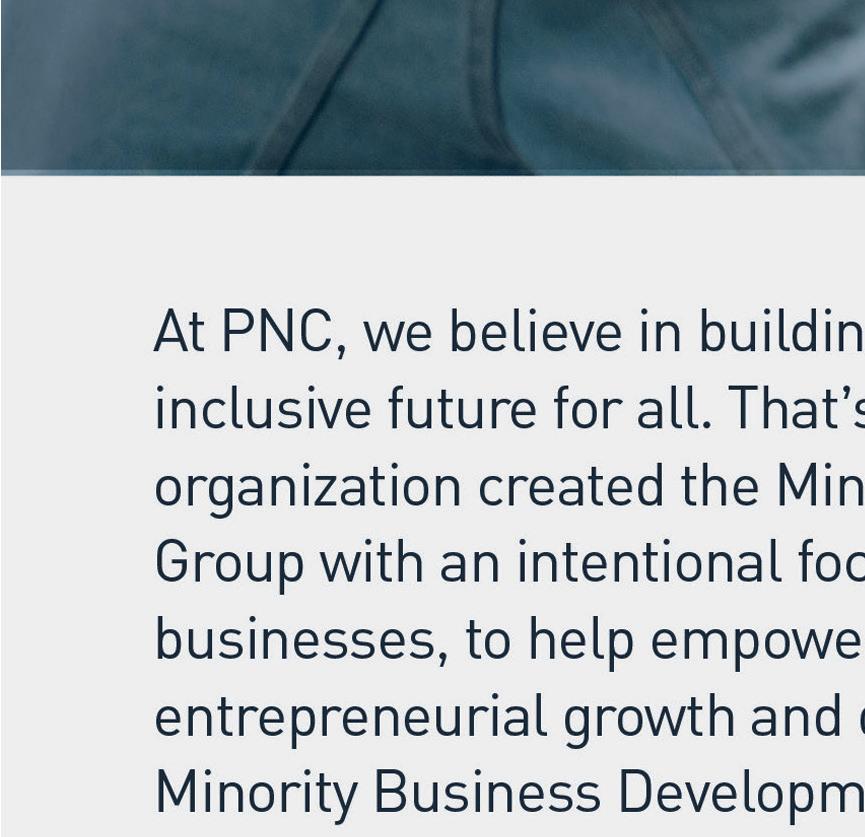




 By
By
Let’s Toast: When Detroit inventor George J. Schneider was granted a patent in 1906 for the forerunner of today’s pop-up toaster, he ignited a frenzy among manufacturers.

03-04.22 CONTENTS 71 DIGITAL FASHION
business professional on camera to comfy casual below the frame. Styled
Lauwers
RETURN ON INVESTMENT Grit and
Gocha Hawkins grew up in an abusive household on Detroit’s west side and spent two years in prison for selling drugs before making it big in the cosmetolo-
business — and now, the restaurant industry.
PRODUCTION RUN
From
by Stacy
74
Drive:
gy
By Tom Murray 78
Prime Roast: Biggby Coffee in Lansing continues to expand nationwide, unafraid of competing with Starbucks.
Tim Keenan 80 PATENTS AND INVENTIONS
commercial real estate
By Norm Sinclair 82 OPINION Hire Ground: How industry professionals can advance their hiring programs during the
talent crunch.
THE CIRCUIT
party pics from exclusive events. 86 FROM THE TOP Top Undergraduate Business Schools in Metro Detroit, Top Graduate Business Schools in Metro Detroit, Top 20 Home Builders in Metro Detroit, Top 10 Mortgage Lenders in Metro Detroit, and Top Circuit Court Judges. 90 CLOSING BELL
a Dill:
Vlasic used cheesy
to help transform
family’s company, Vlasic Foods Inc., into a premium national brand.
Ahrens
Et Cetera ON THE COVER
By Andy Gutman 84
Our
Let’s Make
Bob
humor
his
By Ronald
Exec Life
71 MARTIN VECCHIO 18 DBUSINESS || March - april 2023
Photo
by Josh Scott












Second Edition
Acentury ago, the three Book brothers sought to fashion Washington Boulevard in downtown Detroit after Fifth Avenue in New York City.
As developers of the Book Tower, Book Building, and the Book Cadillac Hotel, the trio was able to attract popular stores like Saks Fifth Avenue to Detroit. The retail establishments were joined by stately residential buildings such as the Stevens, named for Michigan’s first governor, Stevens T. Mason, and to the north, overlooking Grand Circus Park, the Statler Hotel and David Whitney Building.
At the end of World War II, as developers began constructing homes and shopping malls in the suburbs, Washington Boulevard — like much of the central business district — underwent a steady and slow decline.
By the 1980s, the urban enclave was akin to a ghost town. Many hotels were boarded up, office buildings were shuttered, and a few restaurants hung on for dear life.
While some, like former Detroit Mayor Kwame Kilpatrick, had called for all “the old dinosaur buildings” to be demolished, historic preservationists saw opportunity. Although not every building was saved when the downtown district underwent a revival some 25 years ago, the “Book” structures made it through.
In fact, the redevelopment of what is now the Westin Book Cadillac Hotel, completed in 2008, is undergoing a third transformation, this time a $20-million renovation to include refurbished guest rooms and suites; upgraded public areas and a redesigned Motor Bar, which was original to the hotel when it opened in 1924; new workout facilities; and the upcoming Sullivan’s Steak House, which will replace Roast restaurant.
John Ferchill, the Cleveland-based developer who transformed the forlorn Book Cadillac into an upscale hotel and luxury condominiums, says he’s always believed the next surge of revitalization was bound to happen.
“Look, Detroit has a collection of outstanding, historically significant buildings, and we had a lot of confidence the Book Cadillac could be redone, since we had success bringing back older structures across the Midwest,” Ferchill says. “But with its 22 layers of financing, a clouded title, and the state of the building’s decline, we had our hands full.”
Working with George Jackson, then president and CEO of the Detroit Economic Growth Corp., Ferchill and his team completed what many — including the late A. Alfred Taubman, founder and chairman of Taubman Centers Inc., who had developed the largest portfolio of luxury shopping malls in the country — had deemed impossible.

“When we had our grand-opening ceremony, Al Taubman shook my hand and said this would have never happened in Detroit because the development community was so competitive,” Ferchill recalls. “But I had two things going for me — no one in Detroit knew who I was, so I had a clean slate coming in; plus, I knew how to use conservation easements that other developers didn’t know about.”
Though it took time, the Book Cadillac, now owned by Oxford Capital Group, helped spur the transformation of the other “Book” — the combined Book Tower and Book Building — that Dan Gilbert’s Bedrock real estate arm has restored to its original grandeur.
Erected between 1916 and 1926 by Frank, Herbert, and J.B. Book, the combined 484,000-squarefoot structure will include a Roost Hotel, offices, residences, a rooftop bar, event space, and stores and restaurants.
“Washington Boulevard is really starting to come around,” Ferchill says. “I’m glad we got the Book Cadillac done. It set the stage for so many other projects.”
IDEA EXCHANGE








I wanted to write and say thank you for the article about my patents (Jan./ Feb. 2023). I sent it to a dean I know at Dartmouth, who always looked at me as being different, especially when I talked about my patents and products. Here’s what he said about DBusiness: “You’re lucky to have a magazine full of business information and consistent information on Detroit.” And I replied: “That’s why I read the magazine.”
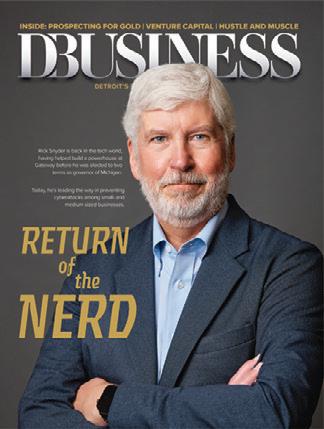 Frank Venegas Jr. Detroit
Frank Venegas Jr. Detroit
SILVER AND GOLD
Thanks for your article on the Back Forty controversy. You do an amazing job of highlighting the key issues and players in the conflict. Congratulations on a fantastic piece of writing.
Al Gedicks La Crosse, Wis.
HEART SMART
I just wanted to say thank you for running the article announcing my appointment as chairman of the American Heart Association’s 2023 Detroit Heart Challenge in DBusiness Daily News. I really appreciate it. It’s a great cause and I’m proud to be part of it!
David J. Mannarino Southfield
EMAIL US AT: editorial@dbusiness.com SEND MAIL TO: Letters, DBusiness magazine, 5750 New King Drive, Ste. 100, Troy, MI 48098 Please include your city of residence and daytime phone number. We reserve the right to edit letters for length and content.
Letters 20 DBUSINESS || March - april 2023
R.J. King rjking@dbusiness.com
ton Detroit New Tower, Book was stores to lishments as the Stevens, governor, north, R.J. KING









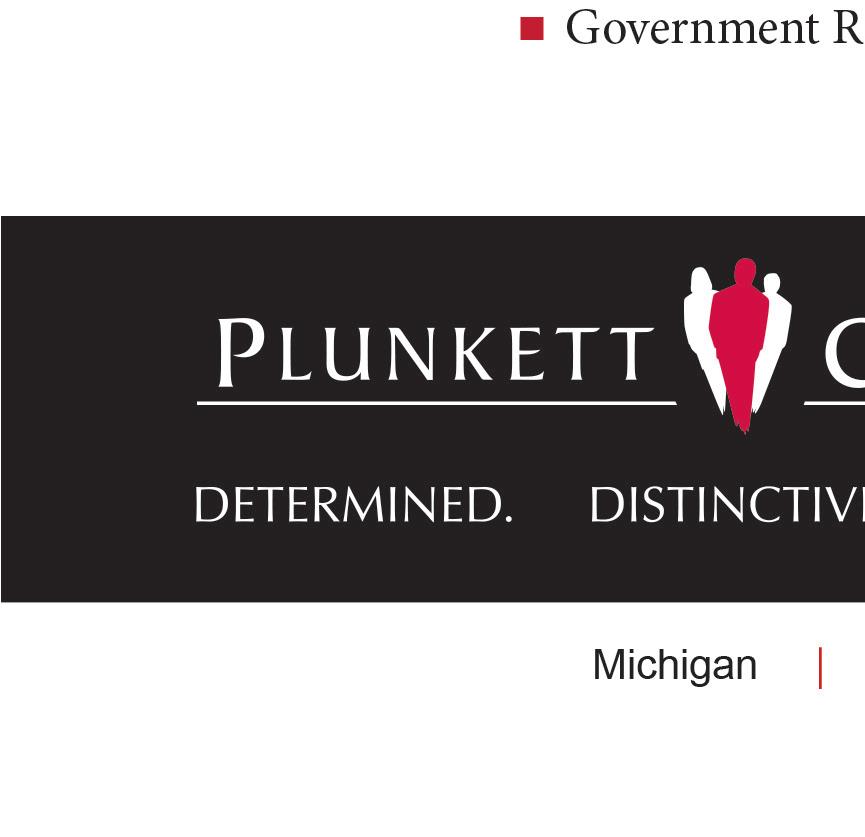


CONTRIBUTORS
DETROIT’S PREMIER BUSINESS JOURNAL
VOLUME 18 • ISSUE 2
PUBLISHER Jason Hosko
EDITORIAL EDITOR R.J. King
MANAGING EDITOR Tim Keenan

ASSOCIATE EDITOR Jake Bekemeyer
COPY EDITOR Anne Berry Daugherty
Tom Murray has been a regular contributor to DBusiness for several years. He began his career in print, then made an unplanned turn to broadcast television, where he was an award-winning anchor and reporter for three decades, covering everything from sports to fine wine and true crime. His work for DBusiness is a return to his early aspirations in the business world: As a kid growing up in his native New York, Murray’s regular summer job through high school and college was on the floor of the stock exchange. In this issue, Murray is the author of the Return on Investment feature about Gocha Hawkins’ Breakfast Bar.

CONTRIBUTION: Writer, Return on Investment | SEE IT HERE: Page 74
STACY LAUWERS
Stacy Lauwers started her career in Detroit with her own women’s fashion line, and now lives and works as a wardrobe stylist in Detroit and Los Angeles. For more than 20 years, she’s been in demand for photo shoots, commercials, and promotions for the likes of Cobra Kai, the NFL, Progressive Insurance, and several auto manufacturers. Her favorite styling projects include those that involve fashion, comedy pieces, and flashbacks to past eras. Her hobbies include collecting art and vintage mod furniture, playing bass guitar, cruising in one of her ’70s-era Firebirds, spending time with loved ones, and seeing live music or stand-up comedy. She loves dogs and is especially fond of her Bernedoodle, Mitzi.
CONTRIBUTION: Stylist, Exec Life Spring Fashion | SEE IT HERE: Page 71
TOM MURRAY JOSH SCOTT
Josh Scott is a self-taught Detroit-based photographer who specializes in editorial, portraiture, automotive, and product photography. His passion is “creating beautiful and thought-provoking work.” His work has been seen in Hour Detroit, DBusiness, Metro Detroit Weddings, Road & Track, and AutoWeek magazines, as well as the University of Michigan’s LSA Magazine for alumni. He has owned his own photography business since 2012, and his non-editorial clients include Ford Motor Co. and Hagerty. Between 2002 and 2012, he was a freelancer who acted as a photographer, assistant photographer, location scout, and producer. In this issue, Scott photographed Belle Tire Owner and President Donald Barnes III and CEO Jack Lawless at the company’s Allen Park headquarters.
CONTRIBUTION: Photographer, Retail is Detail | SEE IT HERE: Page 52
DESIGN
CREATIVE DIRECTOR Lindsay Richards
ART DIRECTOR Justin Stenson
SENIOR PRODUCTION ARTIST Stephanie Daniel
JUNIOR ART DIRECTOR Steven Prokuda
ADVERTISING SALES
ACCOUNT EXECUTIVES Cynthia Barnhart, Regan Blissett, Karli Brown, Maya Gossett, Donna Kassab, Lisa LaBelle, Haylee Mozug, Mary Pantely and Associates, Jessica VanDerMoss
PRODUCTION
PRODUCTION DIRECTOR Jenine Knox
SENIOR PRODUCTION COORDINATOR Jill Berry
PRODUCTION ARTIST Jonathan Boedecker
ADVERTISING COORDINATOR Amanda Kozlowski, GRAPHIC DESIGNERS Jim Bibart, Kathryn Dave
WEB
DIGITAL DIRECTOR Nick Britsky
DIGITAL DEVELOPMENT MANAGER Matt Cappo
DIGITAL DEVELOPMENT SPECIALISTS Jim Bowser, Marissa Jacklyn, Luanne Lim, Kevin Pelll
VIDEO EDITOR Taylor Lutz
VIDEO PRODUCER Nicole Toporowski
DIGITAL STRATEGY MANAGER Travis Cleveland
DIGITAL MEDIA ASSISTANT Robyn Banks
IT
IT DIRECTOR Jeremy Leland
CIRCULATION
DIRECTOR OF AUDIENCE DEVELOPMENT Geralyn Wilson
CIRCULATION MANAGER Riley Meyers
CIRCULATION COORDINATORS David Benvenuto, Cathy Krajenke, Rachel Moulden, Michele Wold
MARKETING AND EVENTS
MARKETING AND EVENTS MANAGER Jodie Svagr
COMMUNICATIONS AND EVENTS LEAD Cathleen Francois
MARKETING AND EVENTS COORDINATOR Jaime Presnail
MARKET RESEARCH
MARKETING RESEARCH DIRECTOR Sofia Shevin

MARKETING RESEARCH COORDINATORS Georgia Iden, Kristin Mingo
MARKETING SALES COORDINATOR Alex Thompson
MARKETING RESEARCH ASSISTANT Alyssa Fueri
JUNIOR GRAPHIC DESIGNER Alexa Dyer
BUSINESS CEO Stefan Wanczyk
PRESIDENT John Balardo
DIRECTOR OF BUSINESS OPERATIONS Kathie Gorecki
PUBLISHING AND SALES COORDINATOR Mikala Bart
ASSISTANT OFFICE MANAGER Natasha Bajju
SENIOR ACCOUNTING ASSOCIATE Andrew Kotzian
ACCOUNTING ASSOCIATES Sammi Dick, Austin Schmelzle
DISTRIBUTION Target Distribution, Troy
Postmaster: Send address changes to DBusiness, 5750 New King Drive, Ste. 100, Troy, MI 48098
For advertising inquiries: 248-691-1800, ext. 126
CONTRIBUTING WRITERS
Ronald Ahrens, Dale Buss, Dan Calabrese, Bill Dow, Andy Gutman, Tom Murray, Norm Sinclair
CONTRIBUTING ARTISTS
Patrick Gloria, Nick Hagen, Matthew LaVere, Josh Scott, Martin Vecchio, James Yang
To sell DBusiness magazine or for subscription inquiries: 248-588-1851
DBusiness is published by Hour Media. Copyright © 2023 Hour Media. All rights reserved. Reproduction in whole or in part without permission is prohibited. DBusiness is a registered trademark of Hour Media.
Contributors 22 DBUSINESS || March - april 2023




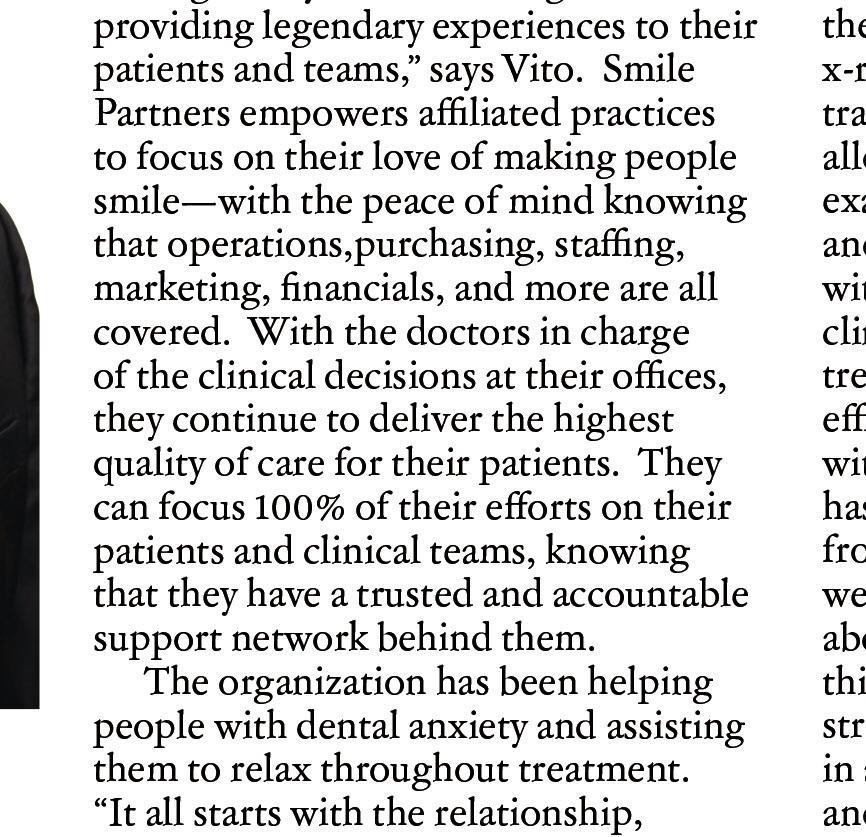
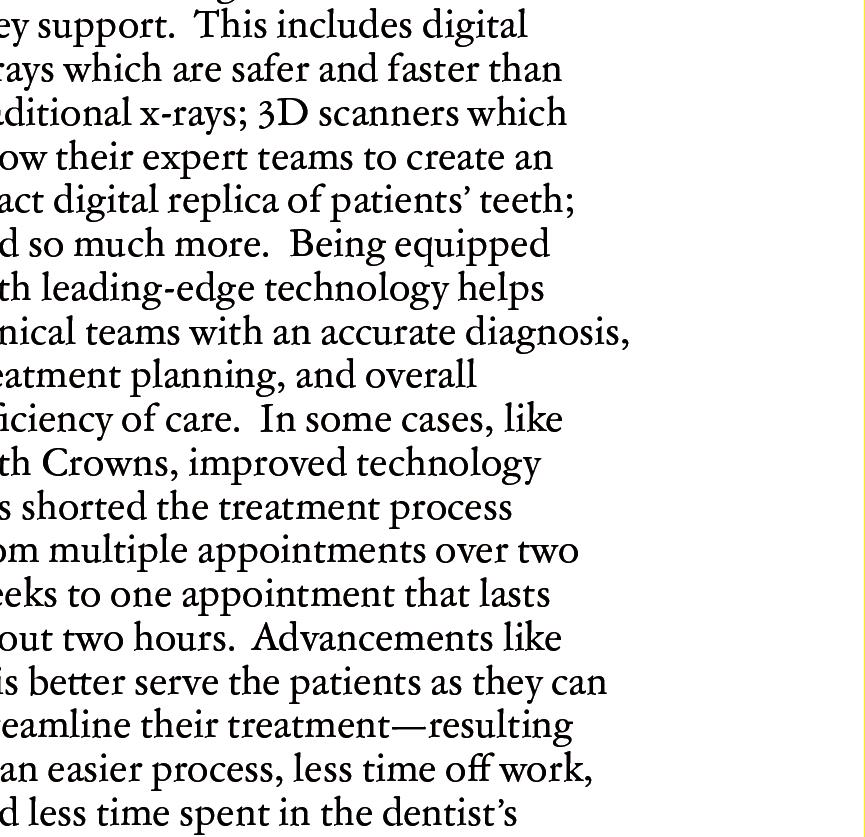



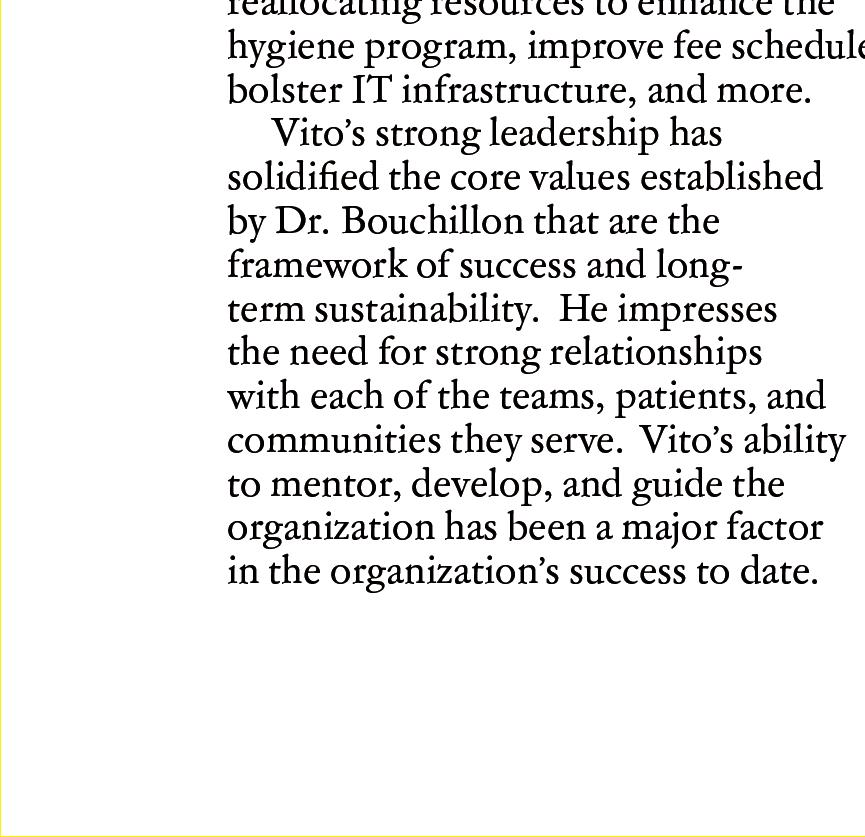
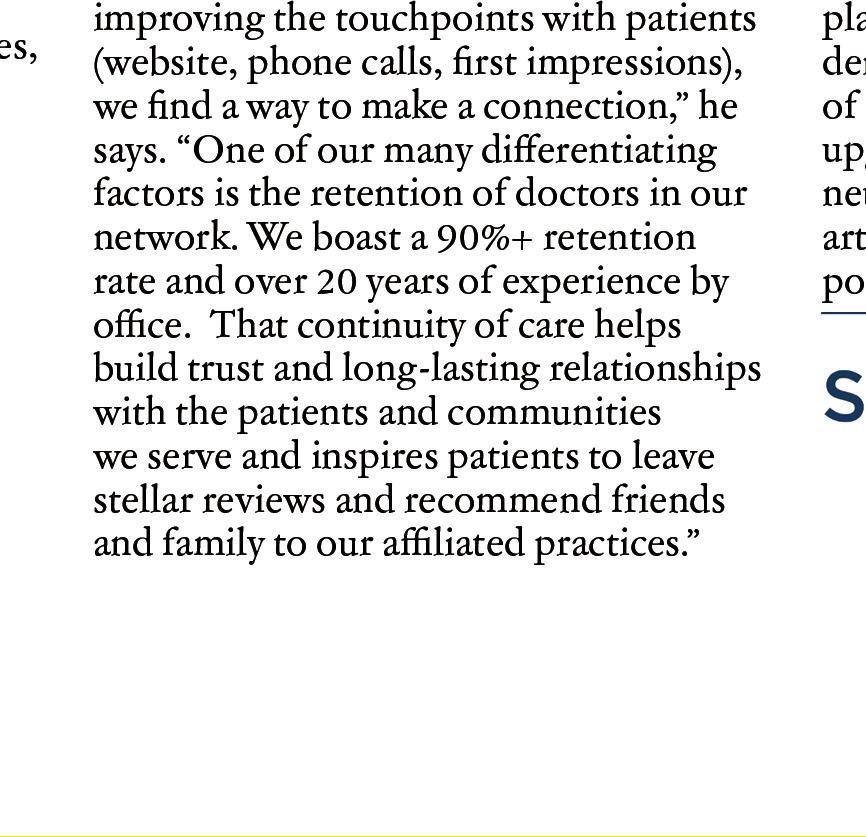














03-04.22 COMMENTARY 26
THE SECRET OF HAPPINESS IS VARIETY, BUT THE SECRET OF VARIETY, LIKE THE SECRET OF ALL SPICES, IS KNOWING WHEN TO USE IT.”
p. 26 p. 28 Breakout Service Reverse Course Smart Power Compendium
DAN GILBERT, FOUNDER AND CHAIRMAN, ROCKET COS.
March - april 2023 || DBUSINESS.COM 25
JAMES YANG
Breakout Service
The hotel industry is beginning to rebound from the COVID19 pandemic, but the market today is different from three years ago. As people return to in-person meetings and look to explore the world following two years of lockdowns, hotel operators are beginning to see occupancy levels rise.
At the same time, labor challenges, supply chain delays, and rising prices caused by inflation are impacting bottom lines. Hotel operators that follow best practices in hospitality and management, while developing new ways to overcome challenges, will be better positioned to ride out a slowing economy — a recession may be in the cards for 2023, as well.
On the labor front, as hotels began to open following the lifting of lockdowns, staffing managers had a difficult time attracting new employees, especially for full-time positions. The dearth of job applications was difficult at first, but many hotels pivoted to more flexible work schedules that embraced temp labor and gig workers.
Rather than require a typical schedule of 40 hours over five days, more hotels have allowed people to work two to four shifts a week. Recruiting also has become more creative, with managers offering more perks — such as higher pay, added benefits, generous employee discounts, and enhanced family-and-friends programs — to prospective workers.
What’s more, flexible work schedules are helping the booking side of the business. Remote work schedules complemented by enhanced online meeting platforms from Zoom, Microsoft, and others, along with greater mobility, have stretched weekends to three or four days. In some cases, aided by robust programs, a day seemingly in the office is really a day on the boat.
To offset rising prices and overcome supply chain problems, some hotels have given up on offering a full breakfast, in favor of lighter fare that emphasizes healthy diets. In the evening, hotel guests may get a free glass of wine and nibble on a complimentary charcuterie tray. In turn, as restaurant deliveries became more prevalent during the pandemic, hotels, especially extended-stay lodgings, have started offering dedicated areas near the front desk to better monitor and inform guests of a delivery from Amazon or Uber Eats.
Travel plans have changed, too. People may have put off vacations to Europe or Africa during the pandemic, but pent-up demand has made London, Paris, and Barcelona some of the top travel destinations of late, along with safaris in Kenya or Tanzania. While there was still some initial hesitancy to travel to Europe, given the now yearlong war in Ukraine, travelers have seemingly shrugged off their concerns that the conflict would impact neighboring countries like Poland, Hungary, or Romania.
Finally, hotel operators that master the basics, day in and day out, can better draw new and repeat lodgers. While it may seem obvious, people gravitate to hotel rooms that offer a comfortable bed with plenty of electrical and smart device connections nearby, a robust Wi-Fi platform, a spacious bathroom, generous workspaces, and over-the-top service.
REVERSE COURSE
THE LATEST DATA from the U.S. Census Bureau doesn’t bode well for Michigan employers or taxpayers. The state has 10,034,113 residents based on census figures released in December, down around 47,000 people from 2020. Save for a slight uptick in 2019, population figures have been on a downward trend for two decades.
While some blame the COVID-19 pandemic for accelerating the population decline, keep in mind hospitals record the virus as the cause of death no matter if a person ultimately dies from injuries due to a construction mishap or a traffic accident, yet also tests positive for COVID.
According to the University of Michigan in Ann Arbor, the state’s population is expected to fall for several years before reaching 10.5 million people in 25 years.
The new state Legislature, along with the office of Gov. Gretchen Whitmer, has a plethora of opportunities to reverse the falloff in population, including lowering taxes, vastly improving educational outcomes at public schools, maintaining Michigan’s status as a Right to Work state, and removing regulatory barriers. If political leaders, however, fail to improve the state’s ability to attract and retain residents, employers will have a hard time finding workers and the economy will continue to sputter and underperform.
SMART POWER
AS POLITICIANS STRIVE to regulate and eliminate power sources deemed harmful to the environment — witness the recent outcry of a possible ban on stoves that use natural gas, despite the lack of any supporting research that they cause harm — one source of power that’s often overlooked, but harnesses the abundance of heat beneath the Earth’s surface, is geothermal energy.
Recent legislation at the federal level provides for more funding for trapping heat that comes to the surface in the form of hot water, which can readily be used to generate electricity. Other forms of alternative energy, like hydrogen, also received support. When it comes to geothermal, last year’s passage of the Inflation Reduction Act included a 30 percent tax credit for new investments (while meeting any prevailing wage requirements).
The legislation provides for an additional 10 percent in tax credits if a geothermal project complies with domestic content rules or is located in an area affected by the closing of a coal mine. The good news is geothermal energy can be generated from abandoned oil and gas wells, along with natural gas wells.
As an energy source, geothermal power is more expensive to produce than its counterparts, but over time, costs will decline as more heat is tapped in the ground.
POPULATION
HOSPITALITY ENERGY Hotel occupancy in downtown Detroit as of October 2022 Total current number of hotel rooms in downtown Detroit Total expected number of hotel rooms in downtown Detroit in 2025 Sources: SRT Inc., Visit Detroit
5
Commentary 26 DBUSINESS || March - april 2023
INSIDE THE NUMBERS 51.9 PERCENT
THOUSAND THOUSAND 6.5+












COMPENDIUM: HOW OUTSIDERS VIEW DETROIT

‘IT’S TIME’ SAYS BLACK GHOST OWNER AHEAD OF HISTORIC AUCTION
HAGERTY MEDIA
JAN. 13, 2023
BY STEVEN COLE SMITH
Greg Qualls, a cinematographer and vice president of a Detroit-based film company, drives a widebody 2021 Dodge Challenger with a shaker hood, a six-speed manual transmission, and the Scat Pack package with the 392-cubic-inch Hemi V-8. And like his father’s famous car, it’s painted black.
“But with a red interior,” Qualls says. “That’s my personal touch.”
Godfrey Qualls’ 1970 Challenger R/T SE, the legendary Detroit street racer known as the Black Ghost, has houndstooth upholstery.
If you aren’t familiar with the story of the Black Ghost, it would show up, in the early 1970s, for the occasional street race at night in Detroit. After terrorizing the competition it would disappear, often for weeks at a time. The unknown driver didn’t stick around to hang out with the other hot rodders, and he didn’t mix at malt shops or mall parking lots. The car would show up, race, win, and disappear.
There was a reason for keeping a low profile.
Godfrey Qualls was a
Detroit police officer, specifically a motor jock (shorthand for a motorcycle police patrolman). Getting caught could mean the end of his law enforcement career. So rather than socialize, he vanished — thus the nickname, the Black Ghost.
When Godfrey died in 2015, he gave up the Ghost to son Greg, who had no idea of the car’s one-time notoriety as a Woodward Avenue terror. He — and the rest of the world — definitely know now. Thanks in part to the Hagerty Drivers Foundation, the Black Ghost’s story was circulated widely in 2020, culminating with its induction into the National Historic Vehicle Register in the Library of Congress. Now, the mystery-laden muscle car is going up for sale at Mecum’s Indianapolis auction in May.
DETROIT’S NEXT BIG IDEA: TINY TRUCKS BUSINESS INSIDER JAN.
15, 2023
BY KONSTANTINA BUHALIS
Detroit is known for its unique architecture, with homes built in the 19th and 20th centuries still standing today.
But three of the most iconic properties in Detroit were up for sale all at the same time for several months. The Book,
the Michigan lumber baron David Whitney, one of the wealthiest men in Michigan at the time, built between 1890 and 1894.
Gordon W. Lloyd designed the 52-room estate with Tiffany glass windows and a caged conservatory. The Whitney, on the market for $2.9 million, is currently a fine-dining restaurant and venue.
GENERAL MOTORS IS BACK AS AMERICA’S TOP AUTOMAKER
NEWSWEEK • JAN. 4, 2023 • BY EILEEN
FALKENBERG-HULL
Kresge, and Whitney mansions were on the market for months, with the Book finally selling at the end of 2022.
They have been restored through the years, but because of the threat of a recession and the ongoing COVID-19 pandemic, selling them has been a long process.
James Burgess Book Jr. developed the Book Mansion, part of the historic Indian Village neighborhood, in 1911. The architect Louis Kamper took inspiration from the legendary Palace of Versailles in France while designing the property. It has seven bedrooms, five bathrooms, reception halls, and a grand marble staircase. The last owners lived there for a little over a decade, spending more than $4 million on renovating the home.
The asking price was $3.5 million, but Matt Dillon and Steffanie Purdon of Windsor, Canada, bought it last fall for a little over $1 million.
The Kresge Mansion on Boston Boulevard is the largest residential property in Detroit at almost four acres, and behind an iron fence, with 14 rooms, staff quarters in the back, and a carriage house with living quarters upstairs.
It is on the market for $3.25 million.
Finally, the iconic Whitney Mansion, which
General Motors Co. (GM) claimed the top spot in total sales in the U.S. in 2022, reclaiming the crown from Toyota, which stole it away in 2021. Detroit-based automakers have reigned supreme in sales 90 of the last 91 years.
“GM is carrying strong momentum in North America into 2023. We see opportunities to grow our EV market share with nine all-electric models on sale, expand our truck leadership with four new Chevrolet and GMC heavy-duty and midsize pickups, and win new customers with the affordable and stylish 2024 Chevrolet Trax, which is the best entry-level vehicle we’ve ever built,” Steve Carlisle, GM executive vice president and president, North America said in a press release.
GM achieved the feat by selling 2,274,088 vehicles in the 2022 calendar year, a 3 percent increase year-over-year. In the fourth quarter alone, GM’s U.S. sales were up 41 percent to 623,261 vehicles.
Despite Ford having the best-selling truck in America for the last 46 years, General Motors sold more total pickups for the ninth straight year. They also sold more light- and heavy-duty pickups, approximately 115,000 more than Ford, for the third straight year. General Motors truck sales are a combination of the models sold under the Chevrolet and GMC brands.
GM, which sells sport utility vehicles (SUVs) under the Cadillac, Buick, GMC and Chevrolet brands, ranked first in full-size SUV and large luxury SUV sales in 2022. That’s the 48th and ninth straight year achieving those milestones, respectively.
The Chevrolet Corvette was the top-selling luxury sports car in 2022.
Most of GM’s brand sales saw growth in 2022 as their competition struggled to manage the semiconductor chip crisis. Chevrolet was up 6 percent, Cadillac was up 14 percent and GMC was up 7 percent.
BrightDrop, GM’s commercial electric vehicle division, saw growth that helped GM achieve its best year for commercial deliveries since 2006.
The Detroit automaker is poised to continue its success in 2023. The redesigned 2024 Chevrolet Trax arrives in the spring. The new 2023 Chevrolet Colorado and 2023 GMC Canyon will begin early in the year. GMC and Chevrolet are set to launch new Silverado HD and Sierra HD models in the first quarter.
The Chevrolet Silverado EV and Chevrolet Blazer EV will be available in the spring and summer, respectively. The Chevrolet Equinox EV is coming soon as well. GM sees demand rising for the Cadillac Lyriq EV as production increases.
The GMC Hummer EV SUV will go into production at the company’s Factory Zero plant in mid-2023.
The BrightDrop vehicle family will expand with Zevo 600 production beginning in Canada later this year.
Commentary 28 DBUSINESS || March - april 2023
2024 CHEVROLET CORVETTE E-RAY GOES FROM QUIET TO RIOT CAR AND DRIVER • JAN. 17, 2023 • BY DAVID BEARD

Only a few months have passed since we first had our first serving of America’s track superstar, the Chevrolet Corvette Z06. Before we could even digest that dollop of greatness, Chevy is serving up dessert: the hybrid-powered, all-wheel-drive 655-hp Chevrolet Corvette E-Ray. And we can now tell you what it’s like to be in it, at least from the passenger’s seat.
From 100 yards, the Corvette E-Ray could easily be mistaken for a Corvette Z06. It shares the same body as the track-focused Z06 and even its massive tires. But as the E-Ray approaches, it’s not to be confused with the shrieking 670-hp Z06. Aside from the externally amplified hum of the 160-hp electric motor that powers the front axle, the E-Ray rolls up nearly silent. That would be Stealth mode, a pure-electric mode that Chevrolet says can last up to five miles before the 1.1-kWh battery is empty, provided you’re delicate with the accelerator. Beyond 45 mph or with a big push of the right pedal, the 495-hp 6.2-liter V-8 crackles to life and seamlessly blends into the equation.
A rainy and overcast January day would typically be the biggest letdown for showing off your new sports car, but for Chevrolet and the all-wheel-drive E-Ray, it’s a blessing. With Energy Integration engineer Stefan Frick behind the wheel initiating the launch control sequence — which now features rpm adjustability like the Z06 — the V-8 gurgles and chugs with excitement. The E-Ray blasts off the line, the electric motor pulling while the rear tires scurry for traction. There’s a weird blend of pushrod V-8 roar and George Jetson’s Flying Car noise broadcasting through the cabin. Chevrolet claims the E-Ray will reach 60 mph in 2.5 seconds and cover the quarter mile in 10.5 seconds, making it potentially the quickest Corvette to roll off the Bowling Green, Ken., production line. The electric motor exits the party at 150 mph, as that’s all its gearing will allow. Chevrolet claims the top speed is above 180 mph.
Even though the E-Ray will flirt with 4,000 pounds of mass, on a damp autocross course it proved to still have the moves.
The enormous 275/30ZR-20 front and 345/25ZR-21 rear Michelin Pilot Sport All-Season tires find a surprising amount of lateral stability. Even when taxed by the standard carbon-ceramic brake rotors, the longitudinal deceleration is felt as the seatbelt tightens across the chest. You read that correctly: the E-Ray is the first car to come standard with both carbon-ceramic rotors and all-season tires. Oh, and those rear tires are the widest all-seasons known to man. For more grip, TPC-spec Michelin Pilot Sport Pilot 4S summer tires will be optional. Frick clips an apex and rolls on the power. In these damp conditions, a rear-drive Corvette would slip and slide across the asphalt. With the help of the driven front axle and brake-based vectoring to shuffle torque to the wheel that needs it the most, the E-Ray drives off the corner with a surprising amount of coordinated thrust. Chevrolet’s brilliant Performance Traction Management system is on deck and tuned specifically for the E-Ray. …
WHY MICHIGAN IS TRYING TO SHUT DOWN CANADA’S ENBRIDGE LINE 5 PIPELINE
BBC JAN. 15, 2023
BY LEANA HOSEA
An ageing pipeline
crossing part of the Great Lakes has led to a standoff between the U.S. state of Michigan and Canada. The outcome of the battle over Line 5, which delivers energy to
the U.S. Midwest and central Canada, will be viewed by many as a bellwether of how North America will balance its energy future with its environmental commitments.
The most contentious part of the Line 5 pipeline, which runs from Superior, Wis., by way of Michigan to Sarnia, Canada, sits on the bed of the Straits of Mackinac. The narrow waterway connects Lake Michigan and Lake Huron, two of the world’s largest lakes.
In 2018, an anchor from a shipping freighter passing through the Straits struck and damaged the pipe, bringing to the fore longstanding concerns from environmental campaigners and others over possible spills.
Then-Michigan Gov. Rick Snyder made an agreement with Canadian pipeline operator Enbridge to protect the pipeline from further damage and keep it operational. Enbridge, one of the world’s largest pipeline firms, would build a $500 million tunnel bored through rock below the lakebed in the Straits, to enclose Line 5.
The agreement was meant to end uncertainty about the controversial 69-year-old oil and natural gas pipeline’s safety.
Will Line 5 be shut down?
But two years later, Gov. Gretchen Whitmer, Mr. Snyder’s Democratic successor and a longtime opponent of Line 5, ordered the company to cease operations in the Straits, effectively shutting Line 5 down. She called it an “unreasonable risk” to the Great Lakes, one of the largest sources of fresh water in the world and an economic engine for the region.
Now, there is no end in sight for the ongoing battle over the fate of the project, the pipeline, and the need to protect the Great Lakes. …
WHY GM WANTS TO GO ALL-IN WITH ANDRETTI
RACER • JAN. 10, 2023 • BY
 MARSHALL PRUETT
MARSHALL PRUETT
Two reactions came to mind with (the Jan. 5) bombshell announcement of Andretti Cadillac Racing’s desired Formula 1 entry. The first was one of unbridled enthusiasm to see Michael Andretti and General Motors Co. go all-in on an American F1 entry that will hopefully be accepted in the coming years.
The second stood out more than the first: What an amazing declaration on the state of auto racing by GM. At a time where the auto industry is going through its greatest technological changes in more than a century with the rise in hybridization and electrification — and when most auto manufacturers are proceeding with serious caution in motor racing as they gradually phase out internal combustion engines — we have GM casting fears aside and doubling down by committing to F1, the sport’s biggest and greatest challenge.
For one of the world’s largest car companies, and an institution that tends to err on the side of conservatism in its major racing decisions, the call to add F1 to its activities — with the massive financial and technological requirements that come with it — gives me immense optimism for where the sport is headed. If a monolith like GM is prepared to expand its factory portfolio in the costly arena of F1, my mounting fears about racing’s long-term health, and manufacturers’ justifications to ramp up in the sport, are significantly reduced.
Its existing array of racing commitments would be more than enough for any manufacturer, from factory involvements in IndyCar and NASCAR through Chevrolet, its beloved Corvette Racing sports car team coupled with its sizable investment in the new hybrid GTP cars with Cadillac in IMSA, plus its programs in the NHRA and Extreme E. All of which makes GM’s proclamation of intent with F1 through Cadillac such a big deal. …
Commentary March - april 2023 || DBUSINESS.COM 29































































THANK YOU To Our Top Corporate Culture Sponsors! Major Sponsors Gold Sponsors Silver Sponsor

COURTESY REPURPOSED RACER Fred Calero of GT1 at M1 Concourse in Pontiac is putting Roush Yates RY 45 7-liter V8 engines in 30 2005-2006 Ford GT chassis to create formidable racecars. 03-04.23 THE TICKER 36 p. 32 p. 34 p. 36 Workplace Upgrade Digital Direct Mental Pivot Corner Bet PDA Q&A State of Speed Battery Power March - april 2023 || DBUSINESS.COM 31
Workplace Upgrades
Adding the latest features can make or break employee engagement.
BY R.J. KING
As more employees return to the workplace following the pandemic, chances are they’ll be greeted by a new environment that includes Zoom rooms, smart bathrooms, healthier food options, and more amenities for nursing mothers.
Whether it’s an office or a manufacturing setting, today’s workplaces are now competing with home environments like never before. Add in a labor shortage, and it’s clear employers have more at stake when it comes to keeping and attracting workers.
Consider Ford Motor Co. in Dearborn is investing around $1 billion to improve its production facilities with new break rooms, hydration stations, renovated bathrooms, and improved heating, ventilation, and air conditioning equipment. That’s on top of a huge investment in flexible office spaces in Dearborn and
DBUSINESS DIRECT
FRESH AIR
Ford Motor Co. in Dearborn is spending millions of dollars to refurbish their workspaces to better provide for flexible spaces, hydratrion stations, renovated restrooms, and healthier food.

General Motors Invests $918M
to Produce NextGen Engine
General Motors is investing $918 million in four U.S. manufacturing sites, including $854 million to prepare the facilities to produce the sixth generation Small Block V8 engine as well as components to support EV production.
Auto Supplier L&L Products
Expands with $25M Project L&L Products is investing $25 million to expand its warehouse and injection molding facility in the village of Romeo, with support from the Michigan Strategic Fund. It’s expected to create 65 advanced manufacturing jobs.
the automaker’s upcoming mobility innovation campus at the former Michigan Central train station in Detroit’s Corktown neighborhood.
“In our conversations with employers, the need for clean bathroom facilities keeps coming up again and again, especially in 24/7 environments” says Ekin Coccia, workplace design director at Neumann/Smith Architecture, which has offices in Detroit and Southfield. “Connectivity is another big thing. If you can’t connect devices easily, it could drive people back home to work.”
With more smart sensors on the market, custodians can be alerted when bathrooms need to be cleaned more frequently. Related technology allows people to detect whether someone is in the bathroom, and even display preferred data on a mirror such as upcoming appointments or outdoor weather conditions, or play desired musical selections.
Neumann/Smith Architecture, which works with a variety of clients from large health care providers to small technology firms, sees a lot of variety when creating or renovating workplaces. For example, game rooms and fun areas aren’t going away, as they’re a big draw for younger workers.
“We’re seeing more Zoom rooms and private rooms, where before office settings were largely open floor plans,” Coccia says. “We’re also seeing a renewed interest in health and wellness. There’s more smart workout equipment. If people are happier and healthier, not only will they stay, but employers will see better productivity.”
To add Zoom rooms, former office supply closets and storage spaces are being outfitted with sophisticated audio and visual equipment, green screens, and lighting packages. Whereas before, participating in an interview with a national news show meant finding the nearest studio, today an executive can stroll down the hall.
“Rooms for social media presentations and interviews aren’t new, but they’re becoming more prevalent and (they’re) going to a whole different level,” Coccia says. “You’re seeing them at colleges and interviews, too, so future workers will be accustomed to fully-equipped A/V rooms.”
First Independence Bank Gets $12.5M to Support Minorities
First Independence Bank in Detroit, which serves the African-American community, has received $12.5 million from OneMain Financial in New York as part of its commitment to support more minorities and veterans.
Ford of Europe Opens New Solar Power Plant in Spain
Ford Motor Co. has opened a new solar power plant at its Almussafes assembly facility in Valencia, Spain. The automaker says the facility will help it achieve carbon neutrality across its European footprint of facilities and suppliers by 2035.
Henry Ford West Bloomfield
Debuts Brain Surgery Tech
Henry Ford West Bloomfield Hospital has begun using Gleolan, an optical imaging agent that illuminates a common and devastating type of brain tumor called glioma. Dr. Adam Robin was the first surgeon at the hospital to use Gleolan.
COURTESY NEUMANN/SMITH ARCHITECTURE The Ticker 32 DBUSINESS || March - april 2023
MENTAL PIVOT
START MY WELLNESS, formerly a Troy-based mental health counseling office, has moved to Ferndale and added a component that focuses on helping other health care professionals manage their practices.
In addition to seeing patients, Start My Wellness now offers accounting and marketing services to health care professionals, and helps them find suitable office space.
“As a therapist, I get a lot of satisfaction from helping my own patients, but I didn’t want to run a traditional clinic,” says Anton Babushkin, founder and CEO of Start My Wellness. “Wellness and mental health services come in many different varieties, but things like a seamless experience and good customer service are universal.
“I thought I could empower health care professionals to do their best work by taking care of the things they’re less familiar with — billing, marketing, et cetera. I have a passion for entrepreneurship and mental health, so this is a way to combine my professional interests and help more people get access to good services.”
Start My Wellness currently supports 25 health care providers, has a goal of doubling that number in two years, and is “investing a lot right now into technology and business processes to make what we do even more effective and efficient,” Babushkin says.
By Tim Keenan
Two Metro Detroit Agencies
Merge to Form Blue Wheel Blue Wheel in Birmingham and Retail Bloom in Rochester Hills have merged and retained the Blue Wheel name. The merger showcases the momentum of the e-commerce industry in both metro Detroit and across the U.S.
Digital Direct
Property Muse in Detroit simplifies single-family home investing and management.
BY JAKE BEKEMEYER | NICK HAGEN
Detroit is known as the birthplace of the automotive industry, but in recent decades it’s also developed a reputation as a real estate hotbed, with the rise of Rocket Mortgage and United Wholesale Mortgage, the two largest such lenders in the nation.
That momentum is why partners Mohammad Hamid, Doug Rahaim, and Michael Mikhjian have decided to build Property Muse — a set of new technologies designed to support the single-family home ecosystem — here in the city.

“These days, people come to us for one of three things: either they want to find, manage, or improve their single-family home real estate holdings,” says Hamid, a board member at Property Muse.
Using software Mikhjian — a founder and a board member — created to help manage his personal portfolio, Property Muse simplifies the management process for single-family home investors by streamlining communications including landlord-to-tenant, landlord-to-contractor, landlord-to-broker, and more.
It also leverages industry best practices around lead generation to deliver sophisticated, predictive modeling to the real estate market — who is most likely to buy, sell, refinance, repair, etc. — to bring forward “mom-and-pop simplicity,” Hamid says, to an otherwise complex process.
“Whether it’s a landlord, a mortgage broker, a lender, a real estate broker, or a contractor, what they’re all looking for is a high degree of confidence that their clients or prospective clients are ready to transact,” Hamid adds.
If the investor has one single-family property or 100, Property Muse centralizes the management, relieving what can be a convoluted process for landlords. Mikhjian, for example, isn’t a full-time landlord, but he manages his dozen properties “day-to-day with no headaches, no issues,” he says.
Tenants, too, will benefit from streamlined property management processes. The direct digital communication platform builds trust and allows both parties to convey vital information. A maintenance request, for example, is a common sticking point in the tenant-landlord relationship, Rahaim asserts.
“You might be working on it as a landlord, but it can take two or three days to get ahold of somebody,” he says. “(With Property Muse) you can see the ball is being pushed down the field. It’s all about communication and transparency.”
Verge.io in Ann Arbor Partners to Expand Cybersecurity Verge.io in Ann Arbor has announced a distribution agreement with Advanced Computer Solutions Group (ACSG) that will extend the reach of its virtualization software to organizations looking to improve cybersecurity.
Ford Expands Free Mobile Services and Pickup, Delivery Ford Motor Co. is expanding complimentary pickup and delivery nationwide, as well as expanding its mobile services from participating dealers. This adds convenience and choice to the service experience while minimizing downtime.
Another point of emphasis for Property Muse is the potential of its lead generation platform, STITCHLEADS, to allow those who aren’t already single-family investors to build wealth. By reducing the complex barriers of entry to real estate investments and providing tools like those used by institutional powerhouses, Property Muse aims to simplify single-family real estate for everyone.
Norwegian Robotics Company
Coming to Detroit’s Corktown Wheel.me, a Norwegian robotics company that created the world’s first autonomous wheel, is opening a facility at Ford Motor Co.’s emerging Michigan Central mobility innovation district in Detroit’s Corktown neighborhood.
Meijer Debuts Grocery Concept
Stores in Southeast Michigan
Meijer Grocery stores have opened in Lake Orion and Macomb Township, offering customers a new way to shop. The stores feature unique design elements that enhance the customer shopping experience.
For full stories and more, visit dbusiness.com/daily-news to get daily news sent directly to your email.
The Ticker March - april 2023 || DBUSINESS.COM 33
CURB APPEAL Michael Mikhjian, Doug Rahaim, and Mohammad Hamid came together to launch Property Muse in Detroit to simplify property management.
Corner Bet
Online sports betting rises in Michigan as wagers at casinos decline.
BY DAN CALABRESE | JAMES YANG
In its second year as a legal activity in Michigan, sports betting jumped considerably in 2022 compared to its maiden-voyage year. While the numbers overall were higher, the trend also saw retail sports betting (wagers made on-site at casino facilities) fall as online sports betting rose nearly 25 percent.
The three local casinos — MGM Grand Detroit, MotorCity Casino, and Hollywood Casino at Greektown — all get a piece of the action from retail as well as online sports betting. The casinos work with different digital platforms for sports betting — Hollywood’s partner is Barstool Sports, MotorCity works with FanDuel, and MGM Grand keeps it in-house with BetMGM. Tribal casinos also take part in online sports betting.
Throughout Michigan, online sports betting revenue jumped to $4.6 billion last year from $3.7 billion in 2021, as measured by total dollars wagered. Adjusted gross receipts were $1.7 billion in 2022 compared with $1.1 billion in 2021.
At the Detroit casinos, internet sports betting activity jumped at MGM Grand and MotorCity, but declined slightly at Hollywood in terms of dollars wagered, although Hollywood’s adjusted gross receipts rose. By contrast, Hollywood was the only one of the three casinos that saw a jump in dollars wagered in retail sports betting, although not in gross receipts.
Alex Calderone, president of Calderone Advisory Group in Birmingham and a seasoned observer of the Detroit casino market, says the shift from retail to online sports betting isn’t surprising.
“With high gas prices and a commute that takes time, why wouldn’t someone who’s going to place a bet
on a game elect to do it in the comfort of their own home as opposed to going to the casino?” Calderone says.
While the sports betting market is healthy in Michigan, it may reach a ceiling at some point. “These are very healthy numbers and there’s a lot of money to be made — and a lot of taxes being paid to the state and the city,” Calderone says. “How long the growth can continue is anyone’s guess. Consumers are close to being tapped out, and this is one of the easiest expenses to cut out when cash is tight.”
As the sports betting industry grows, especially via mobile phones, battles over intellectual property are becoming more common. And it’s not over the use of team logos or anything else that would be visible to bettors; rather, it’s centered on the technology used by betting platforms to process payments.

Seaton Curran, an intellectual property attorney with Howard & Howard Attorneys in Royal Oak, says
PDA Q&A: THE E-INTERVIEW
DB: WHERE ARE YOU?
SCOTT IDLE
SI: At Madison Square Garden in New York City. I’m performing with two bass drummers and six snare drummers. I recruited them for a performance with Kygo, a deejay and music producer from Norway.
DB: HOW DID YOU START?
SI: I began 19 years ago when I saw the opportunity to drumline for the Chicago Bears and the Chicago Bulls. I had just moved to
Chicago to start as an account executive in data mining with IBM. They have world-class training, and I used (what I learned) to cold-call the Bears and the Bulls.
DB: WAS IT A TOUGH SELL?
SI: Not really. The movie “Drumline” was a big hit (in 2002), so I had a point of reference. When I asked the representatives of the Bulls and the Bears if they’d seen the movie, they said
they had. Once I had the Bears and Bulls signed, I began recruiting drummers to perform at their games.
DB: HOW’S YOUR BUSINESS GOING?
SI: Very well. We (performed) at the Crosstown Showdown, an NFL game between the Los Angeles Rams and Los Angeles Chargers on New Year’s Day. We do a lot of professional football and basketball games, and
litigation is starting to crop up concerning patents on resort wallets — the dashboards through which bettors make and receive payments on their wagers. “There’s a lot of patent protection around a resort’s wallet,” Curran says. “You can have one account to fund everything you’re trying to do at a casino. It’s not a new concept, and there’s been a lot of patent protection filed around that.”
Complicating things is the fact that intellectual property laws are different from state to state. While the FanDuels and DraftKings of the world aren’t the ones involved in the patent battles, legal entanglements involving their technology suppliers can complicate matters.
“The payment processing kind of sits on top of that and handles transactions between your sports betting accounts, and that’s where you’re seeing some of the litigation coming in,” Curran says.
we’re getting into hockey. We also performed at Super Bowl LVI (in 2022).
DB: WHAT’S NEXT?
SI: We’re transitioning into live entertainment, especially drumming with deejays. I came to Detroit in 2021 due to a convergence of things going on in my life. It’s been great because Detroit knows how to overcome challenges, and it has grit, which I identify with.
DB: DO YOU HAVE OTHER BUSINESSES?
SI: Yes. I own Congress Connection, a third-party debt collection agency in Farmington Hills. We work with consumers to help them overcome their financial challenges. I’m also in the process of starting a nonprofit called the Detroit Drum Academy to help others get into the entertainment business.
— R.J. King
 CEO
Sidle Entertainment, Detroit
CEO
Sidle Entertainment, Detroit
The Ticker 34 DBUSINESS || March - april 2023


State of Speed
A local collector bought 30 Ford GT chassis to turn them into racecars.
BY JAKE BEKEMEYER
Collectors value uniqueness, and 30 Ford GT chassis from the 2005 and 2006 model years will soon be transformed into GT1 track cars that are expected to be considered unquestionably rare.
Fred Calero, CEO of GT1, located at Pontiac’s M1 Concourse, believes the limited supply will generate significant demand for the modified collector car for racetracks.
While not affiliated with or endorsed by Ford Motor Co., the spare chassis were sold when they weren’t used for a race series or spare parts, as intended. When Calero discovered that 30 chassis were available for sale on a Ford GT online group, he bought the lot. From there, he obtained original Matech body molds and hit the ground running with a specific goal in mind.
“We’re such enthusiasts, the last thing we want is for two cars to look the same,” Calero says. “We’re very flexible not only on the paint, but we can also do exposed carbon, and we have different tricks we can do to make (a car) look killer.”
One trick is a clear tint, along with adding a variety of color options to the carbon fiber pattern. Calero expects many collectors will be drawn to historic liveries, mimicking cars driven in legendary races by accomplished drivers. And that’s not the only nod to history the company embraces.
“This car could only be built in southeast Michigan
because of the lineage of engineering that was done here,” says Jeremy Sutton, chief strategist at GT1. Calero adds: “The ecosystem of suppliers and talent that know this car intimately is in abundance in this state, in southeast Michigan.”
The vehicles don’t just look pretty; GT1 track cars pack a serious punch, featuring about three times the power of a standard OEM car, according to Sutton. Under the hood is a Roush Yates RY45 7-liter V8 engine made for the track by Roush Performance in Livonia.
With modern aerodynamic strategies applied to the molds to increase downforce, complemented by a Multimatic suspension system, the GT1 is specially tuned to come out of tight track corners with ferocity.
Track driving isn’t for your average Joe, either. Johnny O’Connell, widely regarded as one of the greatest U.S. endurance drivers in history, and a four-time winner of the 24 Hours of Le Mans race, is GT1’s track instructor, teaching others to drive the track and taking the wheel himself to help dial in the vehicle. “That’s an M1 thing,” Calero says of the relationship. There are other “M1 things,” too. Like being able to open the garage door and test new features and adjustments, and make tweaks on a 1.5-mile track as opposed to loading the car into a trailer, renting track time, and hauling everyone to a separate test location.
It’s these advantages and more that allow GT1 to produce a powerful track car that will retail for an estimated $1.2 million per vehicle.
BATTERY POWER
GENERAL MOTORS CO. in Detroit has invested $650 million in Lithium Americas Corp. of Vancouver, British Columbia, Canada, for the latter to develop the Thacker Pass mine in Nevada. It’s the largest known source of lithium in the United States and the third largest in the world.
GM’s $650 million equity investment in Lithium Americas is the largest investment by an automaker to produce battery raw materials.
Lithium Americas estimates the lithium extracted and processed from the project can support the production of up to 1 million EVs per year. Lithium is a key material in lithium-ion batteries and stands up well to repeated charging and discharging (including enabling fast charging), delivers higher energy density, and offers more usable capacity than other battery types, according to GM.
The automaker says lithium carbonate from Thacker Pass will be used in its proprietary Ultium battery cells.
“GM has secured all the battery material we need to build more than 1 million EVs annually in North America in 2025, and our future production will increasingly draw from domestic resources like the site in Nevada we’re developing with Lithium Americas,” says Mary Barra, chair and CEO of GM. “Direct-sourcing critical EV raw materials and components from suppliers in North America and free-trade-agreement countries helps make our supply chain more secure, helps us manage cell costs, and creates jobs.”
By Tim Keenan
TRACK READY
The need for speed can be achieved with the new GT1 sports car. The modified racer, shown at M1 Concourse in Pontiac, is being built off of 30 Ford GT chassis the automaker made available for sale.

COURTESY
The Ticker 36 DBUSINESS || March - april 2023
GT1










Financial challenges? We’re here for you! Personal or business: FirstMerchants.com/community




 BY BILL DOW
BY BILL DOW









































































































































































































How retailers of chocolates, sodas, hats, and trophies, along with an institute of higher education, have made their mark for more than a century.























































































































































































































































































































































































































































































Focus
March - april 2023 || DBUSINESS.COM 39
Henry the Hatter
Located in: Detroit and Southfield
Founded: 1893

Employees: 10
Revenue: NA
Three years before Henry Ford drove his first automobile on the streets of Detroit in 1896, 21-year-old Henry Komrofsky, who played drums in local theaters and later served on the Detroit Board of Education and as a boxing commissioner, opened a hat store on the corner of Library Street and Gratiot Avenue in the central business district that catered to the gentlemen of the Gilded Age prospering from the city’s rapid economic growth.
In 1919, Komrofsky took on a partner, Gustave Newman, whom he had hired as a stock boy in 1904. The duo sold a variety of brands and manufactured their own hats as Henry the Hatter boomed, particularly in the Roaring Twenties.
The store earned a national reputation for its inventory, quality, and service. In its 13 decades, customers have included scores of celebrities such as boxing champion Jack Dempsey, members of the
notorious Purple Gang, President Dwight Eisenhower, actor Jeff Daniels, and musicians Jack White, Kid Rock, LL Cool J., and Hank Williams Jr.
Billed as the oldest hat retailer in the country, this year marks the 130th anniversary of the resilient retailer that has seen five different owners in various locations while surviving everything from the Depression to numerous recessions, fashion changes, lost leases, and two deadly pandemics (1918-1919 influenza and the current COVID-19). In 2017, the retailer nearly closed for good, however, when owner Paul Wasserman lost his lease at the Detroit store on Broadway Street, which had been home for 65 years.
In 1948, seven years after Komrofsky died, Wasserman’s father, Seymour, acquired Henry the Hatter from Newman, who decided to retire. Paul Wasserman took over the business in 1991, when his father died. Joe Renkiewicz, who began selling hats in 1985 for Henry the Hatter at a since-closed store in Hamtramck, was promised by Paul Wasserman that if the business was ever sold, he would have the first option to buy it.
“When we lost the Broadway lease, Paul asked if I wanted to purchase the Southfield store (a smaller satellite store opened in Southfield in 1991), but I said that the only way I would buy Henry the Hatter is if we also found a new location in Detroit,” Renkiewicz says. Fortunately, in late 2017, the business relocated to 2472 Riopelle St., two blocks east of Shed 2 in Eastern Market. Renkiewicz now owns 60 percent of the retailer, and will assume full ownership in 2026.


The red brick store is emblazoned with the original neon sign from the former Broadway location, and the historic setting allows customers to feel as though they’re walking back in time as rows of colorful hats — from men’s fedoras to classic dress hats, newsboy caps,
and traditional bowlers — are lined up inside original Henry the Hatter 1950s cabinetry, surrounded by vintage photos and hat boxes. And while Henry the Hatter stopped manufacturing its own brand in 1985, the store continues to clean and repair hats.
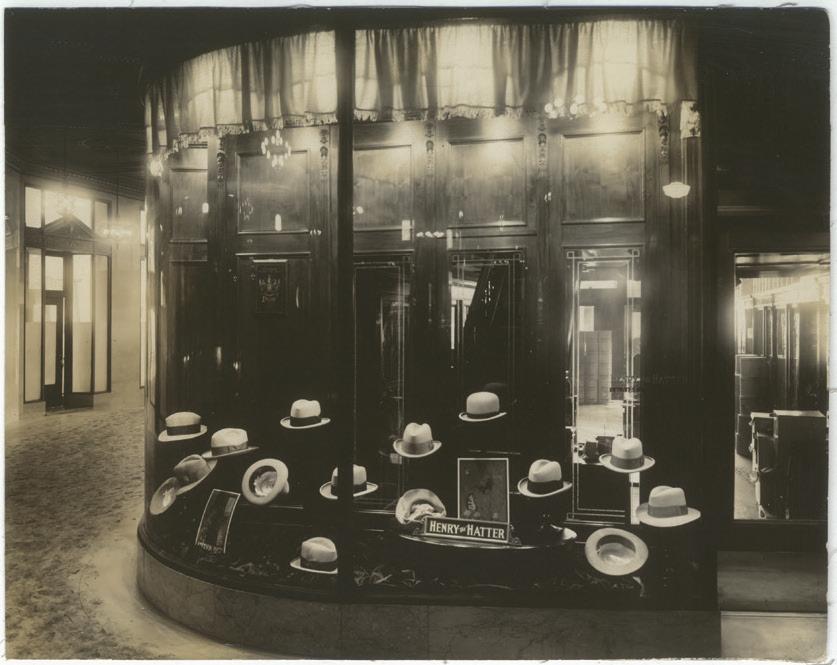

“Weekends are especially amazing with all the foot traffic from Eastern Market, and we continue to see customers from all over the country,” Renkiewicz says. “Right now, for men and women, everyone is wearing flat brims and wide shapes — and we have a great selection.
“The problem for us (has been) trying to follow trends during the pandemic. Because of supply issues, you have to order a year in advance, and you’re not sure if the same style will be as popular the following year,” says Renkiewicz, who has been adding new brands that no one else in Michigan carries.
Along with offering a wide selection of quality hats, Renkiewicz says the key to the success of Henry the Hatter continues to be a tradition of excellent customer service. “I learned from Paul and his dad that if you treat your customers right, they’re going to come back because they know you’ll take care of them,” he says.
Often, customers come in looking for a particular hat after seeing someone wearing it on television. “As a salesperson, I have to be honest with customers. If a hat doesn’t look good with the shape of their face or what they’re going to wear it with, I’ll tell them and show them other options. Ultimately, they have to decide and pick out a hat they’re happy with.”
Invariably, out-of-state customers ask Renkiewicz if he would consider opening a Henry the Hatter in their cities. “I’m too old to do any of that. I have my hands full now with two stores while still working to provide great hats, selection, and service,” he says.
COURTESY HENRY THE HATTER
TOP HAT
Focus 40 DBUSINESS || March - april 2023
Henry the Hatter gots its start along Broadway Street in downtown Detroit in 1893, left, and today operates stores in Eastern Market, middle, and in Southfield, right.
Lachman & Co.
Located in: Southfield
Founded: 1893
Employees: 4
Revenue: NA
In 1893, back when roads carried horse-drawn buggies and the sidewalks were wooden planks, Joseph Lachman, a Lithuanian immigrant and watchmaker, opened his jewelry store on Michigan Avenue at Junction Street on Detroit’s west side.

For 98 years, until Lachman & Co. moved in 1991 to Telegraph Road just north of Eight Mile Road in Southfield, the store remained at its original Detroit location, even after suffering a devastating fire in 1943.
During that span, the jewelry store became a fourth-generation, family-owned, high-quality custom awards and executive gifts company that has been run by Carrie Lachman, the great-granddaughter of Joseph, since the mid-1980s.
Her grandfather, Sol, took over the business in 1910 and, upon his passing in 1936, her father, Phillip, then age 26, inherited the store — although her mother ran it during World War II, while he served the country.
When a customer in the 1950s purchased 100 Longines clocks, the company slowly transitioned out of jewelry and started producing corporate gifts, as large corporations began giving unique tributes to clients and customers each holiday season.
“My parents traveled to Europe every year to attend gift shows, and they began acquiring hand-painted Mancioli ceramic ware from Italy and Orrefors crystal from Sweden,” says Lachman, president and owner of Lachman & Co. “I can remember, as a little kid, my siblings and I would go to the store and we would wrap thousands of those corporate gifts.
“After the tax laws changed and corporate gifts over $25 became taxable, our business pivoted to producing corporate awards, trophies, and executive gifts such as desk sets and beautiful clocks.”
Lachman says the first awards were walnut plaques with brass or nickel-plated metal before moving to crystal and glass designs with specialized etching. For years, the company has created trophies for country, boating, and equestrian clubs, while also designing and producing donor walls for hospitals and other nonprofit organizations.

Longtime clients range from Oakland Hills Country Club in Bloomfield Township to the annual NAACP Fight for Freedom Fund dinner in downtown Detroit, where honorees such as President Bill Clinton, Aretha Franklin, and Rev. Dr. Jesse Jackson have received awards. When Cuba opened up to U.S. visitors, a local organization hired Lachman to produce a large and fancy plaque that was given to President Fidel Castro.
“Everybody in this type of business has their own niche, and there are a lot who produce plastic trophies and plaques, but we’re not in that market. We design and manufacture high-quality products that people are proud to display,” Lachman says.
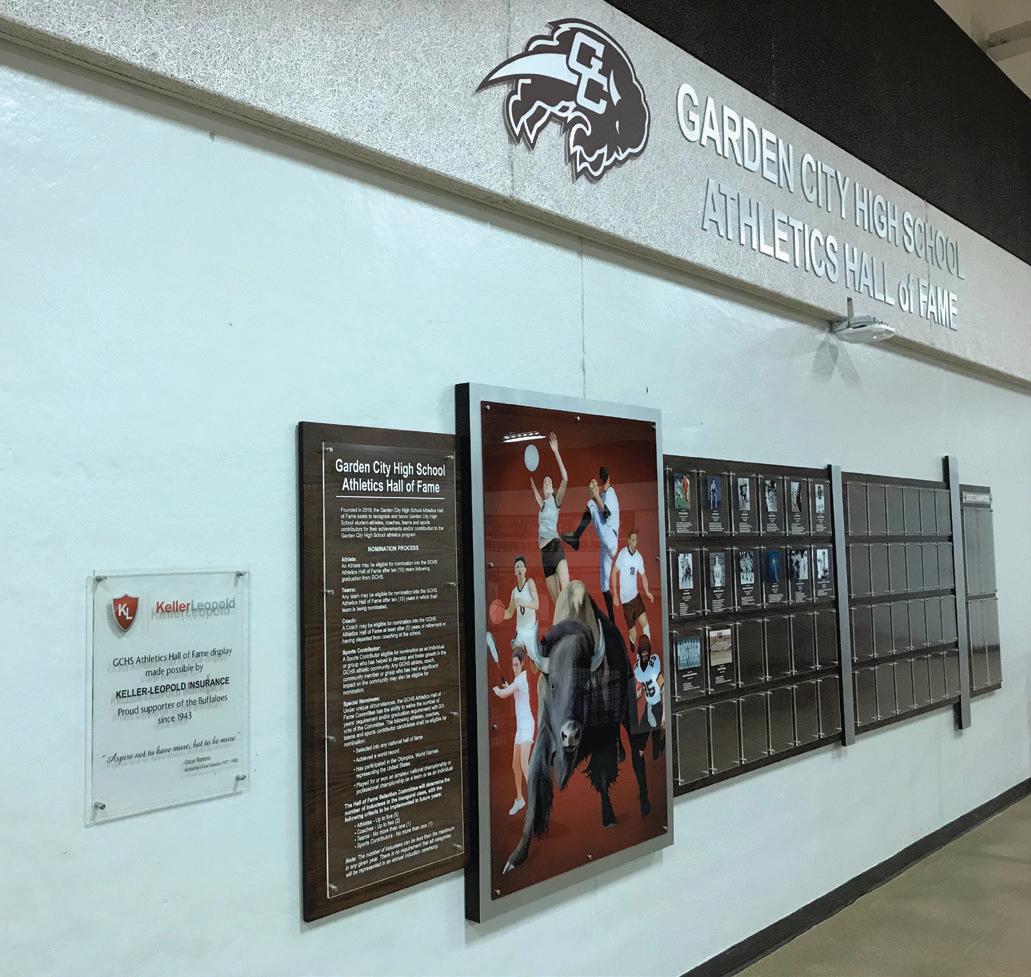
Although most of the crystal and glass now comes from overseas, Lachman custom-designs, assembles, and engraves items on-site at a 6,000-square-foot facility. She says some customers have occasionally purchased less expensive awards and trophies from out of state, but invariably they come back to Lachman because the product they received “was a piece of junk and they didn’t even want to present it.
“The reason we’ve been so successful is because of our quality, long-standing personal relationships with many of our customers, and the fact that we have a quick turnaround since we design and produce the products on-site,” Lachman says.
It also helps that Lachman & Co. is a family business that’s celebrating its 130th anniversary — a feat few companies anywhere can match.
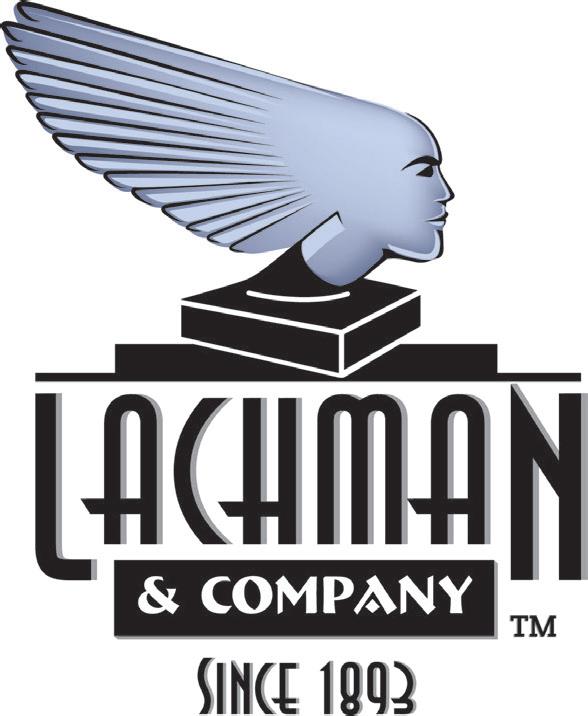
Lachman admits she never envisioned being the one who would end up owning and running the business, but when she graduated from college in 1982, her father suffered a stroke. To help out, she immediately began working at the company. Three years later, she was running the show.
She has never looked back, and still enjoys the daily work.
“I tell people that I’m in the ego business, and they just laugh, but it’s really true,” she says. “It’s a great feeling to know that we’re producing an award or a recognition gift that makes the customer and the recipient feel great. People love to make other people feel happy, and I think everyone really appreciates recognition.”
BANNER AWARDS
COURTESY
& CO. Focus March - april 2023 || DBUSINESS.COM 41
Lachman & Co.’s original storefront in Detroit, a plaque for Aretha Franklin showing her father, C.C. Franklin, and a wall installation at Garden City High School.
LACHMAN
Walsh College
Mervyn B. Walsh, an accountant with Thomas Edison Light Co., founded the Walsh Institute of Accountancy in 1922 and gave his first lecture that September to 23 students on the sixth floor of what was the Capitol Theatre along Broadway Street in the central business district. Eight years later, Walsh student Grace Wimmer became the first woman to receive a certified public accountant designation.
By the end of World War II, the need for accountants increased rapidly. With the advent of the GI Bill, which provided federal funds to veterans to help pay for schooling, Walsh’s enrollment nearly tripled.
By the 1960s, Walsh’s certificate of accounting was no longer enough for prospective employers, who preferred to hire accountants with bachelor’s degrees. To remain competitive, the institution needed to adapt and became a degree-granting college.
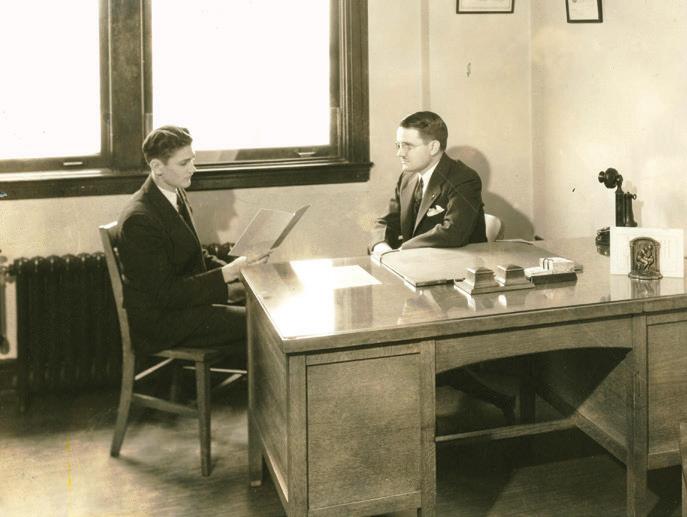

In 1968, three years after Mervyn Walsh stepped down as president and CEO, the institute changed its educational mission and became the Walsh College of Accountancy and Business Administration. The institution was now an upper division college offering coursework and degrees for juniors and seniors who have completed two years at a community college or four years at a college or university. Prior to the move to Troy in 1970, the school was located in the Capitol Theater building in downtown Detroit, now the home of Detroit Opera.
Accredited by the Higher Learning Commission and the Accreditation Council for Business Schools and Programs, Walsh College today offers undergraduate and graduate degrees in marketing, management, human resource management, finance, accounting, data analytics, information technology, and cybersecurity. It also offers a STEM MBA and an MBA that focuses on organizational resilience.

In addition, students can earn a double master’s in an accelerated time frame by enrolling in a unique dual-degree pathway. Walsh College also offers a

doctor of business administration (DBA), and has several non-degree certificate and continuing education options.
With a current enrollment of around 1,200 students, Walsh College has become internationally known for its practical approach to business and technology education. Last year, when the college turned 100, Suzy Siegle became its ninth president and CEO.
“A large part of what sets us apart is that many of our students are working professionals eager to learn skills they can immediately apply to make a positive impact in the business world,” Siegle says. “Combine that with the fact that our faculty are practitioner-instructors who have experience in their teaching fields, and we have a best-of-both-worlds approach.”
As a pioneer in online learning dating back to the 1990s, Walsh was uniquely positioned to successfully fulfill its mission during the pandemic. Even before the world shut down, half of Walsh’s students were online learners.
To further address students’ particular needs, the college’s forward-looking DREAM Committee, led by COO Tom Petz, created Connected Classrooms. These specially equipped learning spaces utilize state-of-theart Zoom technology that allows for seamless interaction between on-campus and remote students. “Our students are busy professionals balancing work, life, and school. It’s important to us that they don’t sacrifice the quality of their education for the flexibility they need,” Petz says.
Of late, cybersecurity has become one of the most popular and growing business technology curriculums at Walsh College. Students in Walsh’s cybersecurity programs, recognized by the National Security Agency and the Department of Homeland Security as a Center of Academic Excellence in Cyber Defense programs, get hands-on experience with the latest tools, techniques, and strategies for dealing with threats in a state-of-the-art cyber lab.
HIGHER PURSUIT
Located in: Troy
Founded: 1922
Employees: 259
Budget: NA
“Our industry-aligned cybersecurity and technical programs have drawn international attention and (receive) high national rankings,” says Dave Schippers, chief administrative officer and associate professor of automotive cybersecurity. “Our expansion with data analytics and data science are key areas that align market need with more real-world education for career success.”
During its centennial celebration, the institution unveiled a three-year, $7.5-million Walsh College Forward capital campaign coordinated with a strategic plan to advance the college’s commitment to increasing access and affordability for students, and expanding business and technology education through innovative learning.
“Walsh College has always been a resilient institution capable of adapting and innovating throughout its history,” Siegle says. “Now, as a business and technology college, we’re looking to develop a Center for Innovation and Entrepreneurship while further enhancing our students’ learning experiences.”
Although Siegle’s title is president and CEO, she prefers to think of herself as the Chief Champion of Walsh College, as she and her team work to move the school into its next 100 years and beyond. “Walsh College is the best business and technology college in the world, and we’re proud that many of the most successful and impactful business leaders in metro Detroit are Walsh College graduates.”
COURTESY WALSH COLLEGE Focus 42 DBUSINESS || March - april 2023
Archie Waring, a 1929 graduate of Walsh College who stayed with the institution for 43 years, assists a student in 1930. Below, Mervyn T. Walsh and his son, Mark, at the Troy campus in 1974, and the lobby today, right.
Corden’s Candy Carrousel

SWEET HISTORY
Sam Corden launched Corden’s Candy Carrousel in 1918 in Detroit. Today, his grandson, Nick Corden, runs the business, now based in Inkster. The company produces 24 different hand-crafted chocolates from decades-old recipes.

Located in: Inkster
Founded: 1918
Employees: 50
Revenue: NA
On one unforgettable day in the late 1960s, 11-year-old Nick Corden stepped into the kitchen at Corden’s Candy Carrousel in Inkster, where he learned a valuable lesson from the owner — his father, Evans.
“He wanted to teach me how to cook caramel, which takes about 45 minutes, and instructed me to keep stirring it and not to walk away because it would burn,” recalls Corden, 65, a former litigation attorney who began working with his father in 2009 before taking over the 105-year-old business upon Evans’ passing in 2014.
“Of course, as a young punk, I walked away and let it burn. I can still see the look on his face every time I make it today from scratch,” he adds with a laugh. “It’s not haunting, but a friendly reminder that I learned my lesson.”
Corden’s Candy Carrousel sells more than 24 hand-crafted chocolates made from decades-old recipes, ranging from turtles and coconut clusters to truffles and sea salt caramels. The business, likely the oldest family-owned chocolatier in metro Detroit, regularly receives five-star reviews from loyal customers, like the following one from Cece F. of Clinton Township: “This candy is probably the best that I have ever eaten. I guess when you use quality ingredients and make them by hand, you really do get a great product.”
In 1918, Nick’s grandfather, Sam Corden, a Greek immigrant, started the business with his cousin, Gus, on Michigan Avenue in Detroit. Later, they moved down the street next to the Senate Theater, where moviegoers and generations of Detroiters gorged on handmade chocolates and ice cream at the Senate Sweet Shop.
Just as Nick did decades later, Sam’s son, Evans, often would help his father out at the confectionary store.
After graduating with an accounting degree and working for one year as an accountant at Ford Motor Co. in Dearborn, Evans decided that corporate life
wasn’t as sweet as making and selling handmade chocolate with his dad. By the early 1950s, Sam retired, moved to Florida, and turned the keys over to his son. To stay current on industry trends, Evans began attending chocolate school twice a year in Pennsylvania, while creating his own chocolate recipes.


In a 1981 interview with the Detroit Free Press, Evans said: “When I was younger, I smelled so sweet that my kids wanted to crawl in bed with me every night.”
By the mid-1960s, Corden decided to open a second chocolate shop, named Corden’s Candy Carrousel, 20 miles west on Michigan Avenue in Inkster. Due to rising crime rates in Detroit, by the end of the decade Corden closed the Senate Sweet Shop.
Like his father, Evans, who left a professional career to work in the chocolate business with his dad, Nick walked away from a 25-year insurance defense litigation practice to help his dad run the shop after his mother, Maria, suddenly died on Valentine’s Day in 2009 while working at the store.
“My dad was devasted when she died, and I knew I could shock some life into him if we worked together,” Corden says. “We had a lot of good days for five years before he died, but I wish I had asked him more questions because I had to learn a lot by
trial and error, including learning how to fix some of these machines that date back to my grandfather’s time. That first year was a tough transition from being in court to suddenly working 12 hours in a kitchen every day.”
Corden says he makes half the money he made as an attorney and works even longer hours (“typically 10 to 12 hours, seven days a week, from Halloween through New Year’s”), while noting that he would be unable to maintain the business without his wife’s teaching salary.
Like his grandfather and father, however, the reward of making delicious chocolate products and pleasing customers makes up for all the hard work.
“With law, someone is always going away unhappy, but with a chocolate shop that’s not the case,” Corden says. “I’ve also learned to love the kitchen. We’re not a mass-produced chocolate factory. People tell us our products have a unique taste and texture that you don’t normally find.”
Although he ships boxes of chocolates out of state and overseas to loyal customers, Corden doesn’t advertise or use e-commerce; rather, he relies on word-of-mouth advertising. “Otherwise, I would never be able to keep up with the demand and maintain the quality,” he says.
Focus March - april 2023 || DBUSINESS.COM 43
COURTESY CORDEN’S CANDY CARROUSEL
Faygo
Located in: Detroit
Founded: 1907
Employees: 300-400
Revenue: NA
Among the iconic businesses created in Detroit that have become synonymous with the Motor City, one of the most popular has been Faygo, the soft drink beverage company founded 116 years ago in 1907 by Russian immigrant bakers Ben and Perry Feigenson.
Their company, Feigenson Brothers Bottling Works, began on Benton Street south of today’s Detroit Medical Center. While they mostly processed lager beer and soda water, the innovative duo started adding cake frosting flavors to soda water and delivered their new product to customers from a horsedrawn wagon.
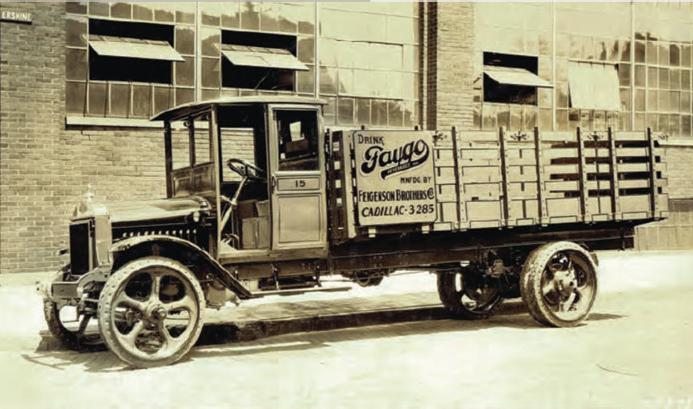
The “soda pop” became so popular, the business relocated to a larger building on nearby Beaubien Street. By 1921, the company was rebranded as Faygo, primarily because Feigenson Brothers Bottle Works didn’t fit on the labels.

The ever-expanding bottling works moved to its current location at 3579 Gratiot Ave. in 1935, and by the mid-1940s the Feigenson brothers turned Faygo over to their sons. Today, Faygo still is primarily produced at the Gratiot plant, and more than 50 flavors are sold throughout the United States and parts of Canada. One to three new flavors — or throwbacks — are introduced annually.
While Faygo doesn’t specifically disclose their employee count, according to Dawn Burch, Faygo’s marketing director, “It’s been reported in various published articles that, ‘depending on the season, employment at the Detroit plant ranges between 300 and 400 people,’ while the company historically continues to practice recruiting and hiring from local Detroit neighborhoods.
“I think the secret of our success has been our unique and extensive flavor line and the multigenerational consumer loyalty it garners,” adds Burch, a native of metro Detroit who grew up drinking Faygo.
“There are very few regional soft drink brands that have stood the test of time in the original market in which they started, but Detroit-area consumers have a strong nostalgia for the brand, as they grew up drinking it and continue to introduce it to the next generation. Faygo’s continuing philosophy is centered around the support of our local community by manufacturing here and hiring locally.”
Faygo’s popularity began to grow and expand outside of Michigan in the 1950s, after company chemists were able to extend the products’ shelf life. Expansion continued thanks to the introduction of diet soda and aggressive marketing advertising campaigns on radio, television, and during Detroit Tigers baseball broadcasts.

The company has had a number of memorable ads, including the animated and award-winning spots featuring a fictional cowboy, “The Faygo Kid.” Later, the nostalgic tune “Remember When You Were A Kid,” also known as the “Faygo Boat Song,” was introduced; to this day, its chorus is still stuck in many heads: “Remember when you were a kid? Well, part of you still is, and that’s why we make Faygo.”
“From a marketing standpoint, the song has truly stood the test of time. We even recorded it within the past 10 years to satisfy consumer demand,” says Burch, who notes that it’s commonplace to find customers singing the song to Faygo employees wherever they go.
In 1986, TreeSweet Products Corp. acquired Faygo from the Feigenson family for a reported $105 million and a year later, Faygo was sold to its current owner, Florida-based National Beverage Corp. According to Burch, although National Beverage has annual revenue in excess of $1 billion, it doesn’t disclose revenues for its individual brands.
Perhaps surprisingly, Faygo has received worldwide attention within the rap music world for more than a decade as performing artists have frequently included references to Faygo in their lyrics — likely most famously the Detroit rap duo Insane Clown Posse, who drink the soda onstage before showering their fans with the sugary liquid.
According to lyrics.com, more than 130 songs include the word Faygo.
In 2020, the Seattle rapper Lil Mosey’s song “Blueberry Faygo” peaked at No. 8 on the Billboard Hot 100 list. Since then, the song has easily surpassed 1 billion streams on Spotify. It’s also become the rapper’s signature song.
POP CULTURE
Faygo has used different logos since its start in 1907 in Detroit. What was originally Feigenson Brothers Bottling Works became Faygo in 1921. Above, bottle designs from the 1950s through the 1980s.

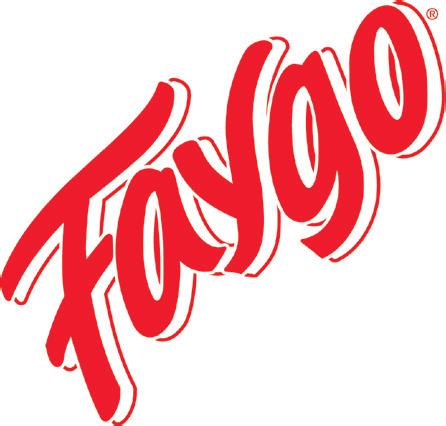

It’s proably no coincidence that last year, for a limited run in Michigan, Faygo brought back for the first time in over 15 years “Jazzin’ BluesBerry.”
“We’re fortunate that Faygo fans are passionate about our brand and often incorporate it into pop culture, including music,” Burch says.
So, of all the current Faygo flavors, what are the biggest sellers?
“Our most popular are Redpop and Rock & Rye, which continue to be our flagship flavors (and most popular in Michigan),” Burch says. “However, outside of Michigan, Orange, Cola, Crème Soda, and Moon Mist lead the way. Our newest flavor, Firework, is currently the leader in small bottles. As for me, it’s Rock & Rye — and Arctic Sun.”
Focus 44 DBUSINESS || March - april 2023 COURTESY FAYGO


Space Constraints
Hybrid work schedules, evolving demand for office space, and higher interest rates are giving life to alternative uses for commercial skyscrapers.
BY DALE BUSS
Fifty years ago, downtown Detroit staked its economic revitalization to the Renaissance Center. It was a stretch project if ever there was one — a $357-million Hail Mary that Henry Ford II, then chairman and CEO of Ford Motor Co., called the key to forging “a viable, going, great city.”
Highlighted by a gleaming, 727-foot-high, 73-story cylindrical central skyscraper sheathed completely in glass, surrounded by four 39-story auxiliary towers with the promise of many more, and anchored beside the Detroit River, it was promised that the “RenCen” would single-handedly put the Motor City back on the map of metropolitan greatness.
Nowadays, there’s not nearly as much hype attached to a new development on the site of the former J.L. Hudson’s department store on lower Woodward Avenue. On the block that held the beloved but shuttered old emporium until it was imploded in 1998, Dan Gilbert is raising a building that will become the second-tallest skyscraper in Detroit
the exclamation point on a $1-billion, mixed-use megaproject that has taken five years to start and will consume another couple of years to finish.

It’s a bold signature on Gilbert’s nearly 15 years of pioneering — and highly successful — efforts to revive downtown Detroit. “Dan’s vision is very clear. He’s 100 percent focused on returning Detroit to its rightful position as a world-class city,” says Kofi Bonner, CEO of Bedrock, Gilbert’s real-estate arm. “He doesn’t talk about legacies. To him, it’s the journey. He’s very clear in his moonshot.”
The 45-floor skyscraper will be a luxury Edition hotel for up to 22 stories or so, “and above that, an elegant and lean tower that begins to scale back as it turns into residential,” Bonner says. “(There will be) about 89 or so units. The residences will be branded. Folks living there will have the ability to avail themselves of amenities of the hotel services, which will create an elevated experience for tenants. They’ll also have their own very exclusive amenities.”
Next door, an 11-story office building will have a huge atrium and what Bonner calls “an elegant rooftop anatomy.” Upscale stores will be sprinkled through the first floors of both buildings. A street-level plaza stretching from Woodward to Farmer Street between the two structures will provide pedestrians with easy access to stores and restaurants.
Even in terms of parking, the Hudson-site complex aims to be innovative: To squeeze in enough automobiles in a central business district that remains understandably transit-light and car dependent in the automotive capital of the world, Bedrock is considering “a mechanical parking system where you can put a car on top of a car,” Bonner says.
Gilbert’s tower initially was going to be as much as 900 feet, its cloud-borne apex easily eclipsing the top of the Renaissance Center. But lately, Bedrock has knocked the plan for the Hudson-site tower down to 685 feet, likely due to inflated construction costs and diminished expectations for the future of office real estate in Detroit.
Yet in a major way, Bedrock’s decision was a sign of the city’s progress. Not as much is dependent on that tower as the massive onus that was placed on the RenCen. Over the past decade, Gilbert, the late Mike Ilitch and his successors, and other entrepreneurs already have revived and solidified the lower Woodward core and beyond.
Indeed, new and refurbishment projects now are sprouting up all over town, feeding robust
COURTESY THE EXCHANGE Perspectives 46 DBUSINESS || March - april 2023
ON THE RISE
“Something quite remarkable is taking place, something unique in the history of cities,” intoned the narrator in a nine-minute RenCen promotional video that featured a jazz-funk version of “Also Sprach Zarathustra,” the classic composition that gained modern popularity as the theme song from “2001: A Space Odyssey.”
Later, the narrator continues, “It’s the largest privately financed urban development in history (and) there will be nothing quite like it in all the world.”
Key would be an iconoclastic interior design by architect John Portman, whose modernist renditions in the Peachtree Center in Atlanta and the Embarcadero Center in San Francisco had helped revolutionize big public spaces. Experiencing the RenCen’s central tower would “touch and delight (y)our senses” and “take your breath away,” the video promised. “It may well be the architectural achievement of this decade.”
tendrils of revitalization that stretch horizontally as well as vertically — from downtown to Corktown; from The District Detroit, where three sports stadiums offer nearly daily sports and entertainment, to Greektown; and from the Huntington Place to the Huntington Tower.
And the initiatives keep coming. Late last year, the Ilitch family’s Olympia Development announced a new, $1.5-billion project that will bring housing, office, retail, and two hotels to 10 properties in The District Detroit, which covers 50 square blocks. The brownfield-remake effort is meant to fulfill a longstanding vision for creating vibrant neighborhoods around Little Caesar’s Arena, the sports and entertainment district that the owners of the Detroit Tigers and Red Wings, and the Fox Theatre, already had established.
“The vertical gets better when you create room for the vertical to breathe, with good public spaces and community gathering places,” says Andrew Cantor, president of Related Michigan, the real estate operation for billionaire Stephen Ross, a Michigan native since transplanted to New York City who is Olympia’s partner in the venture. “That’s something fundamental to our approach to this development.”
To be sure, the pandemic put a big dent in the evident economic progress of the city, flushing commuting office workers from downtown for many months and throwing their eventual return into question.
But “in general, the future of commercial real estate in Detroit is strong,” says Andy Gutman, CEO of Farbman, a local real estate management group.

“Usually, Detroit is ground zero for distress. But that’s not the case. Look at cities like Chicago, with so many buildings teetering on the point of failure.”
Fifty years ago, Detroit was teetering at the edge of its own historical abyss, pushed there by a diaspora of residents to the suburbs that began in the early 1950s, then was fed by the 1967 riots, white flight, and the subsequent urban-suburban acrimony of the late 1960s.
Among the scars of neglect and decay was a downtown riverfront populated mainly by three cement factories, industrial businesses, and warehouses.
An unprecedented corporate consortium led by Ford Motor Co. meant to change all of that. After abandoning initial plans to build a new sports stadium between Jefferson Avenue and the river, the 52 members of the Detroit Renaissance partnership that Henry Ford II had assembled decided to put up a 33-acre destination complex instead. The RenCen would offer 2 million square feet of office space, a 1,400-room Detroit Plaza hotel, and a 350,000-squarefoot shopping center with retail shops, cafes, restaurants, banks, brokerage firms, theaters, private clubs, and a department store.
But instead of taking visitors’ breath away with its five levels of suspended walkways that crossed a sixstory atrium, a reflecting pool, and a revolving cocktail island, the RenCen simply frustrated them. The central tower proved to be one of the most confusing structures in the world, to its tenants as well as visitors. A pedestrian commute from the top of one of the auxiliary towers to the top of the main one could take 15 minutes.
The huge, naked concrete buttresses that were central to Portman’s design also could seem to physically threaten passers-by, in many places providing just a few feet of clearance underneath, in the RenCen’s sharpest expression of brutalist architecture. And within the far-flung network of stores on the lower levels of the complex, shoppers simply got trapped by the loops of a maze that was basically unnavigable.
The stores were “supposed to be a savior against retail moving to the suburbs, but the shopping space” never took off, says Brendan Roney of the Detroit Historical Society. “It’s not like a mall — it’s not, go upstairs and around the corner to get some food. It’s not centralized like a mall is.”
Exasperating inside, the RenCen also proved to be intimidating outside. “It is a total environment, a town within a great city, linked by rail, waterway, superhighway, and air to the other cities of the world,” the promotional video said. The problem was that the complex wasn’t really linked to the rest of its own neighborhood. Many pedestrians didn’t dare try to cross multi-lane Jefferson Avenue, which empties traffic from highways on both the east and the west.
Another infamous feature was two concrete berms that designers placed directly in front of the RenCen facing Jefferson Avenue. They were meant to hide infrastructure such as HVAC equipment, and Henry Ford II reportedly was fastidious about trying to make them look pretty, with ivy covering the concrete. But
Perspectives March - april 2023 || DBUSINESS.COM 47
Bedrock is developing the Hudson’s site in downtown Detroit into a 45-story hotel and residential tower, along with a neighboring 11-story office building. The project is set to be completed in late 2024.
HELLO, DETROIT
THERE’S ONLY ONE PROBLEM with the panoramic view of The District Detroit from the outdoor rooftop lounge at the apex of the new 21-story Huntington Tower at 2025 Woodward Ave.: You can’t quite see home plate at Comerica Park because it’s tucked right behind the right-field stands.
But this is a small nit to pick about a building that’s a pride of the bank, appreciated by employees, and coveted by fellow downtown tenants.
Ground was broken on the glass-clad building by Detroit’s Chemical Bank, which subsequently merged with Minneapolis-based TCF Bank in 2020. After Huntington acquired TCF in 2021 — a transaction that also resulted in another name change of the original Cobo Hall, to Huntington Place — Huntington completed the tower and designated it the commercial headquarters.

Huntington Chairman Gary Torgow dubbed it “the largest bank building built in Detroit’s history” at the tower’s grand opening in September. Originally, it was announced as a $104-million project.
“The main thing it did for us was to consolidate our staff,” says Eric Dietz, southeast Michigan president for the Columbus-based regional-banking leader. “We were pretty spread out.”
Floors 2 through 11 are devoted to parking, an unfortunate necessity in downtown’s tight market. Where Huntington Tower differentiates itself is in how the top nine floors ultimately were designed to accommodate a workforce of 750 people who are working full time or under a hybrid model that brings them in mainly in the middle of the week.
The open concept dominates, with many informal areas for collaboration, glass-walled meeting rooms, sprinklings of spaces for eating and taking breaks, lots of Huntington-brand green, and signage that repeats “Welcome” all over the place. There are some traditional cubicles, many of which are “hoteling” desks shared by staffers, but traditional
“corner offices” are nowhere in sight.
The large meeting space on the 19th floor is a company favorite because it can hold up to 300 people and can be configured multiple ways.
“We’re getting a lot of activity in that room from Huntington groups (inside and) outside of Detroit who want to hold annual or quarterly meetings there,” Dietz says. “Nothing against Columbus, but Detroit is new and it’s a great place for colleagues to visit.”
Just one story up is a rooftop deck, a space designed for hosting multiple activities that can hold up to 360 people. Torgow said at the grand opening that it literally provides “a 50-yard-line view of Detroit.”
Ron Gantner, a real estate partner at the Plante Moran consulting firm in downtown Detroit, notes the roof services the fact that “people are interacting with the outside a lot more than in the past. A lot of older buildings (in Detroit) were closed off and shelled in. It’s, ‘How do I create something that’s unique and different than the office building I’m sealed in?’ Hopefully you’re enjoying the outside in some way nine months of the year. The Compuware building started that with an outside deck on the 15th floor.”
All of this adds up to a Huntington Tower that has become the envy of downtown, especially because the bank hasn’t opened it up to other tenants. “There’s a flight to quality in office space in Detroit now, so there was a demand from the outside, had there been space,” says Dave Miller, senior vice president of Signature Associates in Southfield. “But they’re not offering space.”
As Andy Gutman, president of the Farbman Group in Southfield, puts it, companies seeking office space “aren’t supposed to fall in love with a building. But this is a place that people want to (work in) and love to work (in). It’s another beautiful building that leads to a further resurgence of the city.”
By Dale Buss
unfortunately, it was quickly apparent that the berms were both an immense physical barrier as well as a psychological one that basically said, “Stay away!”
General Motors rescued the RenCen, purchasing it from an investor for the bargain basement price of $72 million in 1996 to serve as its new global headquarters, and moving corporate functions lock, stock, and barrel from the 1920s-vintage GM Building in the New Center area. In addition to revitalizing the complex as a center of commerce and tourism, the automaker fixed many of the RenCen’s obvious problems, including removing the berms, lightening spaces inside, and providing a plethora of new signage to help people get around the building.
GM also created the Wintergarden area, connecting the RenCen to the city’s new RiverWalk. Detroit’s riverfront was named Best Riverwalk in the Nation by USA Today in 2021 and 2022, topping better-known walks such as San Antonio’s. In turn, GM has invested $35 million into the Detroit Riverfront Conservancy’s efforts to expand and maintain the RiverWalk.
The RenCen “never has looked better,” says Dan Austin, a City of Detroit communications director, who’s also a maven of historic Detroit buildings. “But there’s only so much you can do with a building that’s built like a labyrinth.”
So, the RenCen’s relationship with the rest of the city was stuck in an uncomfortable equilibrium even as downtown, across Jefferson Avenue, was being reborn. Then the pandemic hit in 2020, immediately emptying GM’s workforce from the towers and keeping most white-collar employees away for more than a year. When GM tried to call them back last fall, internal opposition exploded, and a revolt was on. GM backed off the deadline for a “hybrid,” or part-time return to the office, delaying it until January.
Meanwhile, the RenCen has lost commitments from some of its other major tenants, most notably Blue Cross Blue Shield and Deloitte.
For its part, GM says, “Detroit is our headquarters and our home, and the Renaissance Center is a vital part of the downtown Detroit community. Right now, we’re focused on bringing our employees back to the office, which is an important step for our business and for the continued revitalization of the city. GM is committed to keeping the Renaissance Center in a Class A manner and will never deviate from that standard. Building management is actively canvassing for prospective tenants and offers competitive lease rates and flexible lease terms.”
While the RenCen has been foundering, Gilbert has bought, rented, refurbished, and populated downtown office space with thousands of employees of his highly successful Rocket Mortgage and Rock Family of Cos., using his businesses as engines of economic revitalization and drawing in others in pursuit of the same goal. The Ilitch family has operated similarly.
And they weren’t investing for the best ROI. “A lot of that is driven by legacy,” says Ron Gantner, a real estate partner in the Plante Moran consulting firm in Detroit. “It would be hard if you had to do it with a third party and traditional development financial goals to hit.
GREEN TEAM
COURTESY HUNTINGTON BANK Perspectives 48 DBUSINESS || March - april 2023
Set along Woodward Avenue between the Fyfe and Francis Palms buildings, the 21-story Huntington Tower in downtown Detroit opened last September. It’s believed to be the largest bank building ever constructed in Detroit.
None of this would happen, especially with interest rates where they are now. It’s part of their legacy. They want to create an environment that, hopefully, they and their kids will see. Otherwise, they could go to a bank and buy CDs.”
Every office landlord in Detroit and the region, not just at the RenCen, is dealing with a powerful new dynamic in the wake of COVID-19: the work-fromhome phenomenon, coupled with the demand by workers returning to the office, especially younger ones, not to come back to the same old cubicle with the requisite ping-pong table in the break room.
“Real estate is part psychology,” Gantner says. “Look at the experiences that kids have in college dorms and classrooms, and technologies. Universities are spending billions of dollars to create that. Students come out of school and their expectation is that this is their amenity base at the office. There’s a lot of pressure on employers to attract top talent, to have open and collaborative work, and the coolness factor is what they’re looking for.”
Tectonic movements in the broader economy also are coming into play, especially the tens of thousands of recent layoffs by Amazon, Meta, Google, and other big digital-tech companies. For two decades before their current contraction, those giants’ ever-expanding hiring gave downtown-office developers across the country hope of landing one big fish that could financially justify their projects.
In Detroit right now, there also are cost pressures on Rocket Mortgage, thanks to fast-rising interest rates that have quelled the retail-mortgage business and prompted the company to offer buyouts to an undisclosed number of employees. Overall, the metro Detroit office-vacancy rate reached more than 26 percent in October, much higher than before COVID-19, according to Signature Associates in Southfield.
Yet, in fact, Cantor says, nationally there remains “strong demand for dynamic office space that’s modern, with inspired designs, large open spaces that allow people to gather and collaborate, and lots of amenities around so it becomes a live-work-play environment that a lot of tomorrow’s talent is seeking.”
BOTTOM’S UP
TUCKED IN AMONG ALL THE OTHER changes to the Detroit skyscape is a $65-million mixed-use project in Greektown that would be notable simply for the fact that the 16-floor tower at Gratiot Avenue and Brush Street will bring new housing to the area for the first time in several decades, in the form of 153 luxury condominiums and apartments.
But what really makes The Exchange stand out is that it appears to be upside down. A construction technology pioneered by the builder, Barton Malow, enabled the Southfield-based contractor to assemble the top floors at ground level and then raise them into place.

Using a process Barton Malow calls LiftBuild — itself the basis for a startup the company acquired — the builder raised the 16th floor last year, and continued lifting and locking successive stories underneath it until, in early February, The Exchange consisted of 14 completed floors on top, around a core that stretches to the bottom, with the final floor lift scheduled by spring.
“LiftBuild is definitely a step in the right direction for the construction industry,” says Ryan Maibach, CEO of Barton Malow, which plans to celebrate a century in business in 2024. The company is involved in a number of other major endeavors, such as building Ford’s $5.8-billion BlueOval SK Battery Park in Kentucky and the Hudson’s development in downtown Detroit, but Maibach is excited about the Greektown project partly because he believes LiftBuild can help shave as much as 50 percent
BREAKING GROUND
The Exchange, center, will offer 153 luxury condominiums and apartments, along with office and retail spaces, when it opens this summer next to Detroit’s Greektown district.

off the time required to build projects such as The Exchange.
Every tall building has a structural core, Maibach explains, “and then you typically build the skeleton around that. But this approach uses the core as a primary structural element and lifting mechanism, so we’re able to create manufacturing space at the base of the building. You see some terrific efficiencies in putting up the building. And because you’re relying on fairly constant and standardized engineering, we see the possibility for automating the design process, too.”
By Dale Buss
COURTESY THE EXCHANGE Perspectives March - april 2023 || DBUSINESS.COM 49
TALLEST MULTITENANT OFFICE BUILDINGS IN METRO DETROIT
(LISTED BY HEIGHT, 25 STORIES OR MORE)
DETROIT
PENOBSCOT BUILDING
645 Griswold St., Detroit
Height: 47 stories
Total Sq. Ft.: 1,149,710
Owner: Triple Properties Detroit
ALLY DETROIT CENTER
500 Woodward Ave., Detroit
Height: 43 stories
Total Sq. Ft.: 1,000,000
Owner: Bedrock
CADILLAC TOWER
65 Cadillac Square, Detroit
Height: 40 stories
Total Sq. Ft.: 400,000
Owner: Bedrock
GUARDIAN BUILDING
500 Griswold St., Detroit
Height: 40 stories
Total Sq. Ft.: 470,557
Owner: 400 Monroe Associates
RENCEN – TOWER 100
100 Renaissance Center, Detroit
Height: 39 stories
Total Sq. Ft.: 587,973
Owner: General Motors
RENCEN – TOWER 200
200 Renaissance Center, Detroit
Height: 39 stories
Total Sq. Ft.: 593,480
Owner: General Motors
RENCEN – TOWER 300
300 Renaissance Center, Detroit
Height: 39 stories
Total Sq. Ft.: 584,531
Owner: General Motors
RENCEN – TOWER 400
400 Renaissance Center, Detroit
Height: 39 stories
Total Sq. Ft.: 576,449
Owner: General
Sq. Ft.: 586,038
Owner: SL Town Center Realty
SOUTHFIELD TOWN CENTER –
1000 TOWN CENTER
1000 Town Center, Southfield
Height: 28 stories
Total Sq. Ft.: 597,346
Owner: SL Town Center Realty
SOUTHFIELD TOWN CENTER
– 2000 TOWN CENTER
2000 Town Center, Southfield
Height: 28 stories
Total Sq. Ft.: 556,014
Owner: SL Town Center Realty
AMERICAN CENTER
27777 Franklin Rd., Southfield
Height: 26 stories
Total Sq. Ft.: 508,000
Owner: REDICO TROY PNC CENTER 755 W. Big Beaver Rd., Troy
Height: 25 stories
Total Sq. Ft.: 535,000
Owner: 755 Towers Associates
Source: DBusiness research
The city’s latest tower projects have, of course, taken this well into account, including new space in The District Detroit such as the 20-story Huntington Tower that opened last year. And office landlords downtown and in the suburbs, for the most part, are continuing to invest in places that modern workers will enjoy, especially as more of them opt to live nearby in new and restored residential offerings.
Indeed, the finances behind office construction have changed as the general labor squeeze in Detroit and elsewhere has continued, even in the face of a rocky U.S. economy. “Real estate typically is 5 percent to 8 percent of a company’s expenses, while typically 60 percent is employees,” Gantner says. “What’s happening now is that companies believe they can spend maybe 10 percent to 15 percent more on real estate because it so impacts the 60 percent of their expenditures on labor.”
As Bonner puts it, “Companies are thinking, isn’t it a better strategy to retain the folks you have so that when you come out of this, you’re not behind the eight ball? From our point of view as a landlord to many companies in this situation, we say we’re going to create the best environment that we can for you, so recruiting is easier.”
Nevertheless, many occupants of the office towers in Detroit, and tenants of commercial real estate in the surrounding metro area, are facing a new round of decisions about their future.
“We see a mixed bag of what organizations are doing when their leases are running out,” Gutman says. “Some are kicking the can down the road while figuring it out, leasing for another year, and some are reducing space. And some are returning to the office while not actually going back. Some buildings will come off market as some convert to mixed-use developments, and others will fill back up over time as the economy strengthens.”
One option is remaking vacant offices into residences. “There’s so much office space that we’ll see
Motors THE FISHER BUILDING 3011 W. Grand Blvd., Detroit Height: 30 stories Total Sq. Ft.: 635,000 Owner: Fisher 2015 Acquisition BUHL BUILDING 150 W. Jefferson Ave., Detroit Height: 29 stories Total Sq. Ft.: 482,454 Owner: Bedrock ONE WOODWARD AVENUE 1 Woodward, Detroit Height: 28 stories Total Sq. Ft.: 447,725 Owner: Bedrock 211 WEST FORT 150 W. Jefferson Ave., Detroit Height: 27 stories Total Sq. Ft.: 438,640 Owner: Foster Financial Co. FIRST NATIONAL BUILDING 660 Woodward Ave., Detroit Height: 26 stories Total Sq. Ft.:
Owner: Bedrock 150 WEST JEFFERSON BUILDING 150 W. Jefferson Ave., Detroit Height: 26 stories Total Sq. Ft.: 505,409 Owner: REDICO
831,918
SOUTHFIELD SOUTHFIELD
3000
3000
Height:
Total
TOWN CENTER
TOWN CENTER
Town Center, Southfield
32 stories
Perspectives 50 DBUSINESS || March - april 2023
THE VERTICAL AND HORIZONTAL JOURNEYS (IN DETROIT) ARE HOW YOU BRING EVERYONE ALONG.” ANDREW CANTOR
Detroit Skyline
2022 Detroit Office Market Report
WELCOME BACK
As the office market in downtown Detroit looks to recover from COVID-19, more companies are requiring their employees to return to work.
conversions of suitable buildings to apartments,” says John Boyd, founding principal of Signature Associates. “The apartment market is very strong. They’ve been selling at record numbers.”
As it stands, the Hudson-site tower isn’t going to be an office complex, per se, but a prestigious, high-rise residence with an attached, smaller office building. “It’s perfect for what’s desired and needed right now,” Gutman says. “The office portion of the Hudson site may fluctuate, but other uses may make up for that, and it will be a cornerstone development for the city.”
Then why did Bedrock shave so many stories off the planned tower? “The reason the height was scaled back had everything to do with uses — functionality in those spaces — and not so much a function of cost,” Bonner says. “Now the envelope fits the uses and scale.”
Down on the ground, the cityscape of Detroit gets more varied and interesting every day. The development of apartments and condos in and around The District Detroit is picking up, connecting gentrification in the arena district to neighborhoods to the north. An envisioned capping of I-75 on either side of Woodward will encourage even more organic growth, much like portions I-696 in Oak Park were covered over to create park space for nearby residents.
What the Ilitches and Ross announced “validates the district,” says Eric Dietz, president of the southeast Michigan region of Huntington Bank. “It’s been slow in getting momentum because of COVID-19, but we all know their commitment to continue their vision of the area.”
Confirms Cantor, “We think there’s an opportunity because of the scale of The District Detroit, and because of the (government) requirements of the transformational brownfield (incentive) program to
think at scale, to be able to move a lot of projects forward in a short period of time, and to do so in a way to create active, engaging streetfronts, walkable districts, and nodes that are vibrant and fun.”
Broadly, real estate pros say the administration of Mayor Mike Duggan has been making the downtown-development process ever easier, with government services the best they’ve seen. “What happens in Detroit, separate from many cities, is the incredible partnership between members of the private sector, not-for-profit entities that are supportive of the urban infrastructure, and the public sector,” Bonner says. “That’s what has set Detroit apart, plus the urgency and intensity of the efforts.”
In any event, downtown Detroit now spells opportunity to a new generation of economic actors across the country and around the world. “One thing that’s unique about Detroit is that you can make an impact on Detroit,” Gantner says. “Companies can go to New York City or Chicago or Boston and be a headline for a day, but in Detroit they can really move the needle on the city’s success and opportunities for its citizens. That’s something that can be important for a corporate citizen.”
Of course, much of the rest of Detroit remains a challenge: There are 139 square miles, enough to fit the footprints of Boston, San Francisco, and Manhattan inside, but only north of 600,000 people and no pockets of densification outside the central business district. “You have four acres of some neighborhoods where only 10 people live and you have to service them,” Gantner notes.
Yet, these days, Austin says, people are fixing up mansions in the historic Boston-Edison historic district in the center of the city and on “blocks and blocks west of the Lodge Freeway on Atkinson. That’s what you need. The city can’t survive on downtown alone. It needs the neighborhoods to thrive.”
Over it all will loom the fates of the Hudson-site tower and the Renaissance Center. “The vertical and horizontal journeys,” Cantor says, “are how you bring everyone along.”
TOWER PORTFOLIO
Some of the other major towers and significant office buildings in Detroit include:
Book Tower, 1265 Washington Blvd.: The 38-story Italian Renaissance-style structure, along with the adjoining 13-story Book Building, was completed in the 1920s and rehabbed by Bedrock nearly a century later. The mixed-use update “is one of the most elegant historical rehabs I’ve ever been involved in or seen,” says Kofi Bonner, CEO of Bedrock. “It’s almost like stepping back into the past.” Set to open this year, the buildings will offer a Roost Hotel, apartments, office space, restaurants, a rooftop bar, a skylit ballroom, a domed atrium, and a fitness center.
Little Caesars World Headquarters, 2211 Woodward Ave.: Completed in 2020, the $150-million, nine-story, 234,000-square-foot building features a unique front glass façade comprised of 150 individual, 14-foot-tall “pizza slices.” It’s a pillar of The District Detroit, a 50-block area downtown that includes three sports stadiums, multiple theaters, and commercial and residential spaces. “It’s really well done, a wonderful complement to the façades along Woodward Avenue, and a very innovative space,” says Ryan Maibach, CEO of Barton Malow, the Southfield-based general contractor.
Ally Detroit Center, 500 Woodward Ave.: Formerly known as One Detroit Center, the home of General Motors Co.’s finance arm is a 43-story tower that’s the tallest office building in Michigan and second in overall skyscraper height to the central tower of the Renaissance Center. It includes Townhouse restaurant and a Plum Market on the main level.
Fisher Building, 3011 W. Grand Blvd.: The 441-foot tower is a relic of the era when “Detroit was thriving to the extent that the city needed not one downtown, but two,” says Dan Austin, proprietor of HistoricDetroit.org. The Fisher Brothers originally planned to follow GM’s opening of its new headquarters on the south side of Grand with three Albert Kahn-designed towers, but only one got built before the Great Depression — albeit with a three-story arcade adorned with spectacular frescoes, mosaics, marble, and brass.
Penobscot Building, 645 Griswold St.: As HistoricDetroit.org puts it, the 47-story structure “towers over Campus Martius (and is) an Art Deco masterpiece that has dominated the city’s skyline for nearly a century.” Like the past, today the bulding is largely made up of offices along with the Caucus Club restaurant and retail spaces.
75 30 35 25 20 15 10 60 70 65 55 50 45 40 5 Floor Occupied Future available Direct vacant Sublease vacant Other use
211 W. Fort 150 West Jefferson One Woodward Ave. Ally Detroit Center Guardian Building Chase Tower First National Chrysler House One Kennedy Square 1001 Woodward One Campus Martius RenCen Tower 100 RenCen Tower 200 Detroit Marriott RenCen Tower 300 RenCen Tower 400 RenCen Tower 500 RenCen Tower 600 Ford Field 1900 Saint Antoine Brewery Park Fisher Building Hudson’s Site Development Hudson’s Residential Tower* Huntington Bank HQ RBA (s.f.) 446,000 500,000 360,000 1,000,000 643,000 505,000 850,000 416,000 247,000 305,000 1,390,000 588,000 593,000 585,000 576,000 307,000 307,000 331,000 99,000 371,000 487,000 404,000 422,400 Percent leased 80.0% 89.1% 95.7% 90.0% 92.8% 100.0% 98.0% 89.7% 100.0% 97.7% 100.0% 85.0% 36.4% 100.0% 98.9% 100.0% 59.0% 100.0% 100.0% 80.8% 79.4% N/A 100.0% Year built / renovated 1963 1995 1989 1962 / 2012 1992 1925 / 2005 1959 / 2011 1924 / 1 990 1919 / 2003 2006 1965 / 2009 2003 1976 / 2005 1975 2005 1976 / 2005 1976 / 2005 1981 / 2005 1981 2005 2002 2005 1989 1928 2018 2023 2022
*Displays floor count, not overall height COURTESY JLL Perspectives March - april 2023 || DBUSINESS.COM 51
Retail is Detail


Cover Story 52 DBUSINESS || March - april 2023
TREADS AND THREADS Don Barnes III, president of Belle Tire Distributors Inc. in Allen Park, and Jack Lawless, CEO, are leading a rapid expansion of the century-old business.
Starting small in 1922, Belle Tire grew throughout metro Detroit before moving into Toledo and Indianapolis. Now in its second century, the company is expanding into Chicago, all while applying the original formula of low prices and friendly service.

 BY RONALD AHRENS | JOSH SCOTT
BY RONALD AHRENS | JOSH SCOTT
ermonizing by Belle Tire Corp. was unusual. Its typical newspaper ad referred to value days or used tires — a big commodity. Sometimes fresh new rubber, like the Mason Maxi-Mile or Fisk Extra Heavy Balloon, was featured.
But a curious thing happened when inspiration and soul showed up in a 1926 Detroit Free Press composition — a tight 100 words, plus titles, in one column.
“We owe it all to you — Mr. Motorist,” the ad began. Good value, honesty, and sincerity led to Belle Tire Corp. being “Michigan’s largest automobile tire retailer.” The claim arrived after just four years of business. “You know good value when you see it,” the ad continued. “You can bet on the veracity of what a Belle Tire man tells you.”
Belle Tire started in 1922 when founder Sam Waze named the enterprise after his wife, Belle. In those hardscrabble days, what young woman didn’t aspire to be the namesake of a tire shop?
Today, as Belle Tire Distributors Inc., it’s clear convenience and courtesy never go out of style. The décor has changed, but for the better; the open shop has given way to discreet customer service stations amid sculpture-like displays of glossy aluminum wheels ready to be fitted for new tires. If this arrangement suggests anything, it’s a new dimension of customer service.
Meanwhile, the consistent low-price message endures, although every day’s a new challenge.












































“It’s a tough business,” CEO Jack Lawless says. He joined the company at its Allen Park headquarters in 2015 after serving as president and CEO of Champion Enterprises, a large modular home-builder in Troy.
With dramatic flair, he explains what he means by tough. “It’s like an emergency room. Our guys have no idea what’s coming in the door. A lot of times, people don’t know what’s the matter. Something’s squeaking, it doesn’t feel right, something’s pulling. They’re coming into the emergency room, not happy to be there, and our job is to make them happy and work our ass off to make sure they’re comfortable — and get them on the road quickly and affordably.”
Echoing Lawless is Belle Tire president Don Barnes III. His grandfather, Don Barnes Sr., bought into the company in the 1960s, partnering with Herb Waze, son of the founder. In 1984, Barnes assumed full ownership. Don Barnes II succeeded him and pressed hard to expand.
“It goes back to the thousand little things,” Barnes III says. “We have a saying, ‘Retail is detail.’ So, everything we do has to be important, everything we do matters. We have to be better at everything.”
Belle Tire’s impressive growth attests to the fact that it’s living up to the mantra. After spreading to locations across Michigan, and then opening three locations in Toledo by 2003, the company supersized with 37 new stores in northern and central Indiana.
By 2021, the company started building on greenfield sites in the Chicago area. Because of more expensive real estate and labor costs, it’s a high barrier-of-entry market, but that may be an advantage against future competition. The first store, at Villa Park, Ill., was joined by 14 more by the end of 2022. In an example of the irresistible force meeting the immovable object, a total of 70 outposts are anticipated by the end of 2025.

“We expect to be over 180 (regional) stores and $700 million in revenue at the end of 2023,” Lawless says.
Chiming in, Barnes III forecasts beyond the horizon. “I’d say we have a good next decade planned out. We think that within that time period-ish, we could get to about 1,100 (or) 1,200 stores doing, hmm, $4 billion-plus in revenue.”







































Cover Story March - april 2023 || DBUSINESS.COM 53
FRONT AND REAR
The lobby at Belle Tire’s headquarters features displays of the company’s goals and values, while the neighboring distribution center hums with constant activity.
Belle Tire Distributors Inc.
Headquarters: Allen Park
Founded: 1922



CEO: Jack Lawless

President and Owner: Donald Barnes III
Stores: 130+
Employees: 2,300
Revenue: $700M (projected 2023)
The prospect would have come as a shock to the founders. While not much is known about Sam and Belle Waze, son Herb joined the business and eventually took over. Lawless, who first worked in banking, met Herb in the early 1980s when there were five or six stores (the Barnes family had just bought in). “He was a remarkably gracious, kind man,” he says.
The early days were about distinguishing Belle Tire in an industry of mom-andpop stores. The story is told through fractional and classified newspaper ads. For example, readers learned in 1925, “Belle Tire Corp. is still selling Firestone, U.S. Royal Cords, Goodrich, Fisk, Kelly Springfield, and Michelin at cut rate prices.” The shop at 7506 Woodward Ave. (north of West Grand Boulevard) was open every evening, and Sunday until 1 p.m.
A 1929 ad for Belle Tire’s sixth-annual half-price sale listed the Woodward Avenue store as well as 9415 Grand River Ave. and 525 S. Washington Ave. in Royal Oak. “Buy one tire at the regular low price and get another at exactly one-half! Overstocks force us to this unheard of cleanout of one of the largest stocks in Detroit. … At these prices you can afford to throw away your bothersome old tires and get an entire new set for winter.”
Prices ran from $4.90 to $12.90 per tire, and inner tubes were 95 cents.
Somehow, Belle Tire got through the Great Depression. Now advertising under the name Belle Tire Co., and operating at 3400 Grand River Ave., its 1931 classified ad spotlighted “1,000 tested tires guaranteed 210 days at $1.50 up.”
World War II presented its own challenges for tire retailers, as manufacturers shifted to synthetic rubber. The traveling men who engaged in essential wartime construction activities at far-flung locales drove on recapped treads. During their journeys they scoured the countryside for viable tire carcasses to carry home to their local retreading service. Safety was secondary; the treads sometimes flew off, leading to vehicles careening out of control.

“No more. No less!” was a postwar slogan when happy days came again and white-sidewall tires were one-half off, while a string of holly bordered a 1950 ad: “Tires for Xmas.” Top brands were Goodyear, Firestone, Goodrich, U.S. Royal, Dunlop, and Mansfield, and the inducement to customers was the allowance of up to $5 for old tires.
Before long, an addition to the standard pitch included the notice, “Terms if desired.”
The 1950s unfolded as a period of technical change as new cars came standard with tubeless tires. Belle Tire, located at 12190 Grand River Ave. in 1959, announced its appointment as Midwest distributor of Pirelli Tires, which were “manufactured in Milan, Italy, and used principally in sports cars.” Al Simpson, general sales manager, described the Pirelli as a super-tire with properties exceeding anything previously seen on these shores.

“The newest tire the Italian manufacturer is producing can be interchanged for use on ice, snow, and for normal summer driving,” Simpson told the Detroit Free Press
The public remained unconvinced. People preferred the floaty ride and deliberate surrender of traction delivered by cross-ply tires. Michelin’s steel-belted tires of radial construction may have been popular in Europe, but delivered less-than-supple responses on the way to the vacation cottage up north.
As an interim step, synthetic belts were wrapped around the tire’s circumference beneath the tread to stabilize the squirmy fabric plies. This construction came to market under such names as Goodyear Polyglas and Uniroyal Fastrak. Ford Motor Co. was the first U.S. automaker to introduce steel-belted radials with the 1970 Lincoln Continental Mark III.


Well before then, Don Barnes Sr. was a Kelly-Springfield Tire Co. representative prior to investing in Belle Tire in the 1960s. After Barnes became the sole owner in 1984, the company grew through the acquisition of Delta Tire, Great Lakes Tire, and other Michigan independents. Metro 25 and Tireman followed in the 1990s, and soon there were 45 locations with 650 employees.
Tireman was the key addition, not only for its three stores but also for its mascot, which Belle Tire embraced. Wearing a tire for a body and a cap spelling out his name, Tireman was the answer to Michelin’s Bibendum, the roly-poly figure made of tire stacks.

COURTESY BELLE TIRE Cover Story
1922: SAM WAZE FOUNDS BELLE TIRE ON GRAND RIVER IN DETROIT
1996: LEILA SBITANI BECOMES “THE BELLE TIRE GIRL” IN A SERIES OF 100 COMMERCIALS
54 DBUSINESS || MARCH - APRIL 2023
1984: BARNES FAMILY AQUIRES WAZE SHARES AND EXPANDS THROUGHOUT MICHIGAN
RADIAL RIDE


“THE PNEUMATIC TIRE is probably the most efficient shock-absorber possible to design,” Charles Duryea wrote in 1916. He and his brother, Frank, had demonstrated the first American gas-powered automobile 23 years earlier, and then Frank won the first auto race on these shores, sponsored by the Chicago Times-Herald in late 1895.
“Many users, however, believe that solid steel tires are ample and sufficient for motor vehicle work,” Duryea continued, “and their use is all but universal on business vehicles in foreign cities, like Paris.”






Indeed, the first “tire” was a band of leather, and later of iron, that was heated, wrapped around a wooden wheel, and quenched with water. The nowshrunken band added strength and durability to the whole assembly. (The wheel was thus said to be “attired,” and this term was shortened to “tire.”) The solid rubber tire was somewhat practical, but John Dunlop perfected the pneumatic tire in 1888. The subsequent “clincher” rim held the tire in place. Grooved treads were a step forward in 1909.






By then, bicycle-tire makers Morgan & Wright had set up a huge auto tire factory at the foot of Detroit’s Belle Isle Bridge. It first produced 350 tires per day, hand-formed around iron cores. Streetcar riders passing by held their noses against acrid fumes that were the result of the vulcanization process to cure rubber using sulphur and an “accelerator” like lead or zinc oxide. Morgan & Wright’s knobby treads would “Stop Your Skidding,” an ad promised in 1910. U.S. Rubber acquired Morgan & Wright in 1914.
Firestone introduced balloon tires with elliptical sidewalls in 1923, a year when 43 million tires were manufactured in the United States. “The balloon tire is designed to carry low air pressure” of 24 to 40 pounds per square inch, as the Lewiston Evening Journal reported. “It contains fewer layers of fabric and is considerably larger in cross-sectional size than the standard tire.”
The abundance of tires was taken for granted until World War II, when rubber supplies were diverted to tires for military vehicles. It was reckoned that the supply of rubber “would have to double at the very least, when its sources were thousands of miles away in South America and the East Indies,” writes Arthur Herman in “Freedom’s Forge: How American Business Produced Victory in World War II.”




The answer was the production of synthetic rubber from a process developed by Bayer, in Germany, in the 1920s. B.F. Goodrich helped to build a plant at Port Neches, Texas, capable of manufacturing 1.4 million tons of butyl rubber by 1944.

















The U.S. Rubber (later Uniroyal) plant along Detroit’s riverfront near Belle Isle achieved peak wartime production when nearly 10,000 employees turned out 60,000 tires daily. It also contributed self-sealing rubber fuel bladders for aircraft. And civilians still had to conserve.
“That’s really when the retread business developed,” says Dick Gust, president of the Tire Industry Association in Bowie, Md. He reminds us that fresh tires in those days lasted 20,000 miles. “People were desperate to have tires, and one of the ways they could get the tires was to retread the ones that existed. Today, most of the tires that are on commercial vehicles are retreads.”
After the war, Michelin perfected high-mileage radial tires with steel inner belts rather than fabric, but the exacting manufacturing process and higher cost would delay acceptance in the U.S. The biggest advance here was tubeless tires in the 1950s, until Goodyear responded to the radial tire in 1967 with the Custom Wide Polyglas tire.

“Constructed with diagonal plies but overlaid with radial-type belts, the bias-belted tire rode the middle ground in price and performance,” Steve Love and David Giffels reported in “Wheels of Fortune: The Story of Rubber in Akron.” The new solution lasted 30,000 miles, as compared to a radial’s 40,000. “Most important, the bias-belted tire could be built on existing tire-making machines.”

Finally, Ford Motor Co. in Dearborn introduced radial tires on the 1970 Lincoln Continental and Mark III. Being widely adopted, the longer-lasting radials put a crimp in the lucrative replacement-tire business, posing a threat to the big companies of Akron.

Today, besides the sustainability issue, the next chapter in the story of tires appears to be airless tires. For example, the family of Michelin X Tweel airless radials is available in a range of sizes for utility vehicles, golf carts, and light construction vehicles. The Tweel is a single unit that replaces the current tire and wheel; poly-resin spokes fan out from the hub to support the tread. Michelin claims they perform like pneumatic tires, yet they’re simple and never go flat.









What was inconceivable in 1888 may be inevitable tomorrow.
 — Ronald Ahrens
— Ronald Ahrens
March - april 2023 || DBUSINESS.COM 55 COURTESY THE HENRY FORD
BALLOON TIRE, CA. 1923
RADIAL TIRE, CA. 1970
PNEUMATIC TIRE, CA. 1904
WHITEWALL TIRE, CA. 1941
Sustainable Tires

GREEN WALLS







The Firestone Firehawk “greenwall” racing tire made its on-track debut last year at the NTT IndyCar Series.

SINCE THE START of the automotive era, scrap tires have been both a problem and an opportunity. The number of tires scrapped each year is staggering: 290 million in America in 2003, according to the Environmental Protection Agency.
But hope springs eternal. At this year’s Consumer Electronics Show in Las Vegas, several tire makers presented concepts for sustainability. In this pursuit, “material circularity” is a term to add to the list of today’s essential jargon.
Another word to learn is guayule (pronounced “gwi-YOO-lee”), an evergreen desert shrub that yields a suitable latex and is emerging as a likely leading source of domestically produced rubber — an important resource considering the carbon footprint, supply-chain weakness, and climate-related drought vulnerabilities of Southeast Asia’s rubber production.
“A number of our member companies have made an actual commitment to increasing the use of recycled and renewable materials in the tire,” says Sarah Amick, senior vice president of the U.S. Tire Manufacturers Association, a trade association in Washington, D.C. With 57 facilities in 17 states across the country, U.S. tire manufacturing has an annual economic footprint of $170.6 billion and is responsible for
more than 291,000 U.S. jobs in manufacturing, distribution, and retailing.
Among them, Goodyear last year demonstrated a tire that has 70 percent sustainable material content and aims for 100 percent by 2030. Bridgestone and Michelin are right behind.
“I think these demonstrate the research and development that’s happening among our member companies to increase the use of recyclable, renewable, and sustainable materials in their tires,” Amick says.
Perhaps the biggest eye-opener is the Firestone Firehawk “greenwall” racing tire that made its on-track debut last year in the NTT IndyCar Series.
The guayule rubber is found in the tire’s sidewall, the part of the tire that’s made up of the greatest amount of natural rubber. (Tires include natural and synthetic rubber, steel beads and belts, rayon and nylon plies, silica, carbon black, and oil — which softens rubber.)
Bridgestone, owner of Firestone since 1988, has invested more than $100 million in commercializing guayule, including a breeding program aimed at increasing rubber content and yield from the shrubs.
— By Ronald Ahrens
Doing Bibendum one better, the red-white-andblue Tireman got a speaking part. His gruff, gravelly signoff to radio and television commercials — “Belle Tire!” — is voiced by actor Ed Kelly, who has also spent a quarter-century portraying Johnny T in skits on WJR Radio’s “The Mitch Albom Show.”
A big marketing win for Belle Tire was the campaign featuring Leila Sbitani in about 100 TV spots from 1996 to 2002, and reprised in 2012 and 2013. Sbitani was a theater major at the University of Miami in Coral Gables, Fla., when she auditioned. Launched in scattershot fashion, the campaign had a different actor for each of the six original spots for broadcast.
“My spots really resonated with the audience,” recalls Sbitani, who lives in New York City. After she was selected for the commercials, she stepped out with a round of six 30-second presentations for TV, and six for radio.
The result? “It just took off.”
The campaign paid surprising dividends. For one thing, Sbitani says it emboldened women to buy tires themselves instead of relying on men. And given her warm and authoritative delivery, Sbitani emerged as a popular Detroit figure. “The Belle Tire Girl” signed photos at Red Wings’ games and Detroit Autorama, did radio and TV interviews, and spoke to print reporters. “It was just so cool that I got this sort of celebrity status in Detroit,” she marvels.
At the same time, Belle Tire pursued sports marketing audiences, first with the Detroit Pistons during the club’s late-1980s heyday.
celebrity the like other want gic, winning







For the company, logo displays and promotions like ticket giveaways help to develop affinities with other strong brands, Barnes III points out, saying, “We want to make sure that we partner with strong, strategic, winning teams.” In 1997, the Belle Tire AAA Hockey club was formed and today continues to support competition for boys and girls.
In the competitive arena of retail sales, the company that had eventually become Belle Tire Distributors Inc. deflected a late-1990s purchase offer by National Tire & Battery, which was operated by the fading giant, Sears, Roebuck and Co. NTB purchased four Tire America locations and built nine new stores from scratch.
“Their business plan was, they’re going to own the Motor City,” Barnes III says.
Industry journal Tire Business summoned a poetic spirit to describe subsequent events in April of 2000: “When the bell rang last fall signaling the end of another round in the turbulent ‘Motor City’ tire market bouts, the winner was Belle Tire Distributors Inc., while the vanquished National Tire & Battery limped out of town.”
NTB’s entry and exit occurred within an approximately 18-month period. In a twist of fate, Barnes III had since “bought all of their empty buildings, put all of our people in, all of our processes, and all of our customer-service tactics — and now those are some of our best stores in the chain.”




From there, the strategy of growth-through-acquisition took a backseat to that of building new stores

COURTESY CHRIS JONES — IMS/INDYCAR
Cover Story
56 DBUSINESS || March - april 2023
on undeveloped, or greenfield, sites. The first requirement in this type of expansion in new markets is a pipeline to capital.
“In the case of Belle Tire, they would take on — I would just call it growth capital — in order to open new stores and expand into new regions,” says Jonathan Carey, managing director at Jefferies, a global investment bank. A specialist in the automotive aftermarket for the past 20 years, Carey says, “They do have ambitious growth plans. We and others would be in a position to help them get the capital in order to facilitate that growth.”
Belle Tire has a group of “four or five preferred builders that we work with,” Barnes III explains. The company is “really tight” with Dave Chopp, broker at DRC of Michigan Realty in Pinckney. “We have a small team internally to work with him.” The architect of record is Christopher Enright Architects in Royal Oak, which has developed four modifiable plans that, no matter the property’s shape, will result in a 10,000-square-foot store with 10 service bays and two alignment racks.
“And that group of people have probably built the last 70 stores,” Lawless says.
“Oh, shoot, I’d say the last 100,” Barnes III adds.
As the company’s pace of growth quickens, the soundness of the method isn’t lost on Carey. “They’ve just done a really nice job green-fielding new locations,” he says. “In the last four years they’ve grown their footprint by about 40 percent, practically almost all through a greenfield strategy.”

Modern Tire Dealer ranked Belle Tire as the 11th-largest dealer in 2020, but it could rank higher by now, and Tireman himself symbolizes the trend of consolidation. From Carey’s perch in the 125 High Street Tower in Boston’s Financial District, he counts more than 100,000 auto service locations nationwide.
“It’s grown up over the last 100 years where there’s been a majority of family-owned, locally operated tire-and-service centers,” Carey says. “Over the course of the last 20 years or so, a certain number of those regional players continue to expand rapidly, and there’s consolidation in the market. A handful of players are north of 100 locations each. Certain players are national in scale. We expect there to be continued consolidation over the course of the next several years.”

It’s like a franchising operation without the franchisees. And the question arises whether the tire service specialty is recession-proof.
“What we’re finding is that, in a recession, people put off the purchase of tires longer,” says Dick Gust, CEO of the Tire Industry Association in Bowie, Md. On the other hand, Gust observes that a viral pandemic can be good for sales. “We saw during COVID-19 that people were driving their cars rather than getting on airplanes. More tires were sold and replaced during COVID-19.” Another effect was that as people shopped online, more deliveries meant more commercial vehicles needed new footwear.
To adapt to hard or flush times, Lawless and Barnes III run a lean operation. There are two vice
presidents, 14 regional managers, 140-plus store managers (with “almost nonexistent turnover,” Barnes III says), and 110 people at the support center at 1000 Enterprise Dr. (in Allen Park).
“We don’t like to say corporate office or head office,” Barnes III says. “That’s too ivory tower-ish. We call it our support center. And the reason why we say that is because that’s what we do. Words matter to us. So, everyone who works there knows that’s what the job is, to support the team in the field.”
Their most cherished metric, according to Lawless, is the Net Promoter Score measuring customer experience in the low- to mid-70s — a score of 80 is a stunning accomplishment — alongside Apple, Zoom Video Communications, and, once upon a time, Southwest Airlines.
“Don and I, we’ve been working together now going on eight years,” Lawless says. “Our collective job is to improve the management that we already have. Every day, how do we make it a little bit better?
“It’s hard because we have to keep exposing problems and fixing them, but it’s a great thing to have, to fix the manuscript that’s been written by the Barnes and the Waze families to this date. It’s been a lot of fun making these little incremental improvements as we go. This is why we can grow like we have been.”
As part of their own and every other employee’s basic kit, they carry the company’s five principles, formalized in 2017, on the Belle Tire Culture Card. It expresses what they believe in 19 words:
• Customer satisfaction is the bottom line.
• Do the right thing.
• Set the tone.
• We are they.
• Walk the walk.
Beyond these simple and sensible directives, the card also lists The Goal: “To become America’s most trusted partner for complete tire service, vehicle maintenance, and repair.”
All of this must be of particular inspiration to the tire techs and everyone else on the team. The effect of this culture is seen by the promotions made from within, and the development of new leaders.
“It isn’t an ego thing,” Barnes III says. “It’s really more of, let’s just do the best thing for Belle Tire because that will give the best employee experience, the best customer experience. That’s what we want to do.”
March - april 2023 || DBUSINESS.COM 57
SUPPORT CENTER
Belle Tire is undergoing rapid growth in a bid to be a bigger player in the national auto service retail sector.
After watching his father acquire a marquee office building in downtown Lansing, Ron Boji took the reins of the business and helped build it into a multifaceted enterprise that today generates more than $500 million in annual revenue.
 BY DAN CALABRESE | MATTHEW LAVERE
BY DAN CALABRESE | MATTHEW LAVERE




Shy of 30 years old and “lost in my own building,” Ron Boji heard a male voice from behind him say, “Aren’t you that young kid who just bought the tower with your father?”






Turning around in the lobby of one of Lansing’s most iconic buildings, he looked at the man who clearly knew his way around the place better than its new co-owner. Acknowledging that, yes, he and his father, Louie, had indeed just acquired the then-Michigan National Building in downtown Lansing, Boji waited to find out what the man wanted from him.
It was 1998, and it was the first time Boji met Dennis Muchmore, a longtime Lansing lobbyist who later served as chief of staff for Gov. Rick Snyder. The Iraqi-born Boji, who had come to the United States with his family in 1968 at the tender age of 150 days, spent the next three hours getting an extensive tutorial from Muchmore on how Lansing works, and how to make money there in commercial real estate.
It all seemed unreal to a young Chaldean who doesn’t mind referring to himself as a “wacky Iraqi” and was a few years removed from operating a Computer Warehouse store across the country in Sacramento, Calif. If what Muchmore was telling him was accurate, the opportunity as owner of the now-renamed Boji Tower was almost unlimited.
But as the now-54-year-old Boji readily relays, opportunity doesn’t always wait for someone to be ready.


Ron Boji, president and CEO of Boji Group in Birmingham, is developing six commerical properties in the city, including a future RH store (formerly Restoration Hardware) at S. Old Woodward and Brown Street.
 FACE-LIFT
FACE-LIFT
Feature 58 DBUSINESS || MaRCH - apRil 2023
Today, the Lansing-based Boji Group has made an impact on much of the state — and beyond. The company owns 64 buildings, including structures in Lansing, Birmingham, and Royal Oak, as well as some as far away as California. Combined, the Boji companies generate more than $500 million in annual revenue. There are also 600plus employees.
In addition to serving as landlords to major state agencies, especially those in the Michigan Department of Health and Human Services, Boji has interests beyond commercial real estate, including wholesale distribution, lodging, and gas station/convenience stores.

Boji Group owns 12 gas stations in Michigan. The local operations are all situated along the I-96 corridor, branded as First Stop. United Wholesale, which is Boji Group’s foray into wholesale distribution, provides goods to the First Stop stations.
Boji Group also owns eight hotels — branded as Hilton, Marriott, or Holiday Inn — with locations in Grand Rapids, Warren, Sterling Heights, Woodhaven, and East Lansing (“my favorite,” says the loyal Spartan).
The eight hotels weren’t immune to the market impact of COVID19. Boji says the pandemic and resulting lockdowns reduced the company’s hotel revenue “from hundreds of thousands a month to hundreds a month.” But three things got the eight hotels, all of which are once again thriving, through the pandemic.
The first was federal PPP loans, which Boji says were essential to keeping the hotels’ employees on board. “We did what we had to do,” he says. “We couldn’t afford to lay people off because you can’t just bring them back.”
During the period in which business was essentially nonexistent, but the employees were still on board, the company gained an advantage by keeping its hotel facilities clean and ready to go. That led to the second factor that helped — the willingness of people to spend their stimulus funds on family getaways. “As the money got pumped into the public, people did staycations,” Boji says. “A local person in Sterling Heights gets the kids and says, ‘You know what? Let’s go stay at the Holiday Inn. We’ve got extra money given to us. We’ll go to the pool.’ ”
People on staycations didn’t fill the hotels, but they boosted occupancy from zero to 15 percent or so. Under the circumstances, that was a big boost.
The third factor arose from Boji Group’s relationships with their banks. “They literally called us and said, ‘Ron, don’t make payments to us. We know you have the liquidity. We know you need to be able to save your gunpowder.’ ”
Without even being prompted, the banks offered to suspend loan payments in 90-day increments that were added to the end of the loan periods. “They didn’t go making those calls to everybody,” Boji says. “That goes back to the relationship basis I’ve talked about from day one.”
Taking stock of the company’s entire development and investment portfolio, Boji declares the company to be nothing less than the fulfillment of the American dream. And he always points back to the purchase of the Michigan National Tower as the turning point.
The journey of the Bojis to take ownership of Lansing’s tallest building was typically atypical.
His father, after bringing his family to the United States from Iraq in 1968 (and becoming a U.S. citizen in 1974), found success in the grocery and convenience store business. He specialized in finance, management, and real estate, and led the development of two major retail centers that made the Boji family a player in the commercial sector.
But the young Ron Boji wasn’t sure, at the time, that the family business was for him. He wasn’t interested in grocery stores, and he wasn’t sure the opportunity would be there for him even if he wanted it.
“I thought my dad was going to make us go bankrupt,” Boji says. “When I graduated from Michigan State University in 1993 with a building construction management degree — which is signed by Joel Ferguson, who is now a business partner of mine — there was no real development that my dad had going on.”
Feature March - april 2023 || DBUSINESS.COM 59
Instead, Boji took an opportunity to open a Computer Warehouse in Sacramento. When he experienced success there, he was offered three options for coming home: He could open a Computer Warehouse in Toledo, Grand Rapids, or Lansing. “I didn’t think Grand Rapids would be the best fit for this wacky Iraqi,” Boji says. He chose Lansing over Toledo, figuring it would do him good to be back where he went to school.
His first Computer Warehouse store was at Jolly Road and Cedar Street, followed by a second store in East Lansing. The local operation quickly grew to $15 million in annual revenue, at which point he opened a third location closer to the MSU campus.
Now the Boji family business was on a roll, and they made what appeared at the time to be a modest investment by acquiring the Ingham County Democratic Building in downtown Lansing. “Two years after we bought it, we got an unsolicited offer from someone who wanted to buy a sliver of that land,” Boji says. “We sold that sliver of land to Rite Aid for more than we bought the whole building for.”
The purchase price Rite Aid paid was so large, the Bojis were able to take advantage of a real estate investment tool called a 1031 exchange to essentially flip the land for another piece of property: the Michigan National Building.
Built in 1931, the 23-story tower encompasses more than 185,000 square feet of space and sits squarely across the street from the Capitol Building. Originally named the Olds Tower, as it was financed by automotive entrepreneur Ransom E. Olds (founder of Oldsmobile), the building became the Michigan National Tower in 1954.
The Bojis didn’t rename the tower when they first purchased it, but when Standard Federal Bank acquired Michigan National Bank in 2001, the time was right for the building to become Boji Tower. At the time, the family didn’t appreciate its strategically advantageous location. Enter Muchmore, who laid out the opportunity the day he met the young Boji in the lobby.
“He said to me, ‘Son, you aren’t buying a brick-and-mortar building,’ ” Boji recalls. “He said, ‘You’re buying an institutional, political building that’s located across the street from the State Capitol that will always be there. What you do with that opportunity is up to you.’ Hence the vision of creating a development company, Boji Group, which emphasizes public-private partnerships.”
dbrief
Boji Group
Businesses: Real estate, wholesale distribution, lodging, and gas station/convenience stores
Principals: Ron Boji, president and CEO; Louie Boji, chairman
Headquarters: Birmingham
Employees: 600+
Revenue: $500M+
Muchmore, who had an office in the building at the time, remembers the conversation well. Indeed, it was no accident. Louie Boji was determined to see his son do well as the company grew, and he thought Muchmore might be just the person to point him in the right direction.
“His dad is a remarkable person,” Muchmore says. “I think very highly of his father and always have. And his dad wanted Ron to succeed in everything he did, so he kind of encouraged me to talk to Ron whenever I could.”
Because of the historical importance of the building, Muchmore saw the Bojis’ acquisition as a challenge. “I told Ron, ‘You’ve bought this building, and it means something in this town, and if you’re going to put your name on it, you’ve got to make it something special,’ ” Muchmore remembers. “And he always has.”

In order to position Boji Group for success leasing to the state government, Boji made a series of moves to gain insight into the process. He hired the State of Michigan’s recently retired director of real estate, became the client of the local lobbying group Public Affairs Associates, and filled the company’s roster with other veterans of the Lansing scene.
He also looked for opportunities to procure more Lansing properties, acquiring the Hollister Building in 2005 and then commencing Boji Group’s first major development, a $51-million building that now provides offices for the state Senate.
As he got deeper into the Lansing real estate scene, Boji learned how to structure deals with state government to generate revenue — never more so than in a joint venture with fellow Lansing developer Joel Ferguson.
“We did a nine-story, 145,000-square-foot building attached to an eight-story, 284-car parking deck,” Boji says. “The issue is we were backwards. The parking deck was the revenue-generator. The office building had no tenants. I first learned what a bond transaction was all about, and I did my first public-private partnership.”
Boji later sold the building to the City of Lansing, which was attracted to the guaranteed parking revenue. It was part of the process by which Boji learned how to make such deals work. “The City didn’t care what the cost was,” Boji recalls. “All they wanted was the guaranteed revenue stream to pay the bonds. But I had to build a spec office building and put it on the tax rolls to make it work.”
Feature 60 DBUSINESS || MaRCh - apRiL 2023
HELPING OUT
Ron Boji was determined to help develop a now-completed civic center in downtown Royal Oak after taking over the project from the late Jeff Surnow, a developer in Birmingham who passed away prior to the start of construction.
The more deals he did, the more he became adept. “This was our big way of learning everything,” he says. “How to get grants, how to get leases from the State of Michigan, how to do bond transactions.”
One of the things Boji Group came to understand is that the Michigan Department of Health and Human Services is constitutionally required to have branch offices throughout the state, providing services ranging from food stamps to child protective services. Boji Group now has developed 11 such properties and knows the process well.
Today, Boji Group’s real estate portfolio totals 3 million square feet of space, over 825,000 of which is in Lansing. In addition, the company is building a new office in downtown Birmingham, which will offer a shorter commute for Boji from his home in Orchard Lake.

It’s quite a set of accomplishments to enjoy. And yet, Boji was considering an early retirement in 2015. He had just closed on a major deal with the State of Michigan that put Boji Group in an excellent position, and he told his wife, Heather, he was ready to step aside.
That changed, however, when fellow developer Jeff Surnow of Birmingham unexpectedly died. Surnow had a contract to handle construction on the new civic center in downtown Royal Oak — a public-private partnership that would include a new city hall, police headquarters, a 144,000-square-foot office building, and a 550-space parking deck.
After their father’s passing, Surnow’s sons didn’t feel they could move forward with the project and approached Boji about taking it over. The public-private partnership was right up Boji’s alley, and he jumped at the chance, taking full ownership of the deal in 2017.
But it wasn’t an easy project to finish. “We were given $5.4 million in cash from the City, but I had to guarantee $12.4 million over the next four years in property tax revenue,” Boji says.
What’s more, a group of business owners along Main Street who were affected by the project took the City to court; among their concerns was the loss of public parking spaces in the rear of their buildings. The City eventually prevailed in court and went on to invest $63 million to build a new city hall, a police station, a seven-story, 581space parking deck, and Centennial Commons, a 2.2-acre park.
WHAT WE’VE BEEN ABLE TO DO IN ONLY FOUR SHORT YEARS IS TAKE BIRMINGHAM TO A LEVEL THAT WILL BE KNOWN ACROSS THE UNITED STATES ...”
Feature MaRch - apRil 2023 || DBUSINESS.COM 61
RON BOJI
Uptown Downtown
The Boji Group is making an aggregate investment of close to $170 million in downtown Birmingham. The investment includes:
• A building at the northeast corner of N. Old Woodward and Maple Road, previously occupied by Panera Bread. The top floor of the building will be the new corporate headquarters of Boji Group, while the first floor will be occupied by CB2, a modern furniture and contemporary home décor store that’s part of the Crate & Barrel company.
• 460 N. Old Woodward, next to Market North End restaurant, which will be home to a high-end supper club called Wilders Bistro. It will be operated by the Eid family, owners of two other Birmingham restaurants, Phoenicia and Forest Grill, and will have upper-floor office and residential units overlooking Booth Park. The architect is Victor Saroki.
• The former Linda Dresner Building along Maple Road, at Bates Street, which is complete and occupied by Serena & Lily, a furniture, bedding, home accessories, and interior design store.
• A building being constructed at the southwest corner of S. Old Woodward and Brown Street, which will be occupied by RH (formerly Restoration Hardware). This is the only one of six projects in Birmingham for which Boji Group is the developer but not the owner.
• A new mixed-use building on the site of the old Coldwell Banker Weir Manuel building on Brown Street, a block west of S. Old Woodward. It will have below-grade parking, first-floor retail, second-floor offices, and 30 luxury apartments on the third and fourth floors, along with an active rooftop deck.
• The property at 220 Park St., a 48,000-square-foot, three-story building with 32 parking spots, was acquired by the Boji Group in December 2021 and converted from vacant to 100% occupancy in less than a year. The building will be home to Farmers & Merchants State Bank, law firm Clark Hill, and Hylant Insurance.
In tandem, Boji built a $40-million outpatient building south of the parking deck. The spec office building filled quickly when Henry Ford Health ended up occupying the entire thing. The deal represented a fortuitous connection, as Boji is a major supporter of Henry Ford Health, contributing more than $5 million to the organization in the past two years.
With the Royal Oak project complete, Boji Group is concentrating its attention on downtown Birmingham, where it currently is working on several major projects, including the company’s move of its headquarters into the city from Lansing.

One office building, located at 220 Park St. just north of the Hunter House restaurant in Birmingham, was a tricky deal, but Boji found a way to make it work. “A gentleman by the name of Mr. (Harold) Kassab owned it,” Boji says. “He didn’t want to invest any money in it. The only way he would do the deal with us was that he told us his price and said you have to close in 30 days, which means you have to pay cash because you can’t get a bank loan that fast.”
Once Clark Hill committed to leasing the top two floors, Boji was comfortable writing the $12.5 million check because he figured Merchant Bank (which also was going into the building) would back the deal after the fact, as long as there were paying tenants.
“What we’ve been able to do in only four short years is take Birmingham to a level that will be known across the United States as one of the most desirable live-work-and-play, high-end communities, because it’s so walkable and everybody wants to be in Birmingham,” Boji says.
While Boji acknowledges he didn’t bargain on the price of many of the properties, he sees advantages from his long-term strategy. “Today’s expensive is tomorrow’s cheap,” Boji says. “The value is going to do nothing but go up. And I’m not buying all these assets for me. I’m buying them for my kids, and their kids. This isn’t a play where you buy and flip. This is generational.”
Of course, Boji Group’s various lines of business come with their own challenges. The gas station business, at the moment, is far from the big moneymaker some might expect. “A $3 (per gallon) gas price will earn you the same margins per gallon as $5, but the credit card processing fee will cost you more,” Boji explains. “On the $5 per gas, you make the same cents per gallon but you have more cost.”
Feature 62 DBUSINESS || MARCH - APRIL 2023
What’s more, gas stations with convenience stores, he says, make 65 percent of their overall profit margin from sales of snacks, drinks, and tobacco products inside the store, and the rest from fuel pumps. As for future changes, Boji hears a lot of talk about the emergence of electric vehicles, but he remains skeptical and doesn’t foresee the day coming soon when his gas stations are extensively equipped with EV chargers.
At the same time, United Wholesale struggles to get product to supply the gas stations because of the current snarls in supply chains, even as they’re trying, like so many other employers, to maintain their workforce. “We tell them thank you with a $5 raise,” Boji says. “There’s no such thing as a minimum wage of $15 anymore. And the supply chain is killing us. So, what do you do? You just keep buying in bulk.”
One of Boji’s greatest passions is being a mentor for others in the Chaldean community, and not only on business matters. It’s one of the ways he’s determined to honor his father’s legacy.
“As his only son, I saw how he lived his life,” Boji says. “I saw how Dad would spend time not only being a husband and a father, but spending a lot of time helping the community. You would see a husband and a wife come to our home having marital issues, and my father would nurture them through it. Or two business partners who weren’t getting along, and my father would make sure it all went well.”
While Louie Boji was undoubtedly Ron’s primary mentor in business, his mother, Sue, impacted him in profound ways, as well. Boji recalls his mother was mainly focused on taking care of him and his sisters, “in the role of a Chaldean mother.” For many years, she didn’t ask a lot of questions about what was happening in the business. But that changed dramatically in 2019, when her husband suffered a stroke.
“My mom was confronted with needing to understand what was going on,” Boji says. “What she has come to understand in these four years, I give her so much credit. She got a high school degree in Iraq, but she’s not formally educated in terms of degrees. But now we have quarterly meetings, discussing estate planning, why gifting is so
important, and why we cannot continue creating wealth like she’s accustomed to.”
While Sue Boji has gotten up to speed on the nuances of the business, her son says her main hope for him remains more personal. “She always wanted me to make sure my family — my sisters, my in-laws — (that) from a business perspective, (I would) be there if they needed assistance,” Boji says.
Victor Saroki, president of Saroki Architecture in Birmingham, credits Boji’s success to his vision. “I’ve known Ron and his dad for more than 15 years, and one thing I noticed about Ron is he takes his vision to the finish line,” Saroki says. “He doesn’t dabble with this or that. He’s always thinking about how to get things done.”

Boji brings that same impact to the Chaldean community. He recently contributed $4 million for the development of the Isaiah Retreat Center in Oxford, where people can go for relaxation, meditation, and other forms of spiritual connection.
“Ron Boji is a true pillar of our community, and a business and philanthropic leader,” says Martin Manna, president of the Chaldean Community Foundation in Sterling Heights and the Chaldean-American Chamber of Commerce in Farmington Hills. “His partnerships and projects drive our region forward, including a recent contribution, with his family, to Henry Ford Health, and a $500,000 commitment to support a new Chaldean Foundation project in Oakland County.”
One might say he’s made good on the advice he got from Muchmore that day he was lost in his own building in 1998. And Muchmore is impressed by what Boji has done, even as he continues to hold him to the high standard set by Louie Boji.
“His father made a name for himself by climbing the ladder,” Muchmore says. “And his father had come here and built a successful business in California. He came here to Michigan because there were so many Chaldeans here, and he wanted to build a legacy for himself and his family. I always told Ron, ‘If you become half of what your father has always been, you’ll be pretty doggone successful.’ ”
Today, Muchmore credits Boji for making it well past that halfway point, although he still declares him a few rungs below his father’s ultimate level of achievement. So far.
“You only have two things in your life,” Muchmore says, “your name and your integrity. And Ron’s got both of them from his dad. Ron’s kind of a wild man, but he’s done really well with it.”
DESIGN CUES
Ron Boji has focused on adding and renovating multistory buildings in suburban downtowns to provide space for stores and restaurants.
“Having active space along the sidewalk gets everyone excited,” he says.
Feature MaRcH - apRil 2023 || DBUSINESS.COM 63
Cultural Revolution






















Winners of the second DBusiness Corporate Culture Awards are staying ahead of the business trends affecting employees and their work experiences.
 BY TIM KEENAN
BY TIM KEENAN







Attracting and retaining employees continues to be priority one for most companies, which means putting renewed focus on efforts to enrich compensation and benefits packages as well as increasing office amenities.

According to a new report by the management software provider TeamStage, 94 percent of entrepreneurs and 88 percent of job-seekers say a healthy culture at work is vital for success.
The TeamStage report also shows that 86 percent of job-seekers avoid companies with bad reputations, and millennials prioritize “people and culture fit” above everything else.





























































The report also shows where corporate culture can be improved. Team leaders, for example, have the highest impact on company culture, employees say. Sixty-nine percent say they would work harder if they received more recognition.

Happy employees are more productive, according to the TeamStage report. A highly engaged workforce can lead to exceptional outcomes and performance. In addition, a culture that attracts high-caliber employees leads to a 33 percent revenue increase.
Top-performing organizations tend to maintain a positive workplace culture with in-person, remote, and hybrid teams, but definitions and expectations are changing with the generations, says the 2022 Ernst & Young (EY) U.S. Generation Survey.

“Employee expectations have shifted over the course of the last 2.5 years and so have the ways people want to feel valued,” says Leslie Patterson, leader of U.S. diversity, equity, and inclusiveness at EY Americas. “They’re looking to be supported both professionally and personally. All four generations (baby boomers, Gen X, Gen Z, and millennials) in today’s workforce value different programs, policies, and benefits, presenting challenges and opportunities for organizations that are looking to attract and retain top talent.
“Company culture is largely centered around how someone feels — whether they feel valued, supported, and like they belong,” Patterson adds. “It manifests itself in different ways across the generations and dimensions of diversity. Culture isn’t static. Organizations need to regularly take a pulse check as to whether they’re continuing to align with the workplace desires and expectations of their people.”






















Workplace Décor Diversity and Incl usi o n C o pm noitasne stfeneBdna tnemecnavdAreeraC edutitarG krowmaeT ecalpkroW lFbixe i l i t y Workp lace Leadership CommunityEngagement
64 DBUSINESS || March - april 2023 Feature
To get an idea of how metro Detroit businesses are handling these important employer-employee issues, DBusiness, for the second consecutive year, invited workers at small, medium-size, and large companies to fill out a personal survey with questions about their work experiences. The best-performing small and medium-to-large companies overall have been recognized as Corporate Culture Champions. The top-rated firms in each category also are recognized.
OVERALL CHAMPIONS
Local companies doing the best job in these areas, according to the DBusiness survey, are Emerge Consulting in Royal Oak in the small company category and Entech Staffing Solutions in Troy in the mediumto-large category.
Emerge Consulting’s team of five employees helps companies develop a pipeline of entry-level talent. The team spends a lot of time on the road at high schools, colleges, and trade schools, developing relationships with counselors, administrators, teachers, and students.
“We treat our employees like adults that know how to get their work done, and we give them the trust and freedom to do that,” says Joe Bamberger, managing partner at Emerge Consulting. “That means providing them the resources they need here, or letting them use resources at home. We’re very hands-off and low-key.”
Monthly pot-luck parties, weekly Costco lunch outings, and annual holiday and summer parties are just a few of the ways Emerge maintains company morale.
“We have a work-from-anywhere philosophy and a flexible in and out,” Bamberger says. “As long as the job is getting done, it doesn’t matter where you are.”
The key to a happy workplace, according to Bamberger, is the chemistry between the employees.
“The people we hire tend to become friends,” he says. “We do interviews all day and every day, so when we interview people to work here, it’s rather unconventional. We know all the cliché questions and all the cliché answers. We don’t ask any questions related to work or about past experiences. It’s all personality-based questions. We want to know who they are as people and their passions, what gets them excited, (and) their sense of humor.”
Diversity isn’t a major strength at Entech Staffing Solutions, since the entire company is comprised of women, but it checks a number of positive corporate culture boxes.
“We’re all about the work-life balance because a lot of our women have families and kids, so it’s a very flexible work environment,” says co-owner Kathy Camara. “We’ve set everyone up to be able to work from home,
FINALISTS
so no one has to miss a school event or a doctor’s appointment. We have very little turnover.”
The average Entech employee has been at the firm for 15 years.
“We treat everybody well with benefits and bonuses and parties,” Camara says. “I think we compensate our employees over the average for their positions.”
Employee perks include a big off-site holiday party, baby showers, monthly birthday lunches, spa days on company time, and recognition of work anniversaries and college graduations. “Whatever you have going on in your personal life, we celebrate as a team,” Camara adds.
WORKPLACE DÉCOR AND AMENITIES
It shouldn’t come as a surprise that our two overall Corporate Culture Champions also scored well in the Workplace Décor and Amenities category.
Emerge has been in its 1,100-square-foot space off of Main Street in Royal Oak for about 18 months. It features a first-floor sports bar with murals of Detroit sports heroes like Isiah Thomas, Joe Dumars, Al Kaline, Barry Sanders, Steve Yzerman, and University of Michigan football legends Bo Schembechler and Anthony Carter on its brick walls.
“I give more credit to our landlord than ourselves,” Bamberger says of the building’s owner, former U-M quarterback John Wrangler. “They left everything when they moved into a larger building and we benefited.”
There’s also a 20-by-50-foot outdoor patio that gets a lot of use during the warmer months.
“We have clients who live in the area who have an open invitation to come and work on our patio if they like,” Bamberger says.
Entech Staffing Solutions’ 10,000-square-foot home is somewhat more traditional than that of Emerge, but no less comfortable for employees. It features a contemporary kitchen with a long granite island with chairs adjacent to a sitting area with couches and a fireplace. There’s also a garage that’s transformed into a group workout room, another room with treadmills, a shower facility, and a room for nursing mothers. Entech also has an outdoor space with patio furniture and picnic tables with umbrellas.
A chef comes in twice a week to cook lunch, refrigerators are stocked with food and drinks, and a trainer comes in twice a week. Food trucks also make the occasional visit.
Even the design of the work areas has a purpose, according to Camara. “Based on the way we have the cubes set up, (co-workers) can easily talk but have their own private space. All the offices have glass walls. And we give people all kinds of stuff to wear to work — jackets and sweaters, leggings, vests, and shirts.”
A2MAC1, Belleville
Advance Plumbing & Heating Supply Co., Detroit
Apex Digital Solutions, Southfield
Apex Staffing Co., Clawson
Arrow Strategies, Southfield
Blossom Children’s Center, Novi
Blue River Financial Group, Bloomfield Hills
Broder & Sachse Real Estate, Detroit
Brooklyn Outdoor, Detroit
Bush Seyferth, Troy
Choice Telecommunications Inc., Clarkston

Christensen Law, Southfield
Citizens State Bank, Royal Oak
Concetti, Detroit
Darden Wealth Group Inc., Ann Arbor
DesignTeam Plus Inc., Birmingham
DOBI Real Estate, Birmingham
Emagine Entertainment, Troy
Emerge Consulting, Royal Oak
Entech Staffing Solutions, Troy
Farbman Group, Southfield
Giroux Pappas Trial Attorneys, Southfield
Globe Midwest Adjusters International, Southfield
Jeff Glover and Associates, Plymouth
Great Lakes Wealth, Northville
Greenleaf Trust, Birmingham and Kalamazoo
Greystone Financial Group, Bloomfield Hills
International Strategic Management Inc., Troy
Kapnick Insurance Group, Troy
KW Domain, Birmingham
Leonard’s Syrups, Detroit
Lormax Stern Development Co., Bloomfield Hills
MacKellar Associates Inc., Rochester Hills
Mario Morrow & Associates, Southfield
MassMutual Great Lakes, Southfield
McKenna, Northville
Michigan Head and Neck Institute, Warren
Morrey’s Contracting, Detroit
Nano Magic, Madison Heights
Near Perfect Media, Bloomfield Township
O’Keefe, Bloomfield Hills
PathologyOutlines.com Inc., Bingham Farms
Plunkett Cooney PC, Bloomfield Hills
Sachse Construction, Detroit
Securatech, Farmington Hills
SGH Wealth Management, Lathrup Village
Stuart Mechanical, Auburn Hills
The Goddard School of Novi
The Law Offices of Barton Morris, Royal Oak
The Perna Team – Keller Williams, Novi
Towne Mortgage Co., Troy
Trion Solutions Inc., Troy
Vision Computer Solutions, Northville
Wilshire Benefits Group, Troy
Zolman Restoration, Walled Lake
Feature March - april 2023 || DBUSINESS.COM 65
DIVERSITY AND INCLUSION
Leading the way in the Diversity and Inclusion category are SGH Wealth Management in Lathrup Village (small) and MacKellar Associates in Rochester Hills (medium-large).
Of SGH’s staff of 10 people, 40 percent are women, and there is Hispanic and African-American representation, as well.

“I’ve watched the banks all address this because diversity in this industry is just bad,” says Sam Huszczo, founder and CEO of SGH. “In my opinion, the (diversity) policies are just boxes to check. I don’t feel like they’ve made the strides that need to be made, so I don’t have a formal policy.
“We’re a very differently structured firm than most financial services firms. That gives me a huge advantage to attract more diversity. Most other firms focus on hiring experienced, older advisers. We’re going in a totally different direction, where the majority of our hires are straight out of college. In a college setting, I can get in front of more female candidates, more Hispanic, and more African-American candidates.
“And, when given a choice between candidates, we’re going to prioritize our desire to be a diverse workplace.”
MacKellar Associates’ diversity came about more organically than through a policy, according to Tracy Evans, the company’s office manager. Evans, who has 30 years of service with the firm, says the diversity comes from having a wide range of opportunities and a welcoming attitude.
“Our company has high-end corporate sales staff and employees who do embroidery and run screen-printing machines,” she says. “The positions are diverse and the people are diverse.
“We’ve always been welcome to anyone working here, and it just so happens that we have a lot of different cultures.”
COMPENSATION AND BENEFITS
Sachse Construction in Detroit (large) and Stuart Mechanical in Auburn Hills (small) lead the way in the Compensation and Benefits category. Stuart Mechanical is owned by Sachse.
While competitive, the wages at Sachse and Stuart Mechanical aren’t the reason for the seemingly happy employees at both companies, according to Myra Ebarb, vice president of people, perks, and empowerment at Sachse. It’s the benefits, of which there are many.
Both companies offer three Blue Cross Blue Shield PPO plans, and 401(k), dental, and vision options. Beyond that, Sachse employees get unlimited paid time off.
“We trust people with millions of dollars,” Ebarb says. “We can trust people on how to manage their time off. That really does tell people to take the time they need for rest and relaxation. We also make sure people take one solid week off each year just to get away.”
Due to the nature of Stuart Mechanical’s business, Ebarb says it can’t offer unlimited paid time off.
Both companies participate in the Sachse Wellness Program, which is based on five pillars: Health, Wealth, Mind and Body, Community, and Connection. The company stages activity challenges throughout the year, there are gym memberships available, and financial workshops and guest speakers are brought in to boost knowledge.
Feature 66 DBUSINESS || March - april 2023
COMPETITIVE EDGE Emerge Consulting’s office in Royal Oak features a sports bar that honors Detroit’s sports heroes from the past.
Team members also are given the Calm app, which is a meditation app. In addition, there’s what best can be called an internal charity, where team members contribute to a 501(c)(3) account that can be accessed by other team members facing a financial hardship.
“(Our benefits plan) focuses on the individual team member and where they are in life,” Ebarb says. “We really do focus on the overall well-being of our team.”
CAREER ADVANCEMENT
SGH Wealth Management also scored well in the Career Advancement category, as did The Perna Team – Keller Williams in Novi (medium-large).
“Ninety percent of the work structure at financial services firms are silos under an umbrella,” Huszczo says. “Their advisers are almost like independent contractors in competition with each other. There’s little or no teamwork.
“We’re structured more like a large law firm; they hire people right out of law school and develop them. We’re trying to replicate that in financial services. We don’t require these college graduates to do any sales for the first three to five years of their career. It allows us to train them. People get really excited about our job opportunity within this space.
“Overall, I want (them) to have a job they can be proud to tell their parents about.”
Career advancement at the 120-person Perna Team depends on the kind of work an employee does.
“From an agent’s standpoint (who are more like independent contractors), there are levels based on production,” explains Charity McQuistion, director of operations. “The regular, full-time employees are promoted based on performance, time with the team, and needs of the team.
“Our philosophy is always to promote from within if the opportunity is there and we’re able to. We do a lot of nurturing, guiding, and coaching the team to help them move forward and advance in their careers.”
GRATITUDE
The Perna Team also excelled in the Gratitude category, as did Detroit’s Brooklyn Outdoor Advertising.
“That’s a huge part of our culture,” McQuistion says. “We have the three Gs — grit, gratitude, and goals. We talk about it every morning.”
In addition to the morning sessions, there are weekly meetings during which employees point out people who have helped them in the last week.
Alissa Wilde, executive director of finance and people operations, says employees are more than just employees at Brooklyn Outdoor Advertising.
WINNERS
OVERALL CHAMPIONS
Small — Emerge Consulting, Royal Oak Emerge Consulting partners with businesses to develop long-term workforce strategies by helping them attract, develop, and retain talent.
“The work they do for us is just a small piece of who they are as individuals,” she says. “We’re here to be successful as a company, but also to play a part in improving our employees’ lives.”
Among the gratitude activities in place at Brooklyn are “kudos points,” which co-workers can give to each other if they see a job well done. The kudos are then shared on an internal communications platform where other people can chime in.
TEAMWORK
Apex Staffing Co. in Clawson (small) and DOBI Real Estate in Birmingham (medium-large) were the top scorers in the Teamwork category.
“That company is truly unique,” Alexandria Salvaggio, director of marketing for Koucar Management in Troy, which has an ownership stake in Apex Staffing Co., says of the teamwork displayed at Apex.
“They’re years ahead of everyone else in terms of working as a team,” Salvaggio says. “They support and build one another up rather than breaking them down. Part of it is organic and part of it is if you added up the years they’ve been working together, it comes out to more than 100.”
Reina Snively, operations director at DOBI Real Estate, explains the teamwork at her company:
“We have a mix of real estate agents and office staff working in a big, open-concept area. We’re all constantly working together, collaborating, and there’s a really nice culture within the office.”
Simon Thomas, CEO at DOBI, adds, “Our agents come in for two or three hours a day, they’re sitting next to someone new every day, and they’re talking to each other about their listings, their buyers. They’re actually communicating with each other. They’re learning from each other. It makes for an unbelievable culture and atmosphere.
“You have $30 million agents sitting with $5 million agents. That’s very advantageous to the $5 million agents. You have younger agents who are more savvy with social media sitting with older agents and teaching them things. There’s coaching and mentoring going on.”
WORKPLACE FLEXIBILITY
The small company honoree in the Workplace Flexibility category is Mario Morrow & Associates in Southfield. MacKellar Associates gets the nod for medium-large companies.
“Our culture is one of openness, fairness, and we try to be as convenient for our staff as possible,” says Mario Morrow, CEO of the firm that bears his name.
Medium-Large — Entech Staffing Solutions, Troy Entech Staffing Solutions has been sourcing shortterm, long-term, temp-to-hire, contract, and direct hire positions for job-seekers and employers in Troy, Grand Blanc, and the surrounding areas since 2009.
WORKPLACE DÉCOR AND AMENITIES
Small — Emerge Consulting, Royal Oak Emerge Consulting partners with businesses to develop long-term workforce strategies by helping them attract, develop, and retain talent.
Medium-Large — Entech Staffing Solutions, Troy Entech Staffing Solutions has been sourcing shortterm, long-term, temp-to-hire, contract, and direct hire positions for job-seekers and employers in Troy, Grand Blanc, and the surrounding areas since 2009.
DIVERSITY AND INCLUSION
Small — SGH Wealth Management, Lathrup Village SGH Wealth Management offers active investment management, retirement planning, retirement income tax planning, and other services.
Medium-Large MacKellar Associates Inc., Rochester Hills MacKellar Associates was founded in 1923. It offers manufacturer representative services as well as promotional products, custom decorating, and handcrafted, personalized blankets.
COMPENSATION AND BENEFITS
Small — Stuart Mechanical, Auburn Hills Stuart Mechanical offers solutions for HVAC service, control, maintenance, and installation.
Medium-Large — Sachse Construction, Detroit
Founded in 1991, Sachse Construction has built millions of square feet of commercial, retail, multifamily, and institutional space in the United States, Canada, and Puerto Rico.
CAREER ADVANCEMENT
Small — SGH Wealth Management, Lathrup Village SGH Wealth Management offers active investment management, retirement planning, retirement income tax planning, and other services.
Large — The Perna Team – Keller Williams, Novi The Perna Team is a real estate firm with a mission to minimize stress during the selling and buying process, while maximizing the client’s return on investment.
Feature March - april 2023 || DBUSINESS.COM 67
“If you need to work at home, if you’ve got a dishwasher being repaired or a daycare issue, or it’s better for you to stay at home and work in your pajamas, we’re pretty open about that kind of thing. We do what we can to please not only our clients, but our employees. We make sure they’re comfortable, that they feel appreciated, and we try to help them be as successful as possible.
“As long as you get your work done, I’m fine. I, personally, do better working at a remote location.”
At MacKellar, the flexibility refers to being able to switch between jobs rather than where employees do their jobs.
“Let’s say you get hired in to be a screen-printer and that doesn’t work out. We can move you to embroidery or customer service,” Evans says. “We have so many different divisions and a ton of people who float from one job to the other, doing multiple tasks.”
Since COVID-19, she says, the entire MacKellar sales team went to remote work. “That works out because our plant has grown so much we don’t have
enough parking to accommodate them if they were all to come back. It’s such an easygoing company. It’s a joy to work here.”
WORKPLACE LEADERSHIP
Pacing the Workplace Leadership category are Near Perfect Media in Bloomfield Township (small) and nearby Lormax Stern Development Co. in Bloomfield Hills.
“I tend to involve everyone working on a client in the strategy process, and help cultivate and grow their skill sets,” says Justin Near, founder and president of Near Perfect Media, about his leadership philosophy. “Many other firms don’t involve junior people in client meetings and strategy sessions. We put them in the mix right out of the chute, and get them exposure to not only the client, but also the strategy sessions that develop the communications plans.”
Near also has established a commission program that encourages his staff to cultivate new clients.
“When someone brings in new business, they’ll earn a commission off of that client, on top of their
MENTORSHIP CHAMPION
Under the glass on his desk at Globe Midwest Adjusters International in Southfield, CEO Ethan Gross keeps a quote from President John Quincy Adams: “If your actions inspire others to dream more, learn more, do more, and become more, you are a leader.”
That pretty much sums up the philosophy of Gross, the Mentor Champion of DBusiness magazine’s annual Top Corporate Culture Awards.
“We mentor the company through leadership so that employees coming in see both management and ownership willing to do the work, put in the hours, do whatever it takes to get things done,” says Gross, who adds that his firm also mentors in smaller groups and one-on-one.
“In group meetings, we’re instilling the importance of honing your craft and trying to be the best at it through education. We constantly encourage employees to take classes, go to seminars, participate in anything where they can learn how to improve their craft. We also bring expert people in to talk to our employees.”
In addition, Globe Midwest Adjusters has a built-in one-on-one mentorship program for new hires.
“We usually partner newer employees with an experienced person for a while, so they can learn from that person,” he explains. “They’ll go to all their claims and work on their claims with them. So, as they’re doing their job, they have that person as their primary mentor, working side by side with them.”
Gross also makes himself personally available for one-on-one mentoring.
“Everyone knows my door is always open, so if there’s a question on how something should be done, we’ll work through it together.”
A fourth-generation public adjuster with more than 25 years in the business, Gross was mentored by his father as well as his business partner, Bobby Levin, and the company veterans who were around when he was first starting.
Gross also works with the Jewish Relief Network Ukraine to ease the suffering of refugees fleeing Russia’s February 2022 invasion of their country.
“I just felt like I had to do something to try to help,” Gross says of his efforts to help displaced Ukrainians. “You’ve got so many people impacted, unlike anything we’ve seen since World War II. If I’m in a position where I can help in some way, I don’t want to look back in a few years and say I should have done more.”
Tim Keenan
GRATITUDE
Small — Brooklyn Outdoor Advertising, Detroit
Brooklyn Outdoor is an advertising agency that specializes in connecting the communities and ideas that bring campaigns to life.
Large — The Perna Team – Keller Williams, Novi
The Perna Team is a real estate firm with a mission to minimize stress during the selling and buying process, while maximizing the client’s return on investment.
TEAMWORK
Small — Apex Staffing Co., Clawson
Apex Staffing Co. is a full-service staffing and HR services provider that specializes in recruiting, staffing, direct hire, search, temp-to-hire, and contract labor. It also offers unique strategies and solutions for companies across Michigan, northern Ohio, and northern Indiana.
Large — DOBI Real Estate, Birmingham
Founded in 2018, DOBI Real Estate embraces “The DOBI Difference,” which offers the services needed to enable growth and gives the agent, the buyer, and the seller the best experience.
WORKPLACE FLEXIBILITY
Small — Mario Morrow & Associates, Southfield
Mario Morrow & Associates offers marketing, crisis management, media training, law, public relations, graphic design, polling, economic development, and economic analysis that helps clients influence change, while enhancing their reputation and furthering their business objectives.
Large — MacKellar Associates Inc., Rochester Hills
MacKellar Associates was founded in 1923. It offers manufacturer representative services as well as promotional products, custom decorating, and hand-crafted, personalized blankets.
WORKPLACE LEADERSHIP
Small — Near Perfect Media, Bloomfield Township
Near Perfect Media provides comprehensive public relations and marketing solutions for corporations, professionals, and celebrities.
Large — Lormax Stern Development Co., Bloomfield Hills
Lormax Stern is a fully integrated commercial real estate firm that consists of ground-up development, leasing, property management, and acquisitions and financing.
COMMUNITY ENGAGEMENT
Small — Wilshire Benefits Group, Troy Wilshire Benefits Group helps is clients make appropriate business decisions regarding their employee benefit plans.
Large — Greenleaf Trust, Birmingham
Greenleaf Trust is a privately held and managed trustonly bank, with specialized disciplines in wealth management, trust administration, and retirement plan administration.
Feature 68 DBUSINESS || March - april 2023
salary, as long as they stay with us and that client is with us, whether (that employee) works on the business or not.”
Nichole Sleiman, controller and HR manager at Lormax Stern, says the employees at her company benefit from the longevity and patience of its management team.
“We have quite a few people — the people we have in place managing — who have been here a long time,” Sleiman says. “They’re mentoring rather than saying ‘do this or do that.’ The training is pretty specific and our people have an open-door policy. You can ask anything at any time. Management itself is structured pretty well. They’re very qualified and very patient people, which I find helpful when you have new people.”
COMMUNITY ENGAGEMENT
Community Engagement is a priority at Wilshire Benefits Group in Troy (small) and Greenleaf Trust in Birmingham (medium-large).
“We believe in giving back to the community,” says Mary Klott, vice president of human resources and a partner at Wilshire Benefits Group.
Wilshire gives its employees a paid personal day (or two half days) to provide a community service. “When they’ve completed that day or half day, we let them share their experiences at a team meeting so people can learn about it,” Klott says
During the holiday season, Wilshire selects an
organization to assist. In the past, it has supplied hundreds of sets of linens to a group that provides beds to children who don’t have beds. Another year, the company worked with a group that decorates homes for the homeless with donated items.
The Wilshire team also has participated in the Walk for Miracles at the Detroit Zoo, benefiting Beaumont Children’s Hospital. “More than half of our organization attended that, and it was on a Saturday morning. And our owner matched whatever the team generated,” Klott says.
Karen Baldwin, executive vice president and director of human resources at Greenleaf Trust, outlines her company’s community engagement program: “We do a lot of different things within our community,” she says. “One is a Greenleaf Trust Scholarship program that we run through Western Michigan University. There are currently 17 scholars and, from them, we choose four interns for a year-long internship.”
Greenleaf also started a high school wealth development club that matches employee donations to nonprofits up to $1,000, and promotes a company day of giving where employees paint houses, build fences, and complete other activities to benefit the community.
Baldwin estimates that 90 percent of Greenleaf’s team members are engaged with a nonprofit organization as either a board member or a volunteer, and says the company donates an average of 3,000 hours of volunteer time per year as an organization.

GIVING THANKS
The team at Brooklyn
Detroit
“kudos points” to each other to recognize jobs well done and to show gratitude for assistance with projects.
Feature March - april 2023 || DBUSINESS.COM 69
Outdoor Advertising in
awards


Looking to stay stylish in these days of hybrid work schedules and Zoom meetings? Dressing from head to waist is the new normal for digital calls, so don’t be afraid to pair stylish suits with high-end athletic sweats, beach shorts, or a festive sarong.


DECORUM
DIGITAL
03-04.23
p. 78 p.
p. 74
84 Production Run Digital Fashion Opinion Return on Investment The Circuit 72 p. 80 Patents and Inventions
EXEC LIFE
72 p. 82
p.
March - april 2023 || DBUSINESS.COM 71
MARTIN VECCHIO STYLED BY STACY LAUWERS
Digital From
FROM THE HOME OFFICE
(Previous Page:)
Mens:




Floral Medallion Silk Tie in Blue, $165, Eton, Nordstrom, nordstrom.com
Striped Long-Sleeve Slim-Fit
Stretch Dress Shirt in Blue, $270, Eton, Saks Fifth Avenue, saksfifthavenue.com
Patchwork Silk Pocket Square in Blue, $45, Nordstrom brand, nordstrom.com


Tom Textured Slim Fit Sport Coat in Dark Blue, $798, Ted Baker London, Nordstrom nordstrom.com


Recycled Fleece Tapered
Sweatpants in Gray, $76, RicherPoorer, Good Neighbor shopgoodneighbor.com
G-Timeless Watch, $1,300, Gucci, Tapper’s, tappers.com
Aldgate Stripe Crew Socks, $30, Paul Smith, Neiman Marcus, neimanmarcus.com
Ascot Slippers in Forest Night $109, UGG Nordstrom, nordstrom.com
Women’s: Windowpane One-Button Blazer in Gray Pink, $795, Smythe, Neiman Marcus, neimanmarcus.com
Marta Cami in Apple Blossom, $245, Cinq A Sept, Saks Fifth Avenue, saksfifthavenue.com
Maisy Check Wide-Leg Pant in Sage, $80, Rhythm, Good Neighbor, shopgoodneighbor.com
Cozetta Curly Slippers in Chestnut, $100, UGG Nordstrom, nordstrom.com
LIVE AT THE ATHLETIC CLUB
Medallion Silk Tie, $165, Eton, Nordstrom, nordstrom.com

Paisley Floral Silk Pocket Square, $75, Eton, Nordstrom, nordstrom.com
Long-Sleeve Slim-Fit Stretch












Dress Shirt in Blue, $270 Eton, Saks Fifth Avenue, saksfifthavenue.com
Hightide Sweatpants in Lawn Party, $118, Outerknown, Good Neighbor, shopgoodneighbor.com

Single Breasted Jacket in Dark Gray, $645, Hugo Boss, Saks Fifth Avenue, saksfifthavenue.com
Macro GG Canvas in Camel Ebony, $670, Gucci, Saks Fifth Avenue, saksfifthavenue.com
Stainless Steel Michigan
Monster Watch, $1,650, Shinola, Tapper’s, tappers.com
Exec Life 72 DBUSINESS || March - april 2023
business to casual the frame.
ON THE YACHT
Paisley Silk Tie in Navy, $165, Eton, Nordstrom, nordstrom.com
Long-Sleeve Slim-Fit Stretch Dress Shirt in Lavender, $270, Eton, Saks Fifth Avenue, saksfifthavenue.com
Patchwork Silk Pocket Square in Purple, $45, Nordstrom brand, nordstrom.com
Karl Soft Construction Plaid Slim-Fit Sport Coat in Purple, $798, Ted Baker London, Nordstrom, nordstrom.com

Floral Strip Beach Short in Butterscotch $65 Rhythm, Good Neighbor, shopgoodneighbor.com
Bison Double Sole Slipper Leather Lined in Raisin $119 L.L.Bean, Orvis, orvis.com
Exec Life March - april 2023 || DBUSINESS.COM 73
Grit and Drive
Gocha Hawkins grew up in an abusive household on Detroit’s west side and spent two years in prison for selling drugs before making it big in the cosmetology business — and now, the restaurant industry.
 BY TOM MURRAY
BY TOM MURRAY
Barely a minute has gone by since the start of the interview with restaurateur and influencer Gocha Hawkins when she’s asked what she remembers about the west side neighborhood in Detroit where she grew up.
It’s invariably the first question posed to the dozens of subjects who’ve been featured in this column over the years — a comfortable icebreaker to get the conversation going. But Hawkins is clearly stymied. There’s a long pause, and then she finally says, “I’m really not sure how honest you would like me to be in this interview.”
Once she’s encouraged to be forthcoming and candid, Hawkins gets around to answering the question about her childhood home and neighborhood.
“I grew up on Stoepel Street and Livernois Avenue,” she says. “We lived in a four-family flat, my mom upstairs, my aunt downstairs, and my other aunt lived in the flat next to my mom. It seems like it was a pretty decent neighborhood, as far as I’m aware.”
Not that Hawkins got much of a chance to check out her surroundings.
“As a kid, I could rarely go outside,” she reveals. “I went to St. Cecilia’s elementary and then St. Martin de Porres High School, and my mom was super strict. Maybe sometimes I could go downstairs and play with my cousins, but my focus from my mom was strictly school. I had to go to school, come home, clean up my room, do my homework, eat, go to bed, and get up and do it again the next day.”
Which sounds like those early years under her mother’s supervision may have
been stern and uncompromising for Hawkins, but also stable and secure.
Not so fast.
“I was taken away from my mom in like the fourth grade,” she says. “That’s why I was asking about how honest I should be. I don’t really know how to put this, but I grew up in an abusive household.”
Hawkins doesn’t offer any more details, only adding that her father’s mother and sister lived in Alabama.
“Every other year, I went back and forth to Alabama to live with my grandmother and go to school,” she says. “I’d get out of school in June in Detroit, and then go to Alabama and stay there for the next school year. Then I’d go back to Detroit for the following summer and stay there for the next school year. I just kept floating around, back and forth, and with all the transporting around, I didn’t really have a stable child life.”
It really began to unravel for Hawkins in the 10th grade. “That’s when I got kicked out of school,” she says — and it’s at this point in the interview that Hawkins makes it clear she no longer has any reservations about sharing some painful details about her life.
TOAST

“Being that I was shifted back and forth so many times, I really was just trying to find myself. I got pregnant at 17 and married at 18. My husband was 10 years older than I was. I ended up looking for love in all the wrong places simply because of how I had grown up, and I found myself getting in a lot of trouble.”
Hawkins’ trouble far exceeded the usual mischief most troubled teenagers get into.
“I actually was selling drugs,” she says, “just trying to stay afloat and, you know, figure out life. I ended up going to prison in Montgomery, Ala.”
RETURN ON INVESTMENT
TO SUCCESS
Exec Life 74 DBUSINESS || March - april 2023
The menu at Gocha’s Breakfast Bar includes Avacado Toast, shown, along with Bananas Foster Krunch, Georgia Peach Stack (pancakes), Black Bean Energy Bowl, Breakfast Pizza, Grilled Steak Skillet, and Salmon Croquettes.
Detroit native Gocha Hawkins has enjoyed a diverse career, from hairstylist to image consultant for several NBA teams. Now she’s the owner of two Gocha’s Breakfast Bars, a food truck, and soon, Gocha’s Tapas Bar, all in greater Atlanta.


Hawkins spent two years behind bars, participating in a work release program before qualifying for parole in 1993. Still in her early 20s and determined to straighten out her life and never go back to prison, she enrolled at John M. Patterson State Technical College (now Trenholm State) in Montgomery, planning to earn a degree in nursing.
“But in the first part of the semester,” she says, cackling, “I realized I had to take blood and all of this. I (wasn’t) going to do that!”
While trying to figure out what to do with her life, Hawkins had an epiphany one day as she was getting her hair done.
“This girl doing my hair was really good,” Hawkins recalls. “I noticed she had a waiting list. You had to sign in and she would take the first 20 people. At that time it cost $18 for a shampoo and set. So, I was thinking, wow, this lady is making a lot of money. And, wow, this is the next best thing to selling drugs. That’s how I ended up going to hair school.”
After switching her major to cosmetology, it became apparent Hawkins was an exceedingly quick study. “There was a girl in my class, and she taught me how to do weaves and all these crazy hairstyles. And that’s why I always tell people this girl was an angel from God. I ended up being really, really good at my craft, and I opened up a salon across the street from the Alabama State University campus and became a super popular hairstylist.”
Hawkins relocated to Orlando in 1999, where she opened a 14-chair salon. Soon after, she was able to parlay her tonsorial talents into another job opportunity.
“I was doing the hair for this girl who was a cheerleader for the Orlando Magic,” Hawkins says,
referring to the NBA team. “She told her coach this young lady does my hair and she’s really good, and so I ended up doing the hair of the entire cheerleading team for the Magic. They gave me the title of ‘image consultant,’ and that was my first job with the NBA.”
And far from her last. Cheerleading teams around the league took quick notice of the job Hawkins was doing in Orlando, and an opportunity soon emerged for her to return to her hometown and make over the cheerleading team for the Detroit Pistons. She promptly sold her salon in Orlando and proceeded to bounce around the country — and the NBA — as an image expert, first in Detroit, then Miami, and finally on to Atlanta in 2010.
Hawkins develops her own recipes, including what she calls Gocha’s Krunch-tastic (French toast), top, and Fried Green Tomatoes sprinkled with feta cheese served with special hot sauce and garnished with parsley.


 SOUTHERN CUISINE
SLICE OF LIFE
SOUTHERN CUISINE
SLICE OF LIFE
COURTESY
/ THE ART DEPARTMENT Exec Life March - april 2023 || DBUSINESS.COM 75
LAMONT JOHNSON
“I did that for over 10 years,” Hawkins says. “I’d give the (cheerleading) coach and their team a full image for the year, as far as their hair and makeup, and making sure it all collaborated with their uniforms.”
At the same time, she kept working her craft in various hair salons and earned a reputation as the go-to stylist for a handful of prominent celebrities. “I did Drake and Beyoncé in Miami,” Hawkins says, “and Serena Williams, too.”
Shortly after arriving in Atlanta, Hawkins had no trouble finding the exact job she wanted. “I started working at one of the hottest salons there,” she says, and she added the rapper Nicki Minaj to her growing list of celebrity clients that already included Vivica A. Fox, Ja Rule, and Pitbull, to name a few.
After opening a five-chair salon in Atlanta, she soon caught the eye of the producers of the reality TV series “L.A. Hair,” and became a featured cast member in one of the final seasons of the show, which ran for five years. “It was just a show about doing hair,” Hawkins says, laughing. “We were just a bunch of hairstylists doing a bunch of different celebrities and having fun. It was cool.”
Especially because of the reaction she received when she returned to Atlanta after appearing on the show. “I started really blowing up,” Hawkins says. It quickly became obvious that her modest, five-chair salon wasn’t going to cut it. “And that’s when I closed it and opened Gocha Salon in Midtown (Atlanta),” she explains.
Business was good, but it didn’t take long for Hawkins to realize that when she needed to take a break for a late breakfast, there was a problem.
“There was nowhere to eat, nothing but chain restaurants,” she says. “So, I thought it might be great to open a restaurant in my neighborhood. I found a location, and the rest is history.”
Gocha’s Breakfast Bar opened in December 2018 in Atlanta’s Cascade area, featuring a menu with recipes Hawkins still prepares in her own kitchen, ranging from “Krunch-tastic” French toast and “Better Than Yo Momma” buttermilk biscuits drenched in honey glaze to her shrimp and grits and veggie-based impossible burger with a side of parmesan truffle fries. At the same time, she closed Gocha Salon.
“I always tell people it’s a gourmet breakfast,” Hawkins says. “Our slogan is, ‘Tastes great and feels good.’ We’ve been crowded from day one, and I’ve never looked back.”
The food isn’t the only feature of Hawkins’ restaurant that regularly brings droves of customers through the door. “I decided to have a full bar, and everyone is asking me, who’s drinking in the morning? And I’m saying everybody does.”
The only thing Hawkins didn’t think of was a to-go menu, mainly because, in addition to wanting her food to “taste and feel good,” she also wanted it to look great. “I’m a very visual person,” she says. “That’s why I never planned to do to-go food, because it doesn’t
look the same once it shifts around in the box or bag, and also it’s cold. I like my food hot.”
That was just fine until the COVID-19 pandemic hit in early 2020.
“The to-go (orders) were taking over the dining room like we couldn’t believe!” Hawkins exclaims. “We didn’t have Uber Eats or Grubhub, or any of that type of stuff set up. So there would be 50 to-go tickets on the board and maybe just five for the dining room. Guests were waiting way too long and we were getting bad reviews.”
Which is when Hawkins came up with a solution to the problem. “I thought if we open up a food truck, that will alleviate this headache of the guests not receiving a five-star experience, and that’s what we did in January of 2022.”
The 22-foot-long food truck, adorned with Hawkins’ face and logo, sits directly alongside her restaurant. “It has everything on it that our kitchen has, and it solved our to-go problem immediately,” she says.

By that time, Hawkins had opened another Breakfast Bar location in Fayetteville, 20 miles south of Atlanta, and announced plans for Gocha’s Tapas Bar, which is set to open this spring. Later this year, sometime during the second quarter, another Breakfast Bar is set to open in downtown Atlanta.
The 51-year-old Hawkins readily attributes her success and seemingly insatiable appetite for hard work to her roots in her hometown.
“That’s what I look back on when I talk about where I got my drive from,” she says. “You know, my dad is 72 years old and he still works at Ford. Every single person I know from Detroit, they have drive, they have a hustling spirit, and they’re not waiting on someone to say yes. They’re just go-getters.”
It turns out Hawkins does have her limits. When asked if she’s still utilizing what is clearly an exceptional gift for cutting and styling the hair of her many celebrity friends and clients, she erupts in a cascade of infectious laughter.
“No, I do not. Absolutely not,” she practically yelps. “I thought I could do both, but this restaurant industry is way more than I thought I was getting into. I tell people all the time, this is the hardest I’ve ever worked in my entire life.”
EVERY SINGLE PERSON I KNOW FROM DETROIT, THEY HAVE DRIVE, THEY HAVE A HUSTLING SPIRIT, AND THEY’RE NOT WAITING ON SOMEONE TO SAY YES.”
GOCHA HAWKINS
IN THE KITCHEN
Exec Life 76 DBUSINESS || March - april 2023
A signature selection on the menu at Gocha’s Breakfast Bar is Impossible Sweet Potato Nachos, which includes impossible meat, sweet potatoes, black bean salsa, cherry tomatoes, red onions, jalapenos, cheese, and chipotle sauce.
TrusTed Advisers Q&A
Q: Why is it important to schedule preventative dental checkups?
A: I strongly believe that preventative dental care is the most effective way a patient can practice good oral hygiene and health because it allows me to identify diseases and conditions that impact our oral and overall health, including tooth decay, periodontal (gum) disease and oral cancer.
I devote time during each appointment to educate patients on the important association between oral and systemic health. For instance, if tooth decay is left untreated, it could result in an abscess forming, which can spread to other parts of the body, and potentially lead to sepsis if
not treated promptly. Sepsis is a life-threatening illness caused by the body’s extreme response to an infection. Furthermore, multiple studies have established a link between periodontal disease and other systemic diseases, such as heart disease, diabetes, cancer, and respiratory disease. Early diagnosis of the above diseases and conditions can significantly increase the likelihood of successful treatment and survival and can save the patient a great deal of time, money, and pain. For these reasons, I firmly believe that the simple practice of preventative dental care is a vital part of oral and overall health.
Q: Who owns tenants’ improvements and betterments, landlord or tenant?
A: When a tenant adds improvements to their leased premises, the improvement is insured by their insurance policy under “improvements and betterments” coverage. Once these items are permanently attached to the leased premises, they are also insured by the landlord’s policy as “items permanently attached” to the building. Once installed, both the landlord and tenant have an insurable interest.
If a substantial claim occurs causing damage to the permanently installed improvements, who is responsible for repairs? The answer is dictated by the lease terms. If the landlord wants flexibility to decide who must make repairs, the lease can state that the landlord has the option to perform
the repairs or can direct the tenant to restore the premises to a pre loss condition. This language should be stated in the repair section of the lease. As the landlord you should want the lease to provide you with the most amount of flexibility. However, if you are the tenant, you may want to control who repairs your damaged improvements. Therefore, you must include a stipulation that only the tenant can repair the property. As previously indicated, both the landlord and the tenant have an insurable interest and therefore could have the right to make the repairs. It is important your lease language is well-defined so it is clear who will be responsible for the restoration of the property.
Q: How has inflation impacted middle market businesses?
A: KeyBank’s most recent middle market sentiment survey found that with inflation and its impacts, middle market leaders were split almost evenly into three camps: 28% said the negative impacts of inflation outweighed the positive; 33% reported a similar amount of negative and positive impacts; and 33% said the positive impacts of inflation outweighed the negative ones.
Among the businesses that reported negative impacts from inflation, increases in the cost of energy, oil and gas (53%), overhead (50%), and raw materials and supplies (45%) were the contributing factors cited by the highest numbers of respondents. At the other end of the spectrum, business owners and executives who indicated that inflation has been good for their businesses named increased productivity (44%), increased customer spending (44%) and the ability to raise prices (43%) as positive developments driven by inflation over the past six months. Within the group of survey respondents who reported positive effects
Q:
Birmingham Family Dentistry
Dr. Morgan Semaan, DDS

16231 W.14 Mile Rd.
Ste. 200 Beverly Hills, MI 48025
248-642-3800
Birminghamfamilydentistry. com
Bobby Levin, SPPA Chairman & President
of inflation, more than half of the higher-revenue companies reported productivity gains (55%), while increased customer spending gave the biggest boost to manufacturing firms (58%).
In 2022, middle market business leaders took a variety of actions in response to inflation. Over the last six months of the year, more than a third passed cost increases on to customers, and 30% planned to do so over the next six months. Companies are also taking steps to increase efficiency and identify alternative suppliers for raw materials.
David Mannarino is President and Commercial Sales Leader for KeyBank’s Michigan Market. He can be reached at (248) 204-6550 or David_Mannarino@keybank.com.

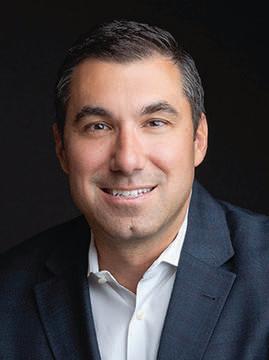

This material is presented for informational purposes only and should not be construed as individual financial advice. KeyBank does not provide legal advice. KeyBank is member FDIC. ©2023 KeyCorp.. CFMA #230111-1871633
KeyBank Michigan
David Mannarino
President & Commercial Sales Leader
KeyBank Michigan Market 248-204-6550
David_Mannarino @keybank.com
I’m
looking for a high-performance law firm.
A: Just as important as our legal knowledge and expertise, Maddin Hauser is focused on our culture at all levels of the organization. Our Executive Committee created what we call our Fundamentals, a core set of employee behaviors that we want all of our employees to adhere to, across the board. We rolled out our 28 Fundamentals to the entire firm at a retreat we had at the beginning of this year.
Our Fundamentals are printed on pocket cards that people can carry with them. For example, Fundamental #6 states: “Honor Commitments. Do what you say you’re going to do when you say you’re going to do it. This includes being on time for all phone calls, appointments, meetings, and other engagements. If a commitment can’t be fulfilled,
How
does Maddin Hauser achieve high performance for their clients?
notify others early, agree on and honor the new commitment.” This isn’t a goal or aspiration; it’s a fundamental principle of how we do business.
The notion is that if everyone in our law firm consistently practices these 28 Fundamental behaviors, our clients will have the best possible experience when they work with us, and new clients will want to hire us.
For over 50 years, Maddin Hauser has held an unwavering commitment to our clients and our founding principles. Serving our clients and delivering outstanding results through exceptional legal and business counsel gives us meaning, binds us together, and enables our firm to consistently perform at the highest level.
Maddin Hauser
Steven D. Sallen President and CEO
28400 Northwestern Hwy. Ste. 200 Southfield, MI 48034 248-827-1861
ssallen@maddinhauser.com
Globe Midwest Adjusters
International 400 Galleria Officentre Ste. 101 Southfield, MI 48034 248-352-2100
PROMOTIONAL CONTENT
Prime Roast
Biggby Coffee in Lansing continues to expand nationwide, unafraid of competing with Starbucks.
BY TIM KEENAN
Biggby Coffee, which started in East Lansing with a single store called Beaner’s Coffee in 1995, has grown into a formidable regional franchise with 344 locations in 11 states, along with six stores in Indonesia. It’s done so by focusing on product consistency, speed, and customer service.

Biggby’s co-founder, Bob Fish, came from the restaurant business and set up his shop utilizing the systems of a high-volume kitchen. “That helps us produce a really consistent product in an efficient, timely manner,” says Mike McFall, co-CEO of Biggby.
Co-founders Fish and Mary Roszel met while attending hospitality courses at Michigan State University and first worked together as managers of a Lansing-based restaurant chain known as the Flap Jack. Roszel has since retired.
The first Beaner’s location opened in April 1995 on Grand River Avenue in East Lansing, in a building previously occupied by an Arby’s.
“The other thing that we’ve worked very hard on is setting up a culture where people have the ability to thrive,” McFall says. “The biggest compliment we get is about the way our people treat customers. That doesn’t happen by accident, and that has been a huge focus of ours.”
McFall, who has been a full partner in the enterprise since 1998, started with the company as a barista in 1996.
“I was in East Lansing working on a research project and I went around to apply at all the coffee shops in the East Lansing area,” he recalls. “I applied and got hired at Biggby. At the time, I didn’t have any aspirations to be anything other than a barista, but (Fish) had built something really special and I started to sense that.”
About a year later, Fish came to McFall with an opportunity to join the company’s management team. After a four-hour walk around East Lansing on a “beautiful spring day,” the two shook hands and became equal partners.
By the end of the next year, there was a second store in Lansing, close to the Michigan State Capitol building. The corporate office was moved to Lansing, as well.
The company began to franchise in January 1999 and had four stores by the end of that year, all in the Lansing/East Lansing area.
Fast-forward to 2007, when the franchise had grown to between 60 and 70 stores. By that time, the company, still using its original Beaner’s name, started to hear rumblings of protests since the word “beaner” can be a slur against people of Hispanic origin.
“When my partner founded the original company, he didn’t know the name was offensive to anyone,” McFall says. “Fairly quickly thereafter, we started to hear about it. After a couple-year conversation, we decided to change the name and get it behind us. No one was forcing us to. There wasn’t any pressure to change the name, really. We just wanted to do it. It was the right thing to do.”
Fish said at the time, “As we’ve continued to expand into new markets, we’ve heard more and more comments about our name, to the point that we had to take a hard look at changing it. We ultimately felt we would be condoning the use of a disparaging term if we chose to do nothing. What matters most is that the store experience will be exactly the same, only our name will be different.”
McFall says it cost the company close to $1 million to change the name. “It was a major investment on our part,” he says. “Even though our franchise contract states that the franchisees are responsible for any intellectual property changes, we paid for the entire thing. That was a big chunk for us.”
Each store had about $10,000 in signage and the change was made in a matter of days. “We hired sign companies in all the different markets, and they could do two or three stores a day per truck, and a lot of these companies have multiple trucks,” McFall recalls.
The new name was derived from the large letter B in the company’s original logo.
Since then, Biggby’s has continued to expand. Most of its footprint is in the Midwest, but it has locations as far west as Meridian, Idaho; as far south as Ormond Beach, Fla.; and as far east as Virginia Beach, Va.
Taking it all in, last year Biggby Coffee’s more than 5,000 employees brewed 2.2 million pounds of coffee, went through 35.2 million cups, and processed more than 25 million transactions.
Every ounce of those 2.2 million pounds of coffee is roasted by Paramount Coffee in Lansing, which has been in business since 1937.
PRODUCTION RUN
Exec Life 78 DBUSINESS || March - april 2023 COURTESY BIGGBY COFFEE
COFFEE COHORT Biggby co-CEO Bob Fish co-founded Biggby Coffee in 1995, while co-CEO Mike McFall started with the company as a barista in 1996.
THE RUNDOWN
“They procure the beans that we ask them to procure, and they roast them to our exact specification,” McFall explains. “It’s a very detailed process. They’ve been an amazing partner for us.”
Paramount then distributes the ready-to-brew coffee to all of Biggby’s stores.


In addition to the beans that Paramount buys, Biggby is developing farm-direct relationships, buying directly from coffee farmers. Paramount still picks up and processes that coffee. McFall says about 23 percent of its coffee comes from farm-direct transactions.
For all of their success, McFall and Fish aren’t satisfied with where they currently stand in the coffee shop universe. McFall says there are signed contracts for more than 130 new Biggby stores to open in the next 12 to 18 months.

“The things that we’ve been working on for the last five years in many ways are all coming together right now,” McFall says. “We’re opening stores at an amazingly rapid clip.”
Approximately six years ago, Biggby started hiring area representatives to boost expansion and assist franchise owners in specific geographic areas. The company currently has 18 area representatives who help new franchisees find real estate, assist with marketing, and are involved with just about everything required to set up shop and get started. They’re rewarded by a percentage of the royalties generated by the outlets with which they work.
“These are franchise veterans who give us a very local connection to those geographic areas,” McFall says. “They can be a sounding board or a coach for that new franchise owner. We have really experienced people in the marketplace (who are) helping our franchise owners develop.”
Although Biggby is expanding rapidly, McFall says the company strives to manage the growth so it doesn’t get out of control.
“We don’t look to open in new states,” he says. “We’d prefer to open in places where we already are. Franchisers can get a little wayward if you open too many new stores in new markets. We’ve been very careful with that over the years.”
DECAFE DELIGHT
When asked if he considers Starbucks locations when deciding on real estate in a new market, McFall says, “They’re a factor, but they’re in the right places — so if you’re scared of competing, then what do you do? We’re certainly not scared to compete.”
25 million annual transactions 5,000+ employees 35.2 million of cups the company goes through each year
Barista Charles Solano (top), co-CEO Mike McFall and franchisee Jim Stewart (middle), and the company’s cups (bottom) are all focused on customer service.
2.2 million pounds of coffee brewed in 2022
Source: Biggby Coffee
Exec Life March - april 2023 || DBUSINESS.COM 79
Let’s Toast
When Detroit inventor George J. Schneider was granted a patent in 1906 for the forerunner of today’s pop-up toaster, he ignited a frenzy among manufacturers.
BY NORM SINCLAIR
For thousands of years, ever since bread was first made in the Middle East, bakers from the Stone Age up through the 19th century have been fascinated with inventing different ways to serve what has become the most popular accompaniment for almost every meal.
That lofty goal in cuisine was given a boost in 1906 when 35-year-old Detroiter George J. Schneider of the American Electrical Heater Co. registered the first American patent for an electric toaster that he described as an “electric cooker.”
Perhaps the earliest evidence of bread, and possibly toast, was unearthed by scientists at a 9,000-yearold site in Turkey where they found two buildings, each with large stone fireplaces containing chunks of charred breadcrumbs.
Those early bread-makers used flour they made from wild wheat and barley mixed with the crushed roots of plants. They added water before baking it on hot stones around an open fire. The crumbs found in the fireplaces could have been an indication of the efforts by prehistoric foodies to spark up the taste of their bread by toasting it.
Over the centuries, bread was toasted by using sticks, rods, and even spears to hold chunks over open fires.
Earlier attempts by 19th century inventors in England and the United States to toast bread produced patents for devices that were able to warm bread one slice at a time over heated electrical wires. Users, however, had to pay close attention to the toast, as these devices frequently became fire hazards that could burst into flames.
That problem was solved for Schneider by two inventors in Chicago. According to records in Harvard University’s Collection of Historical Instruments, around the same time that Schneider was tinkering with his electrical cooker invention, Albert L. Marsh, a metallurgist, and his employer, William Hoskins, a chemist in Chicago, invented a high-temperature resistance wire, or coil, made of nickel and chromium that could be used safely as a heating element suitable for maintaining the 370-degree heat needed for toasting bread.
Schneider’s submission to the U.S. Patent and Trademark Office described his creation as an electric cooker with a casing having parallel side walls, an
opening in one end, a pair of gratings arranged upon opposite sides of the opening within the casing, and heat conductors arranged in the space between the gratings and the adjacent sides of the casing. Bread slices were exposed to heat radiated through the openings in the grating.
Although there isn’t a record of Marsh and Schneider collaborating on Schneider’s toaster, it’s obvious both were working on their inventions at the same time. Marsh’s wire patent was filed five months before the patent for Schneider’s toaster was granted on July 17, 1906.

Shortly afterward, Hoskins moved his newly formed Hoskins Manufacturing Co. to Detroit. Ironically, while Schneider’s invention touched off a frenzy among dozens of companies and inventors to manufacture commercially viable toasters, the inventor never actually produced one.
Instead, in the years between 1905 and 1929, he went on a prolific run devising different inventions. In that period, he filed applications for 16 patents in the United States and six in Canada for a series of electric-related inventions such as heaters, sad-irons, stands for the irons, an electric branding iron, electric switches, heating elements and conductors for electrical instruments, a glove former, and an electrically heated instrument.
In some cases, he filed new patents for improvements he devised for some of his earlier creations.
BREAD AND BUTTER
What Detroit inventor George J. Schneider called the “electric cooker”paved the way for millions to enjoy a slice of toast with butter, jam, and most every food in between.
The Canadian patents were for inventions like the sad-irons and heaters he introduced in the U.S.
Three years after Schneider’s toaster patent was published, General Electric introduced the D-12 toaster invented by Frank Shailor, recognized as the first commercially successful electric toaster, while in 1921 a Minnesota mechanic, Charles Strite, created the first automatic pop-up toaster, a forerunner of today’s toaster found in homes and businesses all over the world.
While Schneider didn’t follow up on his patent for the toaster, it appears he commercially profited from his branding iron and possibly some of his other electrical inventions. A company he founded, Schneider Manufacturing Co., was described as making “meat branding devices and other tools.”
In the early 1900s, as Schneider churned out patents and inventions, the city earned the title of Detroit the Dynamic, according to Charles K. Hyde of Central Michigan University, writing in the Michigan Historical Review, which was published by the Historical Society of Michigan. From making cigars and locomotives to stoves and agricultural equipment, factories in Detroit were humming with production.
“The city’s industrialists achieved great success and national fame by manufacturing a wide spectrum of goods seldom remembered today as products of Detroit,” Hyde wrote. “The city was home to
PATENTS AND INVENTIONS
Exec Life 80 DBUSINESS || March - april 2023 GETTY IMAGES
substantial manufacturers of consumer goods such as shoes, tobacco products, paint and varnish, packaged seeds for flowers and vegetables, beer, pharmaceuticals, heating and cooking stoves, and big-ticket capital goods including ships and railroad cars.”
The city was also home to numerous iron and steel foundries, as iron ore was plentiful in the Upper Peninsula and was easily transported on the Great Lakes to Detroit, especially after the Soo Locks in Sault Ste. Marie opened in 1855. In addition to using their products in the manufacture of ships and railroad cars, a dozen companies making iron stoves earned the city the title of Stove Capital of the World, annually turning out more than 700,000 wood, gas, and electric stoves.
A 15-ton wooden replica of the popular Garland Stove was a fixture at the old Michigan State Fairgrounds in Detroit until it was destroyed by a fire attributed to a lightning strike in 2011, two years after the state shut down the fairgrounds (today the State Fair takes place annually over Labor Day weekend at the Suburban Collection Showplace in Novi).
Even as Schneider was at his prolific best — 14 inventions were registered with the U.S. Patent Office during this period — it also was a time of upheaval in his personal life. While The Detroit News’ digital archive contains the 1897 records of Schneider’s marriage license and wedding with his 21-year-old bride, Corrine M. Reynick, the Detroit Free Press archive chronicles her appearance in divorce court in 1906.
“Of all who came to avow their marriages a failure yesterday there was no figure half so attractive as that of Mrs. Corinne M. Schneider who asked to be freed from her husband, George J. Schneider. A stunning blue suit and hat trimmed with autumn foliage helped accentuate the youthful refinement of her face and form,” the court reporter observed.
“We were married seven years ago,” she told the court in an almost inaudible voice, “but about four years ago he, well, he simply began to get tired of his home, it had ceased to be attractive for some reason or other.”

Schneider’s last application for a patent was filed in December 1929; he described his invention as “an improvement in electrical switches on cables that connect electrical appliances, cooking utensils, flat irons, heating devices, and the like.”
Ironically, according to The Detroit News’ archive, that patent appears to have been granted and published posthumously on Dec. 1, 1932.
The last reference to a George J. Schneider in the digital newspaper library record is a story about a Detroit manufacturer who was killed in January 1932 when his car drove off the road at a curve on M-43 and overturned in Barry County.






According to the newspaper report, the 60-yearold Schneider was in the rural county on a hunting trip. He was survived by a son, two brothers, four sisters, and the gratitude of millions of people for contributing ideas and inventions that made their daily lives more efficient and enjoyable.


SMART GRID
In addition to making life in the kitchen easier, Schneider was a pioneer in connecting multiple appliances via electrical switches.




Exec Life March - april 2023 || DBUSINESS.COM 81 NATIONAL REGISTRY
Hire Ground
How industry professionals can advance their hiring programs during the commercial real estate talent crunch.
According to bisnow.com, between 60 percent and 70 percent of all commercial real estate firms in the United States were facing a talent shortage or a labor challenge in 2021. The picture hasn’t gotten any more favorable in recent months, as ongoing staffing challenges in a tight labor market remain high on the list of headaches for many commercial real estate companies.
BY ANDY GUTMAN
estate experience may not translate directly to retail, but there are quite a few skills that do carry over.
Partner up
One of the things the team at the Farbman Group is most excited about is a new partnership with Detroit Cristo Rey High School. Under the program, local high school students will have an opportunity to get time off from school during the week to work in a













































morale high and makes employees feel seen and valued. Make sure recognition extends across the company, from the C-Suite to entry-level team members and support staff.
Culture cash
To boost hiring and retention, it’s critical to not only upgrade recruiting and hiring practices, but to encourage a culture of positivity and connectivity. A supportive and social environment fosters the kind of connections and relationships that carry real weight when employees make professional decisions. Get creative and mix things up with meals and entertainment that give teams lots of regular opportunities to engage outside of the workplace.
The Farbman Group, a full-service commercial real estate firm in Southfield, is hardly alone in concluding that business-as-usual wasn’t going to be enough to compensate for the historic disruption of the pandemic, and the larger structural forces contributing to the industry’s staffing difficulties.

As a result, there’s a clear, industrywide need to rethink how to attract, recruit, and retain new talent in a post-pandemic world. We need innovative tactics, new ideas, and a bold approach to recruiting and retention that starts early and continues throughout the arc of an employee’s career.


Below are a few of the most effective tools and tactics the Farbman Group has developed to attract and retain new hires, and inspire them to pursue commercial real estate as a career.
Beat the bushes
Leave no stone unturned when it comes to getting the word out to potential candidates. In a tough hiring landscape, volume can help make up for scarcity. Possible options include everything from posting job opportunities on all available hiring platforms to paying recruiters. Share hiring messaging through LinkedIn and other social media channels. Reach out to colleagues in the industry to ask for references or leads. Sometimes the direct approach works, especially with a good referral program that compensates employees who help find qualified people.
Jump into the pools
Fishing in nontraditional talent pools is a great way to land a keeper. The Farbman Group has had some notable successes finding people who are making career changes or moving from one real estate sector to another. Multifamily or residential real
paid internship position. For the first time in a long time, growing numbers of younger people are coming into the industry — and the more opportunities to introduce those young people to the commercial real estate business, the better.
Stay flexible
The Farbman Group takes their internship program very seriously. However, they also understand that they need to be flexible and accommodating so both interns and the company can get the most value out of the program. Consider letting summer interns contribute remotely or in a reduced capacity, so they can continue the relationship when they start school. Allowing interns scheduling and structural flexibility helps maintain those connections and transitions high school and college students in training to fulltime employees. It’s an approach that has recently given the Farbman Group its best recruiting class ever.
Mentorship
Make sure internship programs and support for new hires includes elements of mentorship and connectivity. New or prospective employees also should feel like they’re truly part of the team. Planned social events, one-on-one sessions, and time with senior leadership are great ways to spark excitement and strengthen bonds. Consider implementing cross-generational peer support programs that pair younger employees with experienced professionals to encourage knowledge-sharing as well as social and professional support.
Say thank you
Meaningful employee recognition pays dividends. Recognizing great effort and work with both tangible rewards and public recognition keeps
The confluence of a pandemic and a lean labor market may have led to historic hiring and retention challenges, but it’s also created a real opportunity for commercial real estate firms to dramatically boost their culture and their talent pipeline.
The more that companies can be creative and consistent — and unafraid to think outside the box and commit to big changes — the better the outcome
consistent — to and — the the the whole industry.
Collectively, we can more people excited the business the proopportunities the commercial estate.
OPINION COURTESY IDENTITY PR/FARBMAN GROUP Exec Life 82 DBUSINESS || MARCH - APRIL 2023
ANDY GUTMAN
Gutman is president of Farbman Group, a full-service commercial real estate firm in Southfield with operations across the Midwest. He oversees more than 25 million square feet of commercial real estate space and 200-plus employees.
MAKE SURE INTERNSHIP PROGRAMS AND SUPPORT FOR NEW HIRES INCLUDES ELEMENTS OF MENTORSHIP AND CONNECTIVITY.”
ALONG THE SILK ROAD: THE MUSIC OF THE LEVANT
March 4, 8 p.m. - 11 p.m., Ford Community and Performing Arts Center, 15801 Michigan Ave., Dearborn, MI araborchestra.org

The National Arab Orchestra and Maestro Michael Ibrahim perform with singers Nai Barghouti and Mohannad Mshallah as they present: Along the Silk Road: The Music of the Levant, a program that celebrates the vibrant melodies of the Levant.
ROLE MODEL CELEBRATION
March 8, 6 p.m. - 9 p.m., The Henry Ford, 20900 Oakwood Blvd., Dearborn, MI alternativesforgirls.org/events/2023-role-model-celebration

Join us and celebrate International Women’s Day with Alternatives for Girls!
In 1987, AFG began as a community effort to support girls and young women in southwest Detroit. Local residents, clergy, and business leaders came together out of concern about the alarming increases in drug use, homelessness, sex work, and street activity. This group of citizens wanted to do something, and they did just that. They changed the trajectory of the lives of so many who felt lost, alone, and afraid — and, with that, created a place we know now as Alternatives for Girls.
Today, AFG remains true to its mission as it empowers at-risk girls and young women to thrive after experiencing trauma from homelessness, violence, and exploitation in Detroit and its surrounding communities. The celebration will include an opportunity to bid on various auction items while making an impact.
HARRY TOWNSEND’S LAST STAND

March 22 - April 16, Check box office for times, Meadow Brook Theatre, 378 Meadow Brook Road, Rochester Hills, MI mbtheatre.com
Sometimes it’s harder to like someone than it is to love them. Meet Harry Townsend, an incurable romantic and irascible charmer whose sharp mind and dry wit are at the center of this new play. As his prodigal son Alan returns home, the visit raises the complexities of their relationship, placing father and son at odds. Harry Townsend’s Last Stand is a must-see new play about the inescapable ups and downs of family.
*Michigan premiere. MBT rating: high school & up.
44TH ANNUAL SALUTE TO DISTINGUISHED WARRIORS DINNER
March 23, 5:30 p.m. - 9 p.m., Detroit Marriott at the Renaissance Center, 400 Renaissance Drive West, Detroit, MI deturbanleague.org/sdw-detail
The 2023 Distinguished Warriors celebration will be held at the Detroit Marriott at the Renaissance Center starting with a VIP reception at 5:30 p.m. The dinner and program will begin at 6:30 p.m. We are pleased to share that our 2023 Distinguished Warriors honorees are: the Hon. Brenda Lawrence, retired United States congresswoman; Shirley Stancato, vice chair of the Wayne State University board of governors and retired president and CEO of New Detroit Inc.; David Hecker, president and CEO of the American Federation of Teachers Michigan; Rory Gamble, retired UAW president; and Monica L. Martinez, posthumously, former senior vice president of national community affairs for Comerica Bank.
TC BUSINESS EXCELLENCE AWARDS, PRESENTED BY HORIZON BANK
March 2, 8:30 a.m., MSU Management Education Center, 811 W. Square Lake Road, Troy, MI troychamber.com/chamber-events/


The Troy Chamber of Commerce is excited to once again host the TC Business Excellence Awards, presented by Horizon Bank, for 2023. This event has been virtual in previous years but will be in person this year at the MSU Management Education Center.


The TC Business Excellence Awards give the Troy business community the opportunity to nominate an individual or company that they feel has made a notable impact on the business community in 2022. A wide variety of categories are featured to recognize achievements in every facet of the workplace. Nominated individuals or businesses must be a Troy Chamber member, but anyone can vote. The recipients of the 2023 TC Business Excellence Awards will be announced on Thursday, March 2, at the MSU Management Education Center.
DETROIT HISTORICAL SOCIETY’S 100TH ANNIVERSARY CELEBRATION
April 29, 6:30 p.m., Detroit Historical Museum, 5401 Woodward Ave., Detroit, MI detroithistorical.org/things-do/events-calendar/events-listing/100th-anniversary-celebration
Join the Detroit Historical Society and co-Chairs Jennifer Granger, Leslye Rosenbaum, Linda Schlesinger-Wagner, and Lois Shaevsky for the 100th Anniversary Celebration on Saturday, April 29, from 6:30 to 10:30 p.m. at the Detroit Historical Museum. Themed “Celebrating Detroit through the Decades,” the event will shine a spotlight on 100 years of collecting, sharing, and preserving Detroit’s history. The evening will include a strolling dinner and dessert reception throughout the museum, a silent auction and raffle, and various entertainment experiences, including period actors bringing museum exhibits to life. The VIP reception will kick off the evening at 5:30 p.m. with a special ceremony honoring Detroit legends as they place their handprints and signatures into cement casts for permanent display at Legends Plaza. Net proceeds from the event will support educational programs and the 2024 millage campaign efforts. For tickets or more information, visitdetroithistorical.org.
EVENTS AND OPPORTUNITIES
DBUSINESS ADVERTISEMENT
SPONSORED BY
TOAST OF THE TOWN

PATRICK GLORIA
The Novi Chamber of Commerce hosted the 2023 Toast of the Town Business Awards Gala on Feb. 4 at the Suburban Collection Showplace in Novi. The theme of the event was “A Night in Monte Carlo,” and guests enjoyed hors d’oeuvres, dinner, gaming, a silent auction, an open bar, and dancing. The charity partner, which receives a portion of the proceeds, was Jessica’s Splashpad, an effort to build a community splashpad at Novi’s Bosco Park dedicated to the late Jessica Star-Rose of FOX 2 Detroit.














1. Jason Smith, Shailee Patel, Tom Smith
2. Joi Durant, Melinda Mims, Van Nguyen

3. Jonathan and Stephani Fleezanis


4. Michael and Michelle Badali, Marie and Michael Kosal
5. Melissa and Derek Kevra
KIDS GALA
PATRICK GLORIA
KIDSgala, a 501(c)(3) nonprofit organization in Northville, hosted its eighth annual charity event on Jan. 28 at The Townsend Hotel in downtown Birmingham. Guests dressed in winter white and enjoyed food stations, entertainment, a hosted bar, entertainment by Jared Sykes, a 52-card raffle for a lease on a new Cadillac, and a silent auction. Funds raised support the organization’s mission of providing gifted celebrations for children who experience life-altering disabilities and illnesses.
6. Chris Williams, Suzy Hahn, Greg Dumbrowski

7. Jennifer Dewey, Elke Devos, Nicole Steffens
8. Aaron and Suzie Cozart
9. Karen Buscemi, Ann Duke







10. Kayleigh Ehret, Kimberly Britt
LUNCH AND LEARN
PATRICK GLORIA
The Southeast Michigan Chamber of Commerce in Mount Clemens hosted its monthly luncheon on Jan. 27 at Louis’ Chop House in New Baltimore. The event featured Mark Hackel, Macomb County executive, as the keynote speaker, along with networking opportunities and a plated lunch. The chamber is a nonprofit organization that brings together business, civic, and government leaders to help build and enhance local communities.
11. Donna Weatherby, John Johnson, Pamela Lawicki
12. Kristine Mack, Hugh W. Smith, Matt Allen, Marli Blackman
13. Charles Reinhold, Justin Reinhold
14. Mary and Ron Lamparter
Exec Life 84 DBUSINESS || March - april 2023 1 2 3 4 5 6 7 8 9 10 11 12 13 14 15
15. Ret. Brig. Gen. John Slocum, Mark Hackel
ACG DETROIT
PATRICK GLORIA
The Association for Corporate Growth (ACG) Detroit, a nonprofit business organization, hosted its annual economic update on Jan. 24 at the Ford House in Grosse Pointe Shores. The event featured keynote speaker John Caldwell, executive director and investment specialist at J.P. Morgan Private Bank, who discussed interest rate increases, market volatility, a slowdown in M&A activity, and uncertainty regarding a potential recession in 2023.
1. John Pollock, Jeff Wyatt, Jeffrey Pitts

2. Jeanette Anderson, Sergio Gutierrez, Carrie Schochet
3. Carl Rivera, Julie Nowicki

4. Andrea Eimers, Ida Byrd-Hill, Jason Tinsley

5. Garret Fagnoli, Lisa Haines, Christopher Barrett

FUTURE LEADERS
PATRICK GLORIA
Entrepreneur Organization (EO) Detroit, a nonprofit business organization in Detroit, hosted the local Global Student Entrepreneur Awards on Jan. 19 at Walsh College in Troy. The event featured networking, presentations from student entrepreneurs competing for $5,000, and “lemonade stand” style booths, where members’ kids shared and sold products. Jerry Kozak, founder of Detroit T-Shirt Co., delivered a speech.
6. Brendan Schochet, Alexis Markham
7. Carolina Hernandez Ruiz, James Hamer, Dario Lucci, Jacob Alihan Kapusansky

8. Carolina Hernandez Ruiz, Ruie Hall
9. Dario Lucci, Sarah Rappaport, Nina Lucci, Sonia Lucci



10. Paul Glantz, Harper Allen, Ruby Allen, Mia Schochet

MINORITY SUPPORT




PATRICK GLORIA
The DBusiness Breakfast Series hosted a session on scaling minority-owned companies on Feb. 7 at the Gem Theater in downtown Detroit. The event featured a strolling breakfast and networking before a panel discussion led by Ken L. Harris, president and CEO of the National Business League. The discussion centered around the obstacles faced by minority-owned businesses when scaling — including a lack of access to capital — and how to solve the problems.

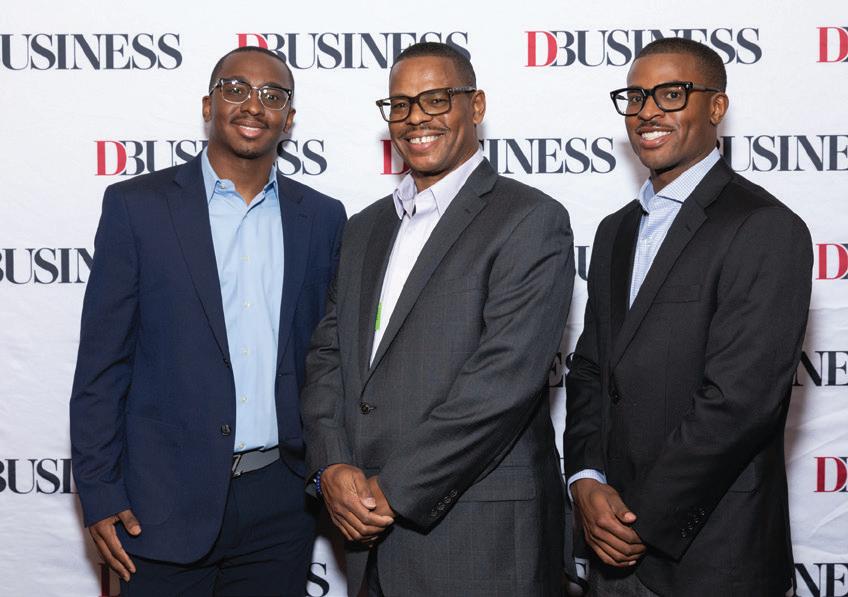
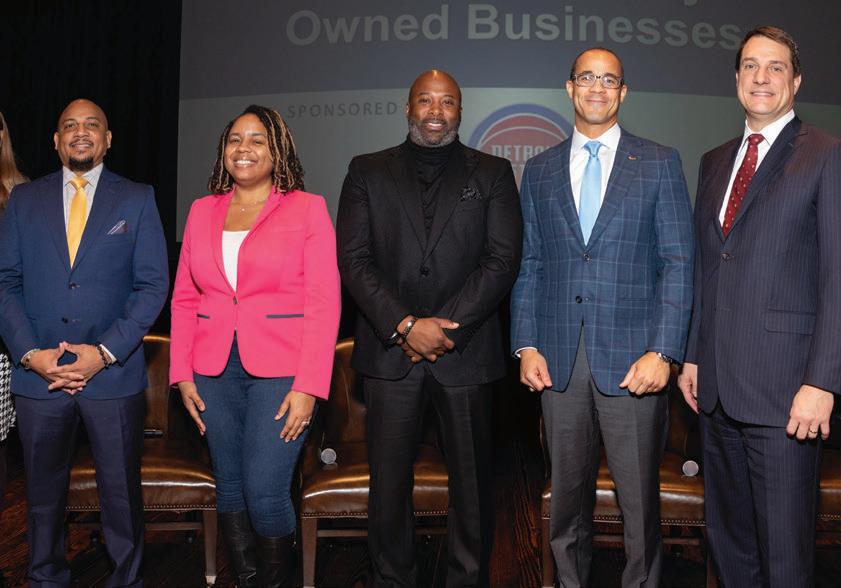
11. Austin Moore, Roderic Moore, Ross Moore
12. Ken Harris, Racheal Allen, Larry Brinker Jr., Ron Hall, Lawrence Garcia




13. Dan Ringo, Derron Sanders, Derrick Meeking
14. Griffin Marinez, Laurie Sall, Frank Venegas Jr.

15. Kellie Crawford, Priscilla Perkins


Exec Life March - april 2023 || DBUSINESS.COM 85 1 2 3 4 5 6 7 8 9 10 11 12 13 14 15
TOP UNDERGRADUATE BUSINESS SCHOOLS IN METRO DETROIT 2023
BAKER COLLEGE
CADILLAC, MUSKEGON, OWOSSO, JACKSON, ROYAL OAK | Private, Not-for-profit
Undergrad programs: Bachelor’s and 4+1 accelerated BBA/MBA degree programs including accounting, business administration, finance, human resource management, information technology, logistics, marketing, and more. Over 40 programs are offered 100 percent online. Transfer students can apply at no cost. baker.edu; 855-487-7888
CLEARY UNIVERSITY
DETROIT, HOWELL | Private
Undergrad programs: BBA programs including business communication, business ethics, business management, corporate accounting, corporate finance, digital marketing, human resource management, nonprofit management, project management, public accounting, and sports promotion and management. cleary.edu; 800-686-1883
CONCORDIA UNIVERSITY
ANN ARBOR | Private Christian University
Undergraduate programs: BBA and BA programs in management and analytics and change management, health care management, human resource management, public service – leadership, public service – management of criminal justice, and accounting. cuaa.edu/business; 734-995-7527
DAVENPORT UNIVERSITY
DETROIT | Private
Undergrad programs: BBA programs that focus on accounting, accounting fraud investigation, industrial project management, human resource management, general business, finance, management, marketing, and sports management. Associate degrees in business administration are available in finance, human resources, accounting, and general business administration. davenport.edu; 800-686-1600
EASTERN MICHIGAN UNIVERSITY
YPSILANTI
Undergrad programs: BBAs in general business, international business –accounting information systems, accounting, computer information systems, economics, entrepreneurship, finance, management, marketing, and supply chain management. An undergraduate certificate in business analytics is also available. emich edu; 734-487-1849
HENRY FORD COLLEGE DEARBORN
Undergrad programs: Associate degrees in 150 programs including business, health sciences, nursing, STEM, and liberal arts fields.
Bachelor’s degree in culinary arts. hfcc edu; 800-585-4322
LAWRENCE TECHNOLOGICAL UNIVERSITY
SOUTHFIELD | Private
Undergrad programs: BBAs with concentrations in business administration, accounting, finance, general business, information technology, marketing, and business data analytics.
ltu edu; 248-204-4000
MACOMB COMMUNITY COLLEGE
CLINTON TOWNSHIP, WARREN
Undergrad programs: Associate degree in business administration is available with concentrations in accounting,
business communications, business management, contruction management, entrepreneurship, small business management, general business, global supply chain management, hospitality management, marketing, project management, and restaurant management. macomb edu; 586-445-7512
MADONNA UNIVERSITY
LIVONIA | Private
Undergrad programs: Bachelor’s degrees in accounting, business administration, and sports management. madonna edu; 734-432-5339
MICHIGAN STATE UNIVERSITY
EAST LANSING
Undergrad programs: Bachelor’s degrees in accounting, finance, hospitality, human resource management, marketing, management, and supply chain management. broad msu edu; 517-355-7605
NORTHWOOD UNIVERSITY
MIDLAND | Private
Undergrad programs: Bachelor’s degrees in accounting, aftermarket management, automotive marketing management, entrepreneurship, e-sports management, economics, computer science, cybersecurity management, finance, health care management, hospitality management, marketing, operations and supply chain management, sports management, and more. northwood edu; 800-622-9000
OAKLAND COMMUNITY COLLEGE
AUBURN HILLS, FARMINGTON HILLS, ORCHARD RIDGE, ROYAL OAK, SOUTHFIELD, WATERFORD TOWNSHIP
Undergrad programs: Associate degrees in business administration, accounting, computer information systems, culinary arts, health care administration, international
commerce, management development, and more. oaklandcc edu; 248-341-2000
OAKLAND UNIVERSITY
ROCHESTER HILLS
Undergrad programs: Bachelor’s degrees in accounting, actuarial science, economics, finance, general management, human resource management, management information systems, marketing, operations management. Also home of the Southeastern Michigan Economic Data Center, and the Center for Data Science and Big Data Analytics. oakland.edu/business; 248-370-3360
ROCHESTER UNIVERSITY
ROCHESTER HILLS | Private
Undergrad programs: Bachelor’s degrees in accounting, computer information systems, information systems – programming, management, nonprofit management, sports management, sports management –e-sports and gaming administration, and strategic leadership. Computer information systems, management, and strategic leadership are offered in RU’s accelerated degree completion format. rochesteru edu/business; 248-218-2000
SCHOOLCRAFT COLLEGE
LIVONIA, GARDEN CITY
Undergrad programs: Associate degrees in accounting, general business, business administration,
business information technology, computer information systems, cosmetology management, economics, finance, real estate property management, supply chain management, and more. schoolcraft edu; 734-462-4426

UNIVERSITY OF DETROIT MERCY DETROIT | Private
Undergrad programs: BBAs in accounting or general business, with concentrations in accounting, business law, decision sciences, finance, human resources management, social entrepreneurship, international business, management, marketing, business intelligence, and sports management. Students can qualify for an accelerated, five-year BSBA/MBA program. udmercy.edu; 313-993-1245
UNIVERSITY OF MICHIGAN ANN ARBOR
Undergrad programs at the Ross School of Business: Bachelor’s in accounting, business economics and public policy, finance, business law, business communication, management and organizations, and technology and operations. michiganross.umich.edu; 734-764-7433
UNIVERSITY OF MICHIGAN DEARBORN
Undergrad programs: BBAs with majors in accounting, digital marketing, finance, general business, human
SCHOOLCRAFT COLLEGE LIVONIA COURTESY SCHOOLCRAFT COLLEGE From the Top 86 DBUSINESS || March - april 2023
resource management, information systems management, marketing, small business management, and supply chain management. umdearborn.edu/cob; 313-593-5460
UNIVERSITY OF PHOENIX
DETROIT
Undergrad programs: Bachelor’s in business and business management. phoenix.edu; 313-324-3900
WALSH COLLEGE
TROY | Private
Undergrad programs: Online and on-campus bachelor’s programs in accountancy, finance, general business, human resource management, management, marketing, applied management, and information technology. walshcollege.edu; 248-823-1600
WAYNE STATE UNIVERSITY
DETROIT
Undergrad programs at the Mike Ilitch School of Business: Bachelor’s degrees with concentrations in accounting, entrepreneurship and innovation, finance, global supply chain management, information systems management, management, and marketing. ilitchbusiness.wayne.edu; 313-577-4505
Sources: Listings reflect programs offered by a college’s business school, where such business schools exist. This list does not include certificate programs or minors. All universities are public unless otherwise noted.
TOP GRADUATE BUSINESS SCHOOLS IN METRO DETROIT 2023
BAKER CENTER FOR GRADUATE STUDIES
CADILLAC, MUSKEGON, OWOSSO, JACKSON, ROYAL OAK | Private Graduate programs: MBAs in accounting, business administration, business intelligence, finance, health care management, human resource management, information systems, and leadership studies. baker.edu; 855-487-7888
CLEARY UNIVERSITY
DETROIT, HOWELL | Private Graduate programs: MBA and MS degrees are offered 100 percent online. Master’s degree focuses include analytical efficiency, financial planning, health care leadership, strategic leadership, women’s leadership, human resources management, and culture, change, and leadership. cleary.edu; 517-338-3315
CONCORDIA UNIVERSITY
ANN ARBOR | Private Christian University
Graduate programs: A doctorate in business administration (DBA) is available, along with MBAs with specializations in accounting, communications and public relations, finance, health care administration, human resources management, information science and digital technologies, innovation and entrepreneurship, leadership, management, management information systems, nonprofit management and public administration, sports and entertainment business, and more. cuaa.edu/business; 734-995-7527
DAVENPORT UNIVERSITY
DETROIT | Private Graduate programs: MBA programs with specializations in general business, administration and finance, health care management, human resource management, managerial accounting, marketing, data mining, leadership strategies, predictive analytics and data visualizations, and
strategy management. A Master of Management is available, along with a Master of Accountancy. davenport.edu; 800-686-1600
EASTERN MICHIGAN UNIVERSITY
YPSILANTI
Graduate programs: MBAs with 14 different areas of specialization; MS degrees in accounting, arts administration, clinical research administration, finance, human resources management and organizational development, information systems, integrated marketing communications, taxation, and more. emich.edu/cob; 734-487-0042
LAWRENCE TECHNOLOGICAL UNIVERSITY
SOUTHFIELD | Private Graduate programs: MBA programs are offered both online and on campus with concentrations in business administration, architecture, engineering management, information technology, and business data analytics.
Students also have the option to pursue a general MBA where they can choose any combination of three graduate-level elective courses, providing the broadest range of knowledge. ltu.edu; 248-204-3160
MADONNA UNIVERSITY
LIVONIA | Private
Graduate programs: MBA offered in business administration and MS offered in accountancy, business leadership, and health services administration. madonna.edu; 734-432-5354
MICHIGAN STATE UNIVERSITY
EAST LANSING
Graduate programs: MBA programs offered in person, online, or hybrid. Full-time MBA programs in accounting; business administration; business analytics; finance; health care management; management, strategy, leadership; and marketing research.
Executive education: Executive MBA offered in Troy, East Lansing, and
online one weekend/month. A wide range of non-degree, open-enrollment programs are available, specializing in business tools and techniques, finance, leadership, and more.
Full-time MBA: 517-355-7604
Executive MBA: 517-355-7603
Executive Development Programs: 517-353-8711 msu.edu; 517-355-1855
NORTHWOOD UNIVERSITY –DEVOS GRADUATE SCHOOL
MIDLAND | Private Graduate programs: Accelerated, online, and evening MBA programs; MS in organizational leadership, business analytics, finance, and a Doctor of Business Administration are offered. devos.northwood.edu; 800-622-9000
OAKLAND UNIVERSITY
ROCHESTER HILLS
Graduate programs: Online and on-campus master’s programs include 100-percent online MBAs, part-time MBAs geared for working professionals, weekend executive MBAs for experienced professionals, and a Master of Accounting. MS degrees are offered in business analytics and information technology management. Graduate certificates include business analytics, finance, FinTech, human resource management, information security management, leadership, and marketing.
Executive education: Career-advancing educational opportunities available.
MBA: oakland.edu/business; 248-370-3287
PACE: oaklande.edu/pace; 248-370-3177
UNIVERSITY OF DETROIT MERCY
DETROIT | Private
Graduate programs: An MBA program geared toward working professionals is offered evenings and weekends, and may be completed in one year with a full-time class schedule. Concentrations include business administration and health services administration. Certificates in ethical leadership and business turnaround management are offered. Dual-degree programs are also available in law, computer and information systems,
and health services administration. business.udmercy.edu; 313-993-1245
UNIVERSITY OF MICHIGAN
ANN ARBOR
Graduate programs at the Ross School of Business: Full-time MBA program; part-time evening, online, and weekend MBA programs; and an executive MBA program are available in Ann Arbor. The school also offers master’s degrees in management, accounting, and supply chain management.

Executive education: There are a wide range of customized and open-enrollment programs designed to develop individual specializations and strengthen organizations. MBA: michiganross.umich.edu; 734-615-5002
Executive education: michiganross.umich.edu/programs/ executive-education; 734-763-1000
UNIVERSITY OF MICHIGAN DEARBORN
Graduate programs: Earn master’s degrees with courses available weekday evenings, online, or through a combination of the two. MBA and MS programs are offered in accounting, business administration, business analytics, finance, information systems, marketing, and supply chain management. Dual-degree options are also available. umdearborn.edu/cob/ grad-programs; 313-593-4776
WALSH COLLEGE TROY
COURTESY WALSH COLLEGE From the Top March - april 2023 || DBUSINESS.COM 87
UNIVERSITY OF PHOENIX
DETROIT
Graduate programs: Master of Business Administration online and in person, along with a Master of Management. phoenix.edu; 313-324-3900
WALSH COLLEGE
TROY | Private Graduate programs: Online and on-campus master’s programs including a Master of Business Administration, four MBA dual-degree programs, a cyber MBA, the Walsh/ Kettering tech MBA, and the INSOFE International Tech MBA with a concentration in data science. MS programs include accountancy, data analytics, finance, information technology and IT leadership,
management, marketing, and taxation. A Doctor of Business Administration is available.
Executive education: Custom training including professional development, test prep, and continuing education for business certifications. walshcollege.edu; 248-823-1600
WAYNE STATE UNIVERSITY DETROIT
Graduate programs at the Mike Ilitch School of Business: MBAs offered part-time and evenings, with 13 concentrations available online or on-site in accounting systems, entrepreneurship and innovation, sports and entertainment management, and health care supply chain management. The school also offers master’s degrees in accounting,
finance, data science and business analytics, and automotive supply chain management. Ph.Ds. are also available. ilitchbusiness.wayne.edu; 313-577-4723
Sources: Listings reflect programs offered by a college’s business school, where such business schools exist. This list does not include certificate programs or minors. All universities are public unless otherwise noted.
TOP 10 MORTGAGE LENDERS IN METRO DETROIT
1. ROCKET MORTGAGE CO.
1050 Woodward Ave. Detroit 800-610-5499
quickenloans.com
Top local executives: Dan Gilbert, founder and chairman; Bob Walters, CEO
Total residential loan volume (2022): $114B (through 3Q22)
Total residential loan volume (2021): $351B
Loans closed (2022): NA
Loans closed (2021): NA
2. UNITED WHOLESALE MORTGAGE 585 South Blvd. E Pontiac 800-981-8898 uwm.com
Top local executive: Mat Ishbia, president and CEO
Total residential loan volume (2022): $102.2B (through 3Q22)
Total residential loan volume (2021): $226.5B
Loans closed (2022): 277,757 (through 3Q22)
Loans closed (2021): 654,450
3. SUCCESS MORTGAGE PARTNERS 1200 S. Sheldon Rd., Ste. 150 Plymouth 734-259-0880
successmortgagepartners.com
Top local executive: Allison Johnston, president
Total residential loan volume (2022): $2.07B
Total residential loan volume (2021): $3.049B
Loans closed (2022): 7,689
Loans closed (2021): 13,102
4. MORTGAGE 1 INC. 43456 Mound Rd. Sterling Heights 866-532-0550 mortgageone.com
Top local executives: Mark Workens, CEO; Rick Holcomb, president
Total residential loan volume (2022): $1.163B
Total residential loan volume (2021): $2.004B
Loans closed (2022): 5,551
Loans closed (2021): 10,068
5. TOWNE MORTGAGE CO. 2170 E. Big Beaver Rd., Ste. A Troy 888-778-9700
townemortgage.com
Top local executive: Mark Janssen, CEO
Total residential loan volume (2022): $1.03B
Total residential loan volume (2021): $2.3B
Loans closed (2022): 4,081
Loans closed (2021): 9,633
Total residential loan volume (2021): $436M
Loans closed (2022): NA
Loans closed (2021): 2,060
9. HORIZON FINANCIAL GROUP
A division of First Securities Financial Services 30150 Telegraph Rd., Ste. 320 Bingham Farms 248-538-7162 horizonfinancialgroup.com
Top local executive: Joshua M. Rubin, president
Total residential loan volume (2022): $52.6M
Total residential loan volume (2021): $132.18M
Loans closed (2022): 183
Loans closed (2021): 483
10. ONE STOP FINANCIAL GROUP 2615 W. 12 Mile Rd. Berkley
248-255-5429 onestopfinancialgroup.com
Top local executive: Jason Glass, president
Total residential loan volume (2022): $37M
Total residential loan volume (2021): $46.1M
Loans closed (2022): 85
Loans closed (2021): 152
*Did not respond to inquiries.
Source: DBusiness research
TOP 20 HOME BUILDERS IN METRO DETROIT (RANKED
1. PULTE HOMES 2800 Livernois, Bldg. D, Ste. 320 Troy
248-647-2750 Permits: 452
Permit value: $139.1M
8. CLEARVIEW HOMES 445 S. Livernois Rd., Ste. 324 Rochester Hills
248-275-6992
Permits: 67
Permit value: $15.6M
Permits: 27
Permit value: $9.5
15. INFINITY HOMES AND CO. 42400 Grand River Ave., Ste. 112 Novi 248-449-8084
6. JOHN ADAMS MORTGAGE CO. 25800 Northwestern Hwy., Ste. 110 Southfield 248-208-3902 johnadamsmortgage.com
Top local executive: Larry Bsharah, president
Total residential loan volume (2022): $529.6M
Total residential loan volume (2021): $721.7M
Loans closed (2022): 2,028
Loans closed (2021): 2,814
7. CAPITAL MORTGAGE FUNDING 17170 W. 12 Mile Rd. Southfield 248-569-7283 lowrateonline.com
Top local executive: Harry J. Glanz, president and co-founder
Total residential loan volume (2022): $319.9M
Total residential loan volume (2021): $467.9M
Loans closed (2022): 1,333
Loans closed (2021): 1,991
8. ROSS MORTGAGE CORP.* 2075 W. Big Beaver Rd., Ste. 700 Troy 248-968-1800 rossmortgage.com
Top local executive: Tim Ross, CEO
Total residential loan volume (2022): NA
2. LOMBARDO HOMES 13001 23 Mile Rd., Ste. 200 Shelby Township 586-781-7900
Permits: 335
Permit value: $92.8M
3. M/I HOMES OF MICHIGAN 40950 Woodward Ave., Ste. 204 Bloomfield Hills 248-836-4522
Permits: 230
Permit value: $84.2M
4. TOLL BROTHERS 26200 Town Center Dr., Ste. 200 Novi
248-305-4000
Permits: 90
Permit value: $36.6M
5. ROBERTSON BROTHERS HOMES 6905 Telegraph Rd., Ste. 200 Bloomfield Hills 248-657-4968
Permits: 101
Permit value: $25.6M
6. NINO HOMES INC. 2553 23 Mile Rd. Shelby Township 586-254-3232
Permits: 70
Permit value: $22.03M
7. MJC COS. 46600 Romeo Plank Rd., Ste. 5 Macomb 586-263-1203
Permits: 39
Permit value: $18.7M
9. WINDMILL GROUP INC. 31333 W. 13 Mile Rd., Ste. 200 Farmington Hills 248-538-7000
Permits: 45
Permit value: $14.4M
10. ACADIA HOMES 55110 Wolverine Dr. Macomb 586-789-9123
Permits: 25
Permit value: $10.92M
11. WADE JURNEY HOMES (CENTURY COMMUNITIES) 41210 Bridge St. Novi 248-621-2895
Permits: 43
Permit value: $10.9M
12. TRE HOMES 52188 Van Dyke Ave., Ste. 408 Shelby Township 248-812-9186
Permits: 25
Permit value: $10.5M
13. XL BUILDERS 3500 Gidding Rd. Lake Orion 610-644-1341
Permits: 44
Permit value: $10.1M
14. BELLA HOMES 3509 Heron Ridge Dr. Rochester Hills 248-373-4142
Permits: 63
Permit value: $9.2M
16. VESTA HOMES INC. Fraser 586-889-8130
Permits: 30
Permit value: $7.9M
17. PALAZZOLO BROTHERS 3737 Cherry Creek Ln. Sterling Heights 586-739-9162
Permits: 21
Permit value: $7.4M
18. HUNTER PASTEUR 32300 Northwestern Hwy., Ste. 230 Farmington Hills 248-539-5511
Permits: 26
Permit value: $5.4M
19. PREMIER CONSTRUCTION CO. 34975 W. 12 Mile Rd. Farmington Hills 248-324-5000
Permits: 22
Permit value: $5.2M
20. EUREKA BUILDING CO. 5960 Livernois Troy 248-564-6010
Permits: 27
Permit value: $4.5M
Source: Home Builders Association of Southeastern Michigan
BY 2022 PERMIT VALUE)
From the
88 DBUSINESS || March - april 2023
Top
TOP CIRCUIT COURT JUDGES



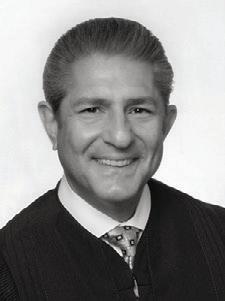
















 WAYNE COUNTY – DETROIT
OAKLAND COUNTY – PONTIAC
MACOMB COUNTY – MOUNT CLEMENS
HON. BRIDGET MARY HATHAWAY 3rd Circuit Court
HON. JULIE A. MCDONALD 6th Circuit Court
HON. RICHARD L. CARETTI 16th Circuit Court
HON. JACOB J. CUNNINGHAM 6th Circuit Court
HON. DAVID A. GRONER* 3rd Circuit Court *Retired as of Jan. 1, 2023
HON. MICHAEL D. WARREN JR. 6th Circuit Court
HON. KATHLEEN M. MCCARTHY 3rd Circuit Court
HON. KAMESHIA D. GANT 6th Circuit Court
HON. VICTORIA A. VALENTINE 6th Circuit Court
HON. MARIAM BAZZI 3rd Circuit Court
HON. SHALINA D. KUMAR Eastern District of Michigan — United States District Court
HON. JULIE GATTI 16th Circuit Court
HON. PHYLLIS C. MCMILLEN 6th Circuit Court
HON. JOSEPH TOIA 16th Circuit Court
HON. DAVID J. ALLEN 3rd Circuit Court
HON. RAE LEE CHABOT 6th Circuit Court
HON. LORIE N. SAVIN 6th Circuit Court
HON. DONALD L. KNAPP JR. 3rd Circuit Court
HON. MARY ELLEN BRENNAN 6th Circuit Court
HON. EDWARD EWELL JR. 3rd Circuit Court
HON. JEFFERY S. MATIS 6th Circuit Court
WAYNE COUNTY – DETROIT
OAKLAND COUNTY – PONTIAC
MACOMB COUNTY – MOUNT CLEMENS
HON. BRIDGET MARY HATHAWAY 3rd Circuit Court
HON. JULIE A. MCDONALD 6th Circuit Court
HON. RICHARD L. CARETTI 16th Circuit Court
HON. JACOB J. CUNNINGHAM 6th Circuit Court
HON. DAVID A. GRONER* 3rd Circuit Court *Retired as of Jan. 1, 2023
HON. MICHAEL D. WARREN JR. 6th Circuit Court
HON. KATHLEEN M. MCCARTHY 3rd Circuit Court
HON. KAMESHIA D. GANT 6th Circuit Court
HON. VICTORIA A. VALENTINE 6th Circuit Court
HON. MARIAM BAZZI 3rd Circuit Court
HON. SHALINA D. KUMAR Eastern District of Michigan — United States District Court
HON. JULIE GATTI 16th Circuit Court
HON. PHYLLIS C. MCMILLEN 6th Circuit Court
HON. JOSEPH TOIA 16th Circuit Court
HON. DAVID J. ALLEN 3rd Circuit Court
HON. RAE LEE CHABOT 6th Circuit Court
HON. LORIE N. SAVIN 6th Circuit Court
HON. DONALD L. KNAPP JR. 3rd Circuit Court
HON. MARY ELLEN BRENNAN 6th Circuit Court
HON. EDWARD EWELL JR. 3rd Circuit Court
HON. JEFFERY S. MATIS 6th Circuit Court
From the Top March - april 2023 || DBUSINESS.COM 89
U.S. DISTRICT COURT — FLINT
BRINE TIME
When Bob Vlasic took over Vlasic Foods Inc. in Detroit in 1963, he brought more levity to the operation. Eleven years later, a stork was introduced as the company’s mascot, playing off the notion that pregnant women crave pickles. An ensuing ad campaign saw Vlasic debut the tagline: “the pickle pregnant women crave ... after all, who’s a better pickle expert?”


Let’s Make a Dill





Bob Vlasic used cheesy humor to help transform his family’s local company, Vlasic Foods Inc., into a premium national brand.
BY RONALD AHRENS
Through the mists of time, pickles have been a tangy condiment served with meals as well as a bracing snack between them. During 40 years in the wilderness, the Israelites survived on manna and wistfully recalled their more varied diet during captivity in Egypt, when they ate fish, melons, and cucumbers. Some of the cucumbers were pickled, and Cleopatra revealed their value as a beauty secret.
Centuries later, pickles sustained Detroiters, too. Fermented in oak barrels, pickles were plucked from their briny baths for market-goers. Then, during World War II, Vlasic Foods Inc. began to pack pickles in glass jars.
Beyond the convenient packaging, a key differentiator came from marketing. Making a play on the notion that pregnant women craved pickles, Vlasic’s ad agency, W.B. Doner & Co. (today Doner Co. in Southfield), created a campaign featuring an animated stork named Jovny. He wore a postal clerk’s garb and waved a pickle like a cigar.
In one commercial, the off-screen crunching of a pickle startles a cat. In another, a woman spills her beverage when a neighbor’s “c-r-u-n-c-h!” rudely commands the moment.





Voiced by actor Doug Preis — who also did Lucky the Leprechaun in cereal commercials — the stork happens to sound like Groucho Marx: “Vlasic — that’s the tastiest crunch I’ve ever ‘hoid.’ ”



“We decided that pickles are a fun food,” Bob Vlasic told The New York Times in 1974. “We decided that we didn’t want to take ourselves or our business too seriously.”
The family enterprise started after Franjo “Frank” Vlasic, an immigrant from Croatia, saved money
from his foundry job and distributed dairy products, ice, ham, and pickles to Poles around Detroit. Son Joe helped build the business before World War II. Grandson Bob, an engineering graduate from the University of Michigan in Ann Arbor, joined the company after the war and became general manager. From there, the company built an Imlay City plant with 28 sauerkraut vats and contracted for 500 acres of cucumbers for pickles.
Establishing regional success is one thing; upscaling is another matter. As it turned out, Americans were hungrier for pickles than anyone realized. Bob Vlasic took over the company in 1963 and “out-dilled” H.J. Heinz Co. and Del Monte Foods Inc. Per-capita pickle consumption floated from two pounds to eight pounds yearly by the 1970s. At the time, Vlasic Foods had a 14.5 percent slice of the market and then further expanded its domination over Heinz (11.1 percent) and Del Monte (5.2 percent).
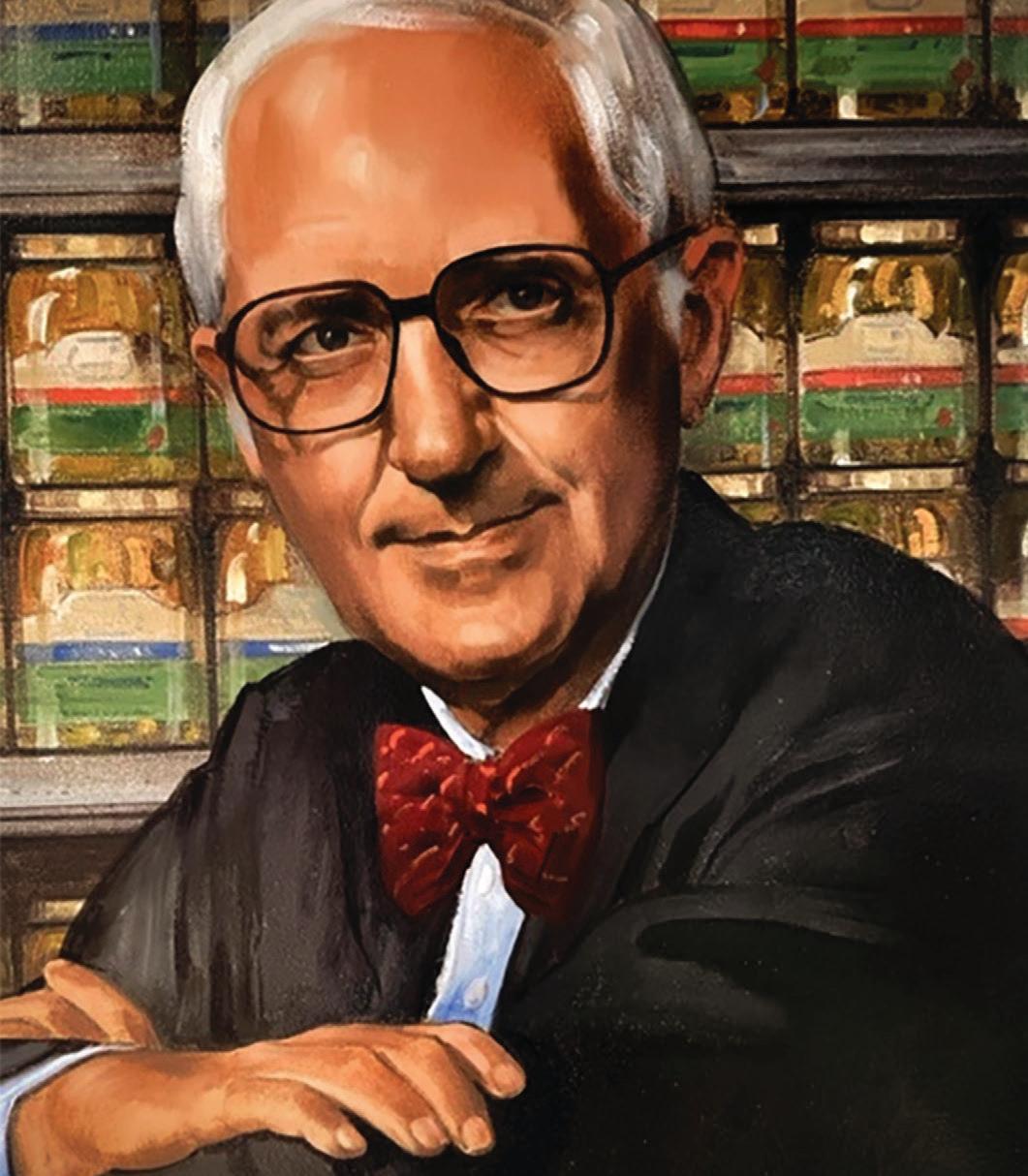
Like other business leaders, Vlasic influenced popular culture, as well. However, unlike Henry Ford’s “My Life and Work” or Warren Avis’s “Take a Chance to Be First,” Vlasic compiled “101 Pickle Jokes.”












For example: “What’s green and pecks on trees? Woody Woodpickle” or “Who’s the greatest player in pickle baseball? Dilly Mays.”






Indeed, the Vlasics delivered plenty of cheese in the early days, and grandson Bob kept laying it on. With annual sales hitting $102 million in 1978, he accepted $33 million in Campbell Soup Co. stock for Vlasic Foods. The deal included a seat on Campbell’s board, so he commuted to New Jersey for meetings, even serving as chairman from 1988 to 1993.
“He loved Campbell as much as anything,” says Bill Vlasic, one of Bob’s five sons with wife Nancy. Campbell spun off Vlasic Foods International in 1998; three years later, that entity changed its name to Pinnacle Foods. Conagra Brands acquired Pinnacle for $10.9 billion in 2018.
Jovny the stork, meanwhile, had a 2010 makeover that made him slimmer and more contemporary, but it flopped and the original made a comeback. “It’s the kind of thing my dad probably would have vetoed,” Bill says. “He was very proud of that legacy.”


COURTESY VLASIC FOODS INC. Closing Bell 90 DBUSINESS || March - april 2023
Grandson






































































































































































































































































 By Ronald Ahrens
By Ronald Ahrens


















 By
By














 Frank Venegas Jr. Detroit
Frank Venegas Jr. Detroit






















































 MARSHALL PRUETT
MARSHALL PRUETT



























 CEO
Sidle Entertainment, Detroit
CEO
Sidle Entertainment, Detroit
















 BY BILL DOW
BY BILL DOW













































































































































































































































































































































































































































































































































































































 BY RONALD AHRENS | JOSH SCOTT
BY RONALD AHRENS | JOSH SCOTT






































































































































 — Ronald Ahrens
— Ronald Ahrens













 BY DAN CALABRESE | MATTHEW LAVERE
BY DAN CALABRESE | MATTHEW LAVERE











 FACE-LIFT
FACE-LIFT















 BY TIM KEENAN
BY TIM KEENAN




































































 BY TOM MURRAY
BY TOM MURRAY





 SOUTHERN CUISINE
SLICE OF LIFE
SOUTHERN CUISINE
SLICE OF LIFE







































































































 WAYNE COUNTY – DETROIT
OAKLAND COUNTY – PONTIAC
MACOMB COUNTY – MOUNT CLEMENS
HON. BRIDGET MARY HATHAWAY 3rd Circuit Court
HON. JULIE A. MCDONALD 6th Circuit Court
HON. RICHARD L. CARETTI 16th Circuit Court
HON. JACOB J. CUNNINGHAM 6th Circuit Court
HON. DAVID A. GRONER* 3rd Circuit Court *Retired as of Jan. 1, 2023
HON. MICHAEL D. WARREN JR. 6th Circuit Court
HON. KATHLEEN M. MCCARTHY 3rd Circuit Court
HON. KAMESHIA D. GANT 6th Circuit Court
HON. VICTORIA A. VALENTINE 6th Circuit Court
HON. MARIAM BAZZI 3rd Circuit Court
HON. SHALINA D. KUMAR Eastern District of Michigan — United States District Court
HON. JULIE GATTI 16th Circuit Court
HON. PHYLLIS C. MCMILLEN 6th Circuit Court
HON. JOSEPH TOIA 16th Circuit Court
HON. DAVID J. ALLEN 3rd Circuit Court
HON. RAE LEE CHABOT 6th Circuit Court
HON. LORIE N. SAVIN 6th Circuit Court
HON. DONALD L. KNAPP JR. 3rd Circuit Court
HON. MARY ELLEN BRENNAN 6th Circuit Court
HON. EDWARD EWELL JR. 3rd Circuit Court
HON. JEFFERY S. MATIS 6th Circuit Court
WAYNE COUNTY – DETROIT
OAKLAND COUNTY – PONTIAC
MACOMB COUNTY – MOUNT CLEMENS
HON. BRIDGET MARY HATHAWAY 3rd Circuit Court
HON. JULIE A. MCDONALD 6th Circuit Court
HON. RICHARD L. CARETTI 16th Circuit Court
HON. JACOB J. CUNNINGHAM 6th Circuit Court
HON. DAVID A. GRONER* 3rd Circuit Court *Retired as of Jan. 1, 2023
HON. MICHAEL D. WARREN JR. 6th Circuit Court
HON. KATHLEEN M. MCCARTHY 3rd Circuit Court
HON. KAMESHIA D. GANT 6th Circuit Court
HON. VICTORIA A. VALENTINE 6th Circuit Court
HON. MARIAM BAZZI 3rd Circuit Court
HON. SHALINA D. KUMAR Eastern District of Michigan — United States District Court
HON. JULIE GATTI 16th Circuit Court
HON. PHYLLIS C. MCMILLEN 6th Circuit Court
HON. JOSEPH TOIA 16th Circuit Court
HON. DAVID J. ALLEN 3rd Circuit Court
HON. RAE LEE CHABOT 6th Circuit Court
HON. LORIE N. SAVIN 6th Circuit Court
HON. DONALD L. KNAPP JR. 3rd Circuit Court
HON. MARY ELLEN BRENNAN 6th Circuit Court
HON. EDWARD EWELL JR. 3rd Circuit Court
HON. JEFFERY S. MATIS 6th Circuit Court
























































